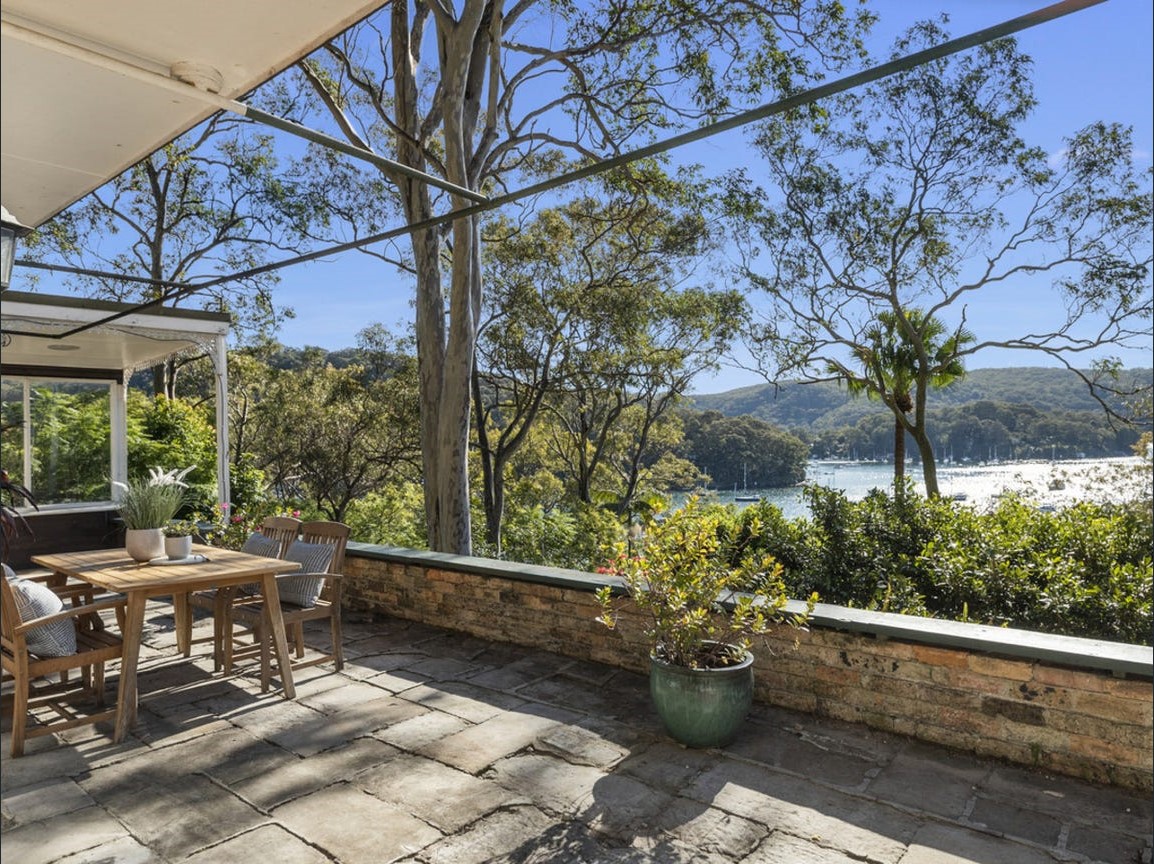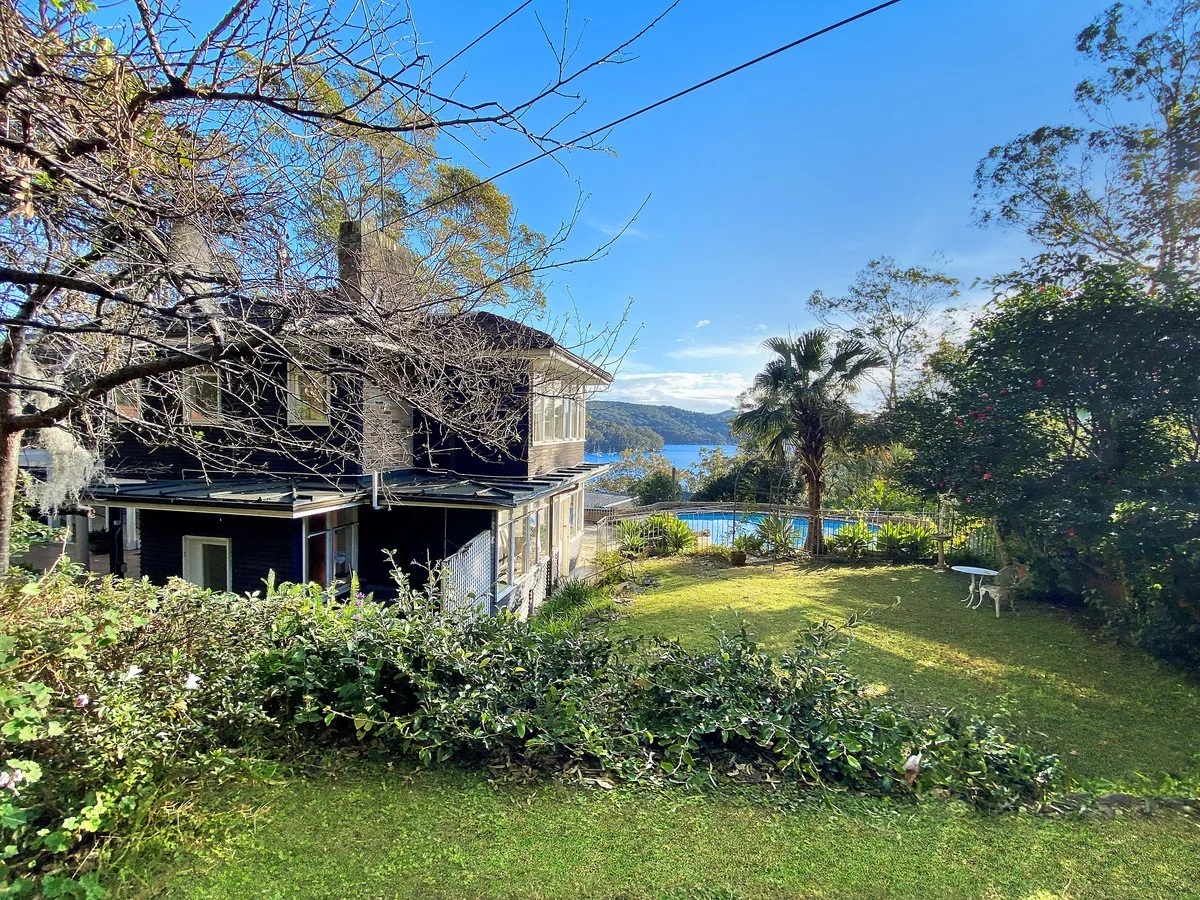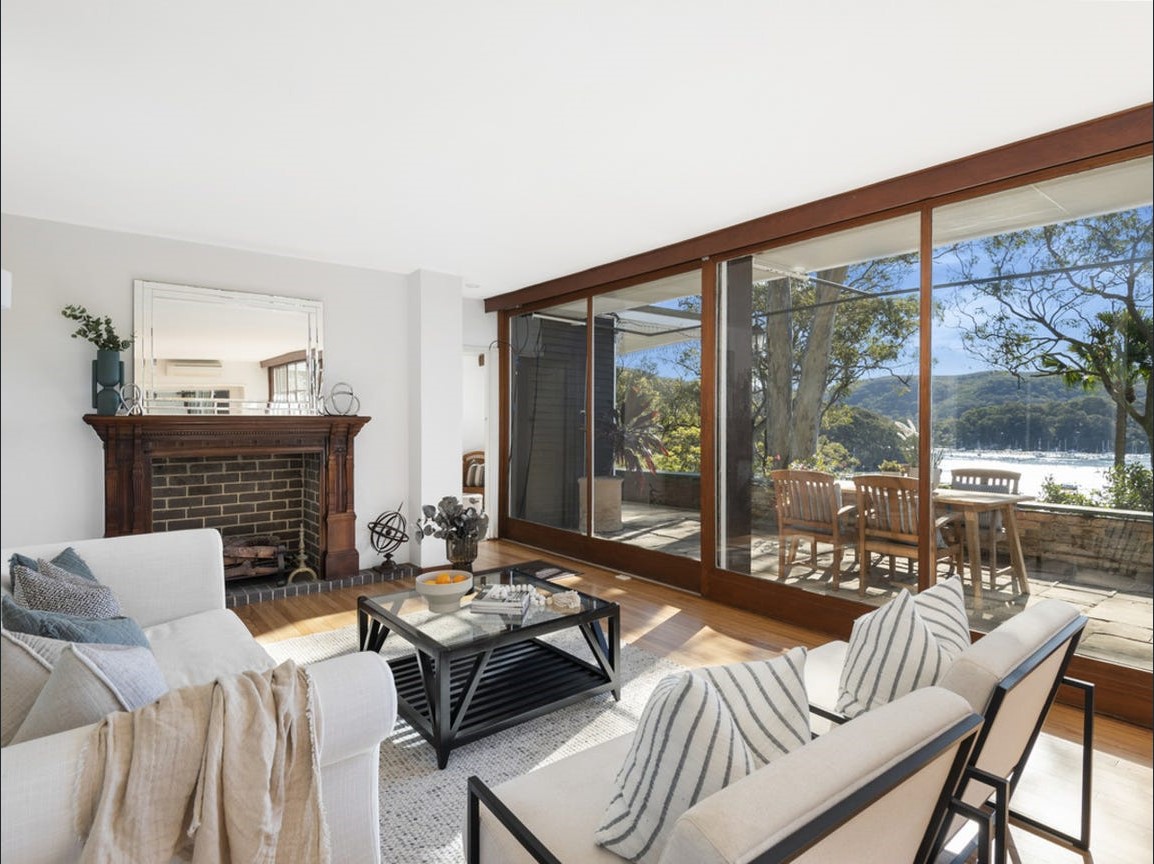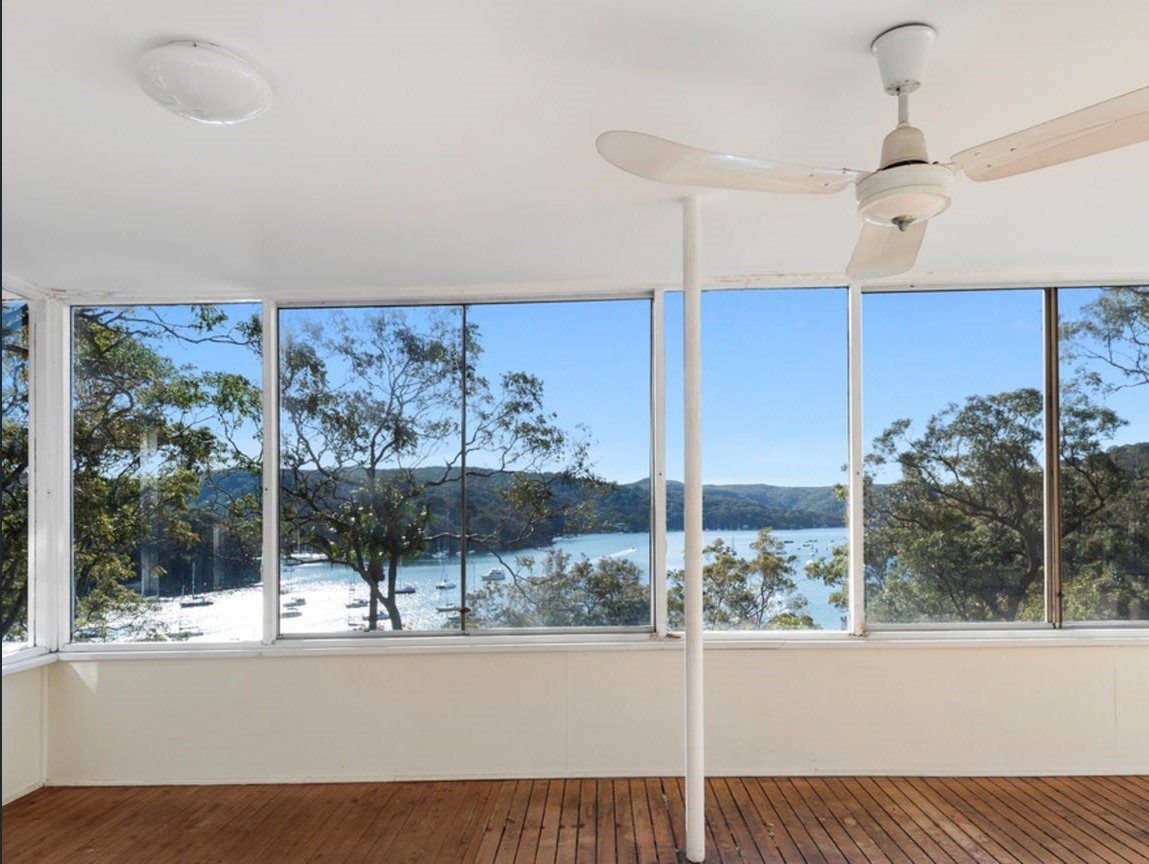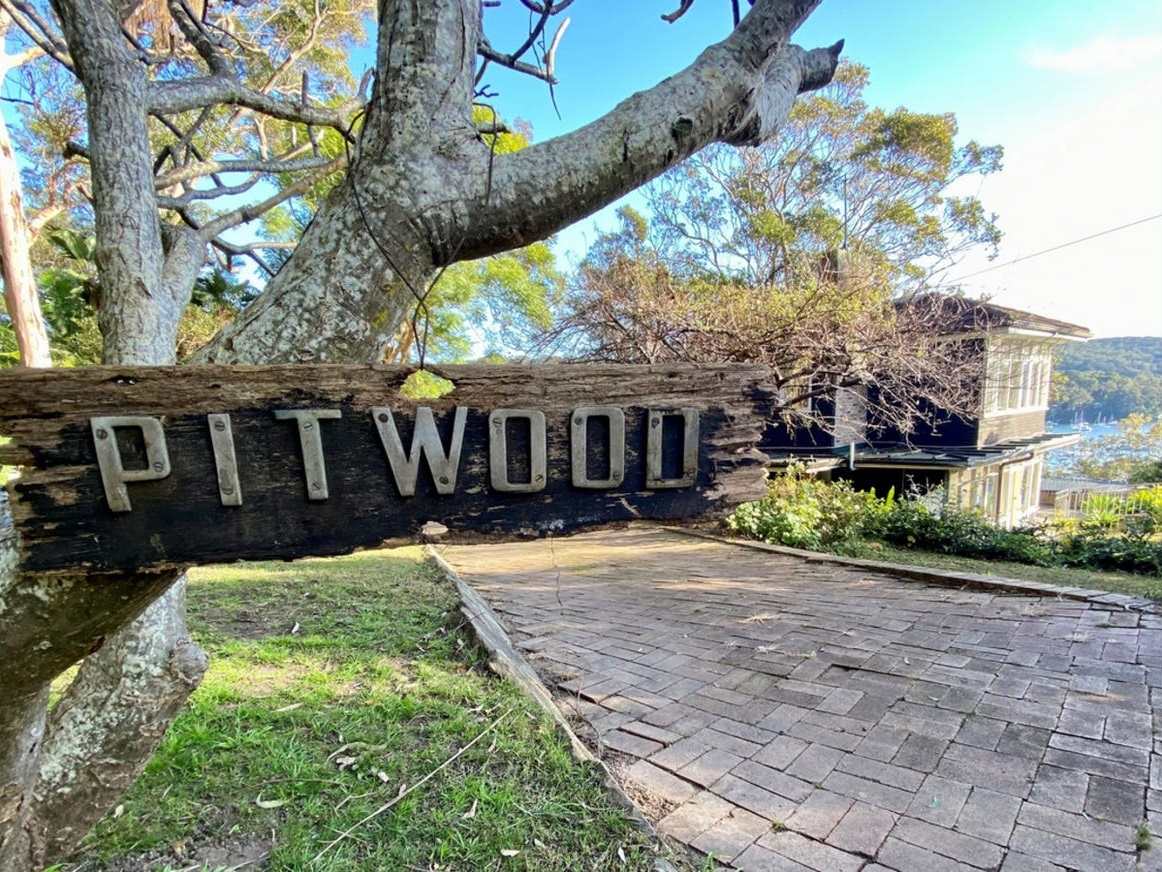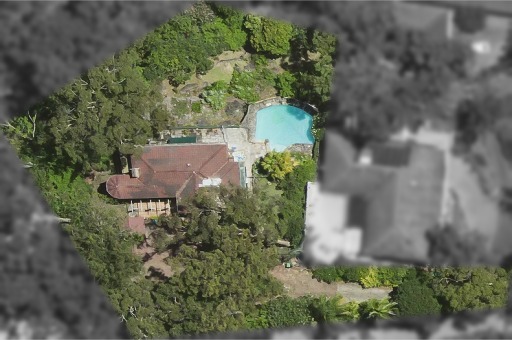'longa linga' at Church Point - the John Lander Browne Pre-WWII designed linear home for an aunt
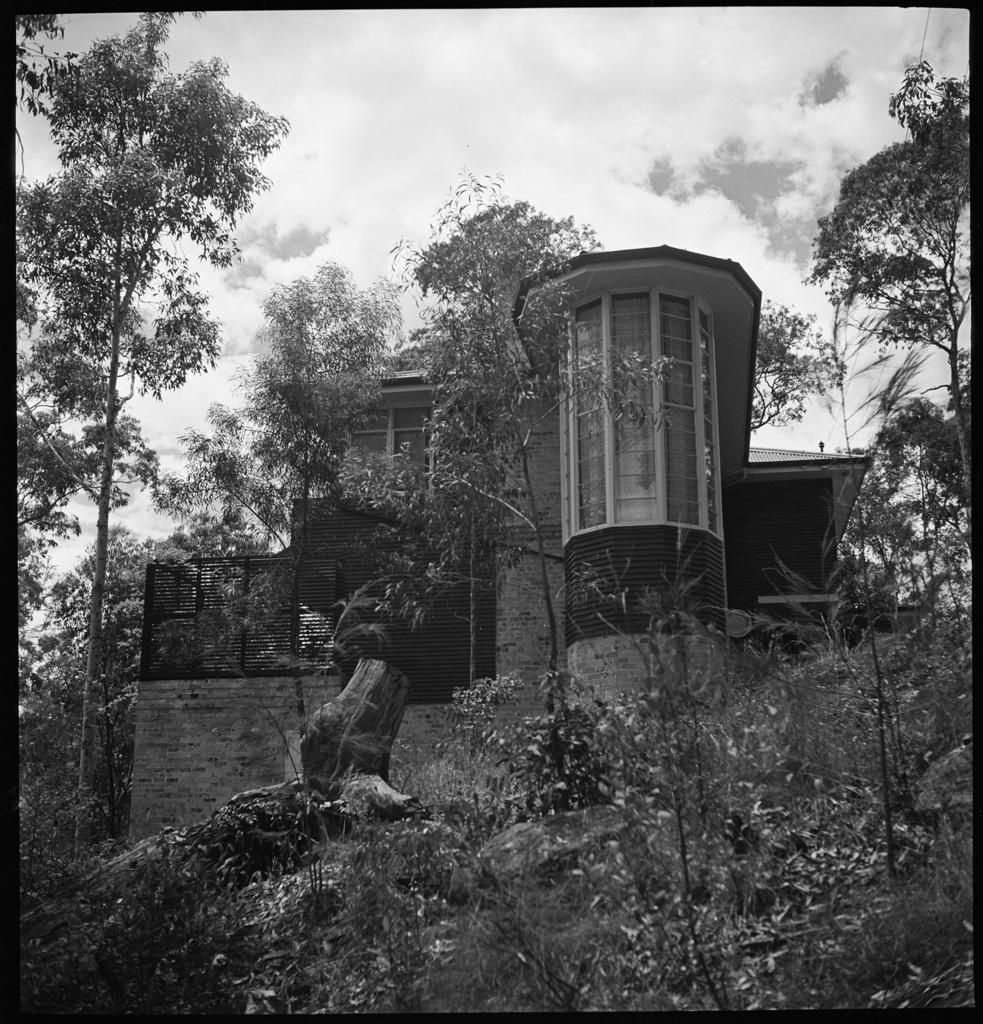
Church Point, [1930s-1980s] / photographed by Max Dupain- exterior views of a more contemporary house of brick and wooden slats with a faceted cylindrical feature down one side Additional information on envelope read, "Proof enc." and on reverse "Architect: J. Browne". These photos are likely to have been taken in 1950 when the property was placed on the market for sale.
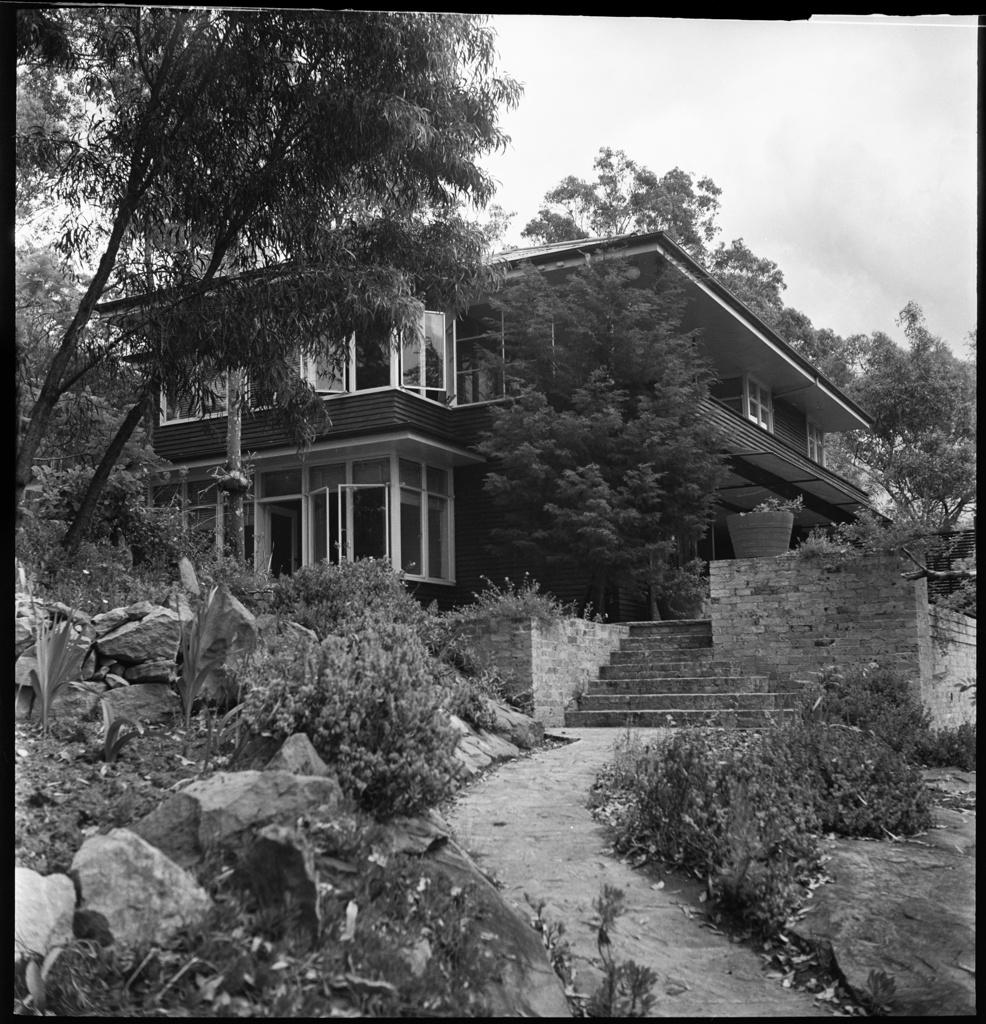
Designed and built for his wife's aunt, Lucy Richards née Lamplough, Longa Linga incorporates the ample amount of rooms required for a Summer residence and all year round comfort, along with most of the original land which was the last iteration of square metres by Lucy when selling off the over one acre block.
Church Point and parts of Bayview reflect what happened across Pittwater and Sydney itself since colonialization by Europeans - just a few owners of large sections of land until the 1950's-1960's and then the rapid escalation of building houses on smaller blocks that changed hands every generation or less.
Cut from Lot 1 of the lands sold after Dr. Tibbitts passed away, and from his holding at Church Point which in turn stemmed from the 66 acres granted to William Oliver which had been Charles Johnsons', the home overlooks McCarrs creek and looks north and west to the Ku-ring-gai National Park.
This was one of the first modern day houses built on the Church Point isthmus and a big change from the former weatherboard and tin huts that comprised much of the homes alongside the McCarrs creek track.
Lucy acquired Lot 1 on October 12th 1933 with the measurements being 1 acre 3 roods and 6 1/2 perches or 0.73 of a hectare or 1.793742906 acres or just shy of 7259.02 m2. The construction for Longa Linga would have commenced in 1938 or early 1939. In March 1940 Mr. Browne is asking Warringah Shire Council to help with providing access via the back of the property via current day ''Quarter Sessions Road'',
Warringah Shire Council Minutes of Meetings records:
21/9/1935: Mrs Lucy Richards requesting an estimate for gravelling and tarring the road to her property at Church Point. Resolved: That on receipt of £27, the Overseers estimate of the cost, the gravelling, rolling and tarring of the road be carried out.
12. H. L. Alford , 10/10/34, again/complaining of damage to his Cattle property at Church Point by straying stock. (Cattle Straying) 22/10/1934 Warringah Council Minutes
The Alfords were also responsible for an area that has become a green space. This was purchased by Warringah Council; Church Point Reserve J.J Maund and Kelyneck; submitting for completion by Council under Seal (a) Memorandum in respect to purchase from H L Alford Lots 15 and 15a, D.P. 10583, Church Points (b) the withdrawal of Caveat lodged by Council when the time payment agreement to purchase this Land was executed. Resolved, - That the Seal of the Council be affixed to these Council documents. (Crs. Hitchcock, Campbell) 18/03/1941 Warringah Council Minutes
6. Mrs. L. Richards, 15/11/37, requesting that as the road at Church Point is being re-surveyed for widening purposes, the Council remove the public lavatories in front of her residence, and place them on the ground purchased from Mr. Alford for recreation purposes. Referred to A. Riding Councillors for consideration and recommendation. 30/11/1937 Warringah Council Minutes
R. Graham Harmeston, Surveyor, 12/4/1939, submitting on behalf of Mrs. Richards, Plan of subdivision of Lot 1 DP 5810, McCarrs Creek, Church Point. Resolved: That the plan be approved as recommended by the Engineer.
19. J. Browne, 20/3/40, requesting that access from a reserved road at the rear be provided to his newly erected home on land McCarr's Creek Road, Church Point. Resolved,- That the Overseer's-report be adopted, and the substance of it conveyed to Mr. Browne. (Crs. Hitchcock, Butcher)
Lucy sells one acre, 34 and one half perches to Lawrence McDonnell of Manly, Medical Student in September 1944. She retains 2 roods 12 perches, or 2326.90m² at the back of Lot 1 and up the hill - some of this was sold off to provide accessway later on, reducing the holding to today's site wherein the property has 2,068m² of land.
Clearly there was some kind of building on Lot 1 prior to the new 'Longa Linga' being built as research into the Telephone books of those years, along with a change in her number, provides:
May 1934 – Mrs L Richards Longa Linga Church Point Y9122 – at Dulwich Hill prior to this.
November 1936 – Mrs L Richards Longa Linga Church Point Y9122
May 1939 – J L Browne Kurraba road Kurraba Point XA1091
May 1939 Mrs L Richards, Longa Linga Church Point XW9122
November 1939 - Browne J L 88 Eastern rd Tmurra
1954 phone book: J L Browne Architect – 11 Station street Pymble JJ2656
As the Warringah Shire Council minutes of meetings would indicate, the original may have been at the front of the block with a nice view of public lavatories and their visitors, while the Browne designed home was positioned at the rear when the second Longa Linga was built.
This photo, courtesy of Jack Moran (Taylor Made Escapes, Pittwater) and taken beside the then General Store, shows what was up the hill and directly beside the chapel at Church Point and shows a few homes through the screen of trees, although it may be just a little further west than is needed to see Lucy's home up the back of the block and what was at the front of the acre:
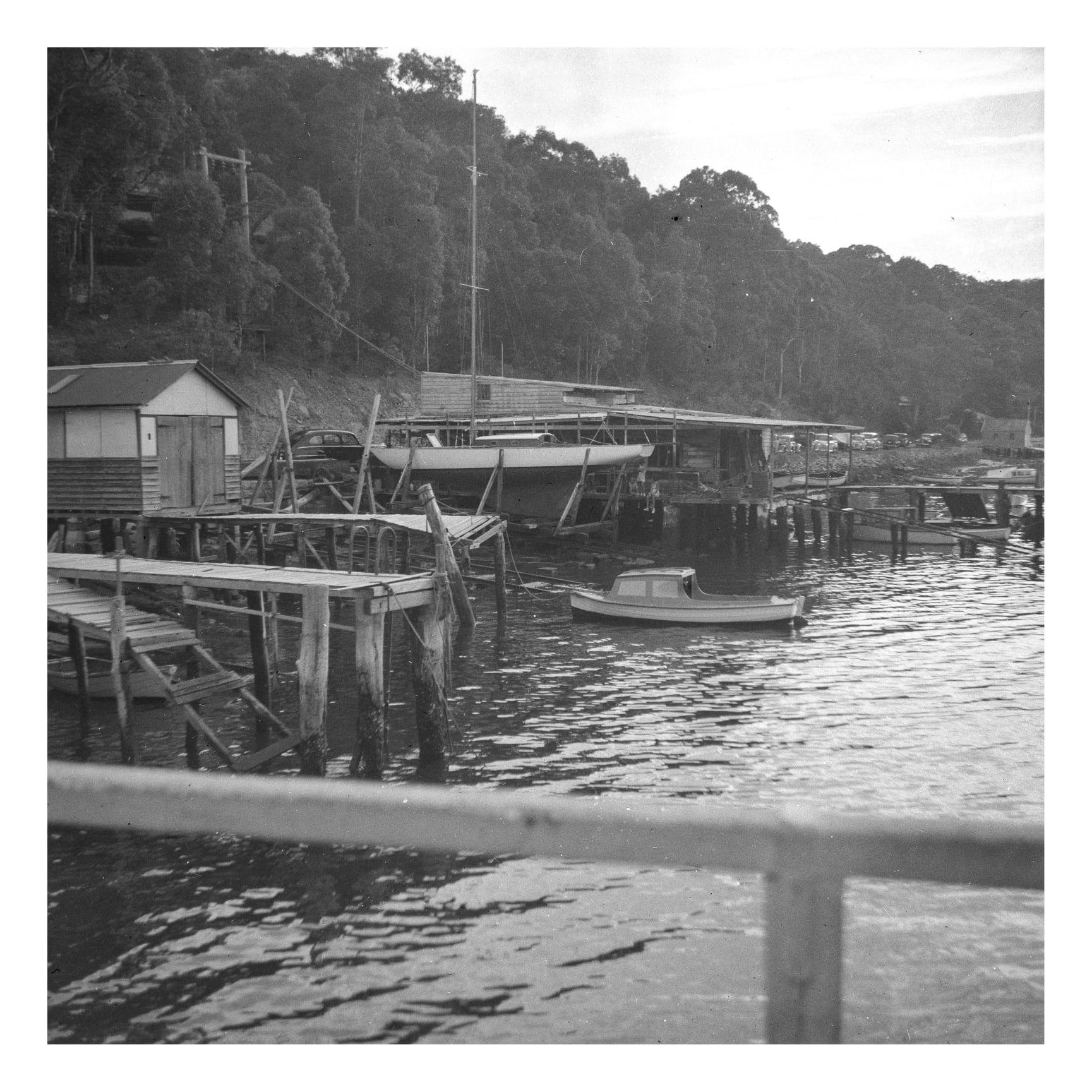
McCarrs Creek road circa 1945. Photo taken by Jack Moran's Grandfather. Jack says 'Our family now runs a charter company operating out of Palm Beach, Visit: https://www.instagram.com/taylormadeescapes
The 1930s in Australian Architecture, during the Great Depression, saw Art Deco became more subdued. New materials arrived, including chrome plating, stainless steel and plastic. A sleeker form of the style, called 'Streamline Moderne', appeared in the 1930s, featuring curving forms and smooth, polished surfaces. Although Mr. Browne worked mainly in brick and timber, and mainly on houses that would be homes for people in the suburbs, he obviously incorporated some elements of what was then fashionable, along with keeping one foot in the Edwardian features and influences on architecture he would have grown up with. He stayed away from the flat rooves so many of the houses designed to be 'modern' had then, Longa Linga showing it had a peaked roof to help with run off on what was a steep block, but went in for some of the 'liner' or 'ship at sail' for this Church Point home.
John Lander Browne was born on November 9th 1906 to George and Jennie (née Hogg - married 1893) whose father, Walter Hogg, was a builder. His early years were marked by tragedy. The second son of eight children born to the couple, five children would die between 1895 and 1905 followed by his mother when he was just over a year old, in December 1907. His father would take his own life ten years later through a gunshot wound, leaving a note for the North Sydney police and committing the act just a short way from the family home in Ross Street North Sydney, and leaving John and his two surviving sisters to be raised by relatives.
His father's death was widely publicised in newspapers, including that he was an Accountant with the NSW Railways Department who had just returned from a visit to England and was expected to return to work the day after he died. The event seems to have marked John Lander Browne's life ever after as he appears to have been a very private man who did not run any family notices in local newspapers, including his own marriage and the birth of children, or seek attention for his Architecture works, even though his designs and their realisation have stood the test of time and weather.
The homes he designed, those that could be found, all show a design drawn to not only let in sunlight and frame views, but also to provide privacy with outdoor areas set back a little or screening put in place. He also seemed to like those curves and bays for windows that became so popular during the 1930's.
Although these are a feature of the exterior of many a building during the 1930's - including the War Veterans home at Narrabeen - his were designed to maintain the privacy of those within those windows - not put them on display as other iterations of the curved window did.
The same April 1939 Minutes of a Warringah Shire Meeting that list Lucy Richards request record one of the vital parts of the Narrabeen War Veterans homes:

WAR VETERAN'S HOME.
Contract For First Section Let.
A contract has been let for the first section of the War Veterans Home at Narrabeen to A. W. Edwards, of O'Connell St., Sydney. The home, which has been designed to accommodate 100 War Veterans, has been constructed under the joint auspices of the State branch of the Returned Soldiers' League and the Legacy Club, the foundation stone being laid last Anzac Day by the Governor, Lord Wakehurst. The main block is of two storeys with a lower ground floor on the north side, and contains administration offices, recreation, billiard and dining rooms and a kitchen to serve 100, which will be the number the home will ultimately accommodate. The remainder of the buildings will be separate cottage blocks scattered around the attractive grounds of 11 ½ acres overlooking Narrabeen Lakes: the site was made available by the Warringah Shire Council. Two of the ultimate ten cottage blocks are being built under the initial contract, which it is understood is in the vicinity of £15,000. The work will be carried out to the designs and under the supervision of Fowell, McConnel and Mansfield, Architects. WAR VETERAN’S HOME. (1938, August 17). Construction (Sydney, NSW : 1938 - 1954), p. 8. Retrieved from http://nla.gov.au/nla.news-article222852571
The site for the War Veterans village at Narrabeen-Collaroy was actually built on land resumed by the Council from the Wheeler family, so 'made available' through forced resumption. James Wheeler was granted 50 acres of land 100 feet from the high water mark on Narrabeen Lagoon.
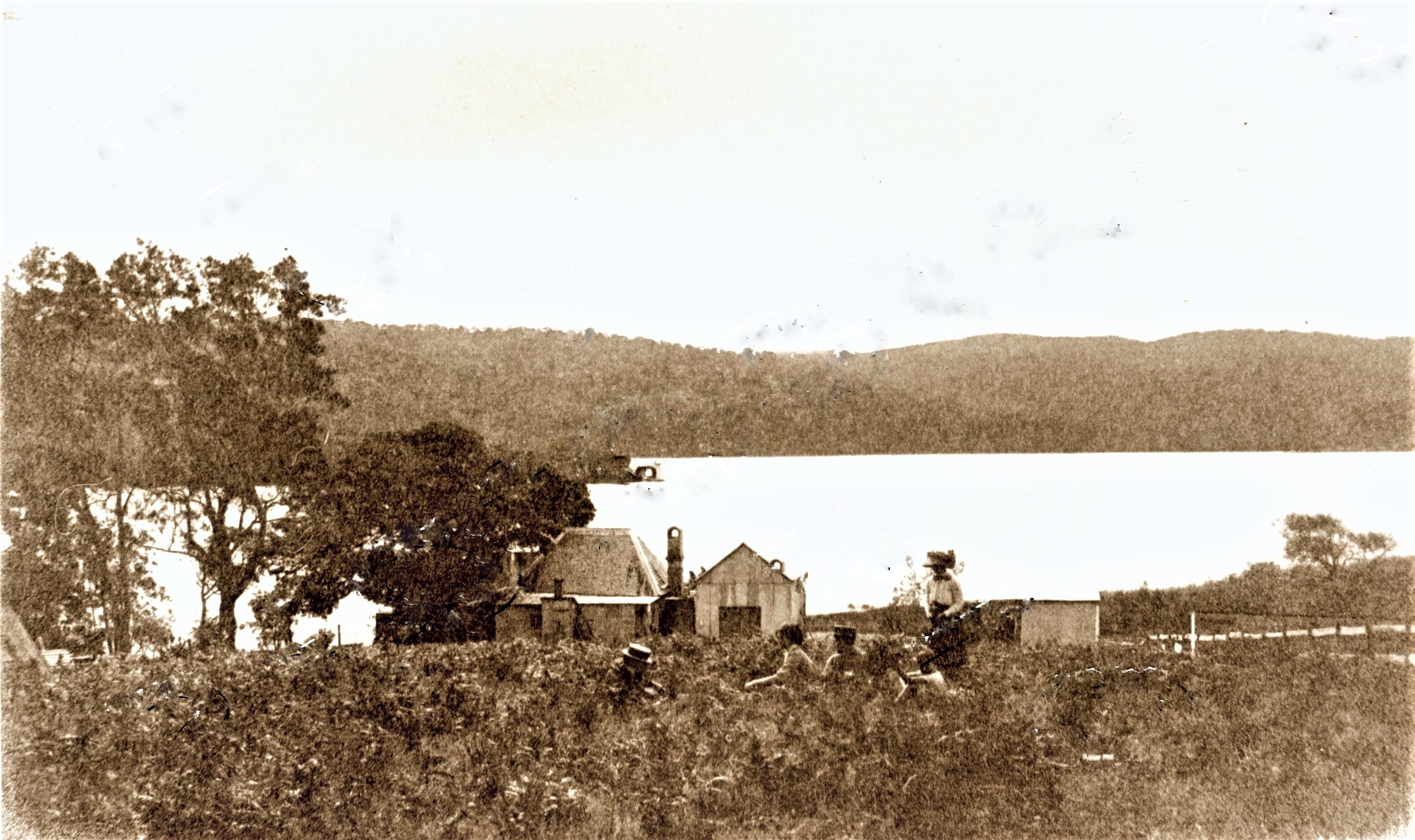
Wheeler's Homestead rear view - circa 1899-1913, courtesy State Library of NSW. Note the Boater hat - these became popular men's wear from 1894 on, reaching their peak in popularity during 1920's. The lady standing to right wears a Victorian era circa 1899 - 1913 wide brimmed hat that remained popular into 1910's.
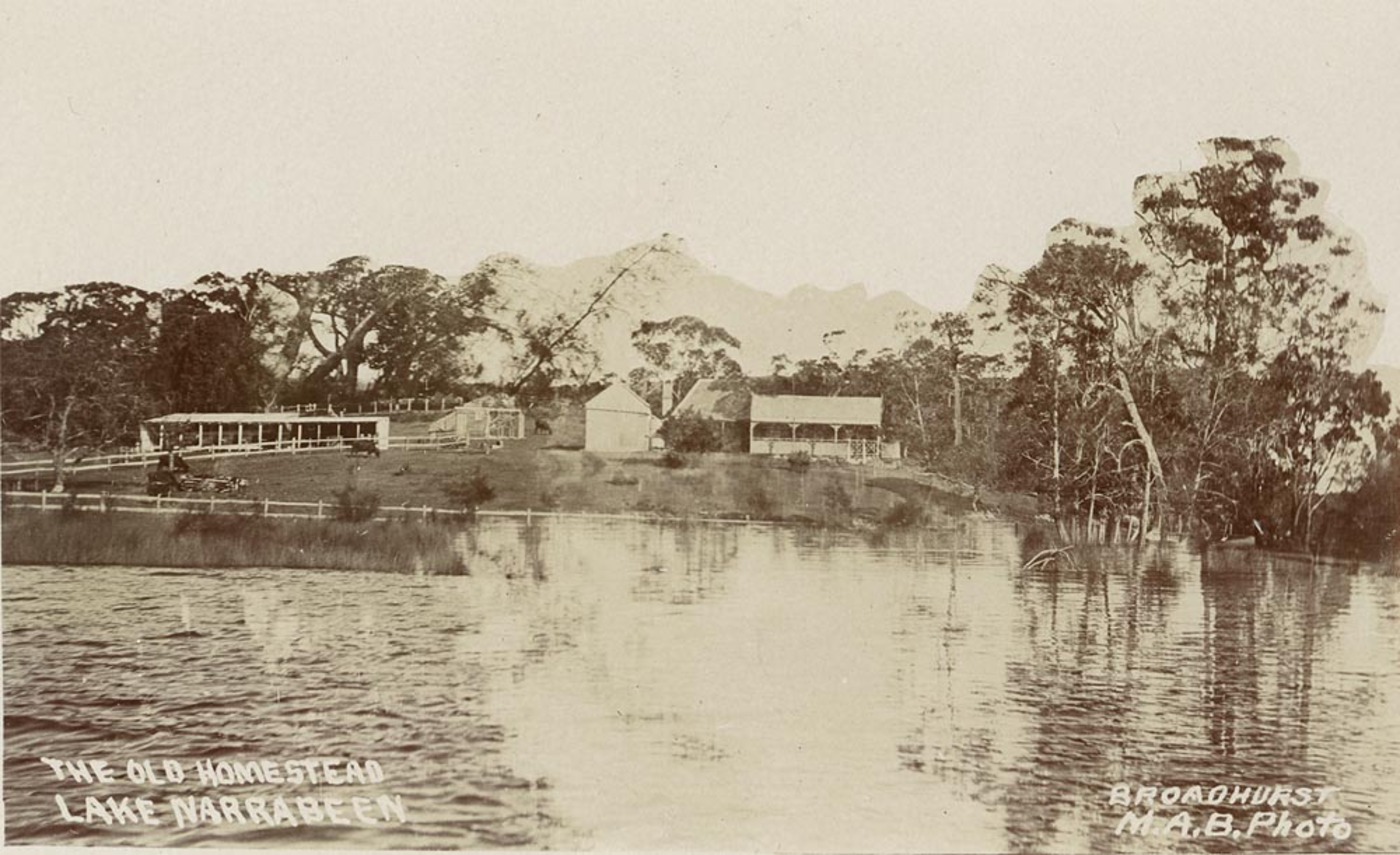
The Old Homestead, Lake Narrabeen, circa 1900-1927 from the Album 'Broadhurst Scenes of Narrabeen', Image no.: a116483, courtesy State Library of NSW.
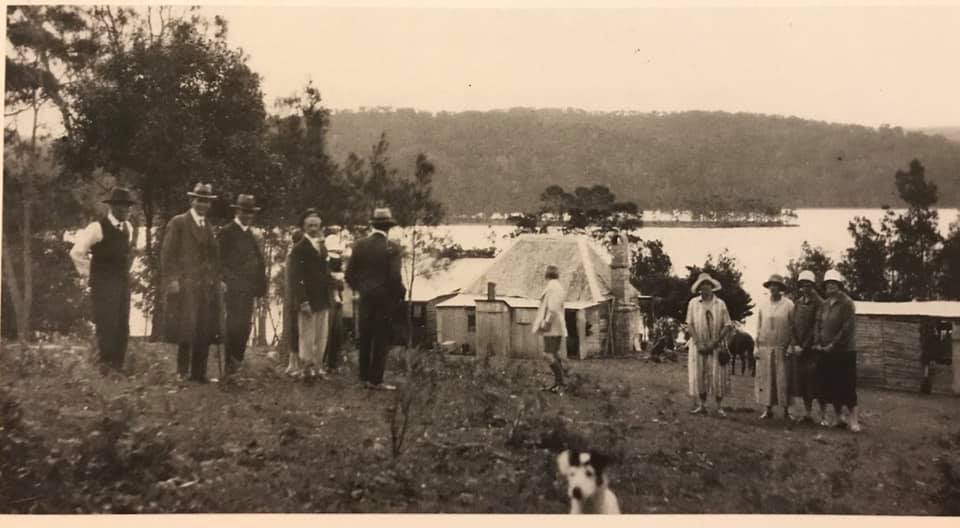
Photo: Members of the Manly Warringah & Pittwater Historical Society visit his house and shed on 9 May 1926.
WAR VETERANS' HOME, NARRABEEN, SYDNEY.
Architects: Fowell, McConnel and Mansfield. , Builder: A. W. Edwards.
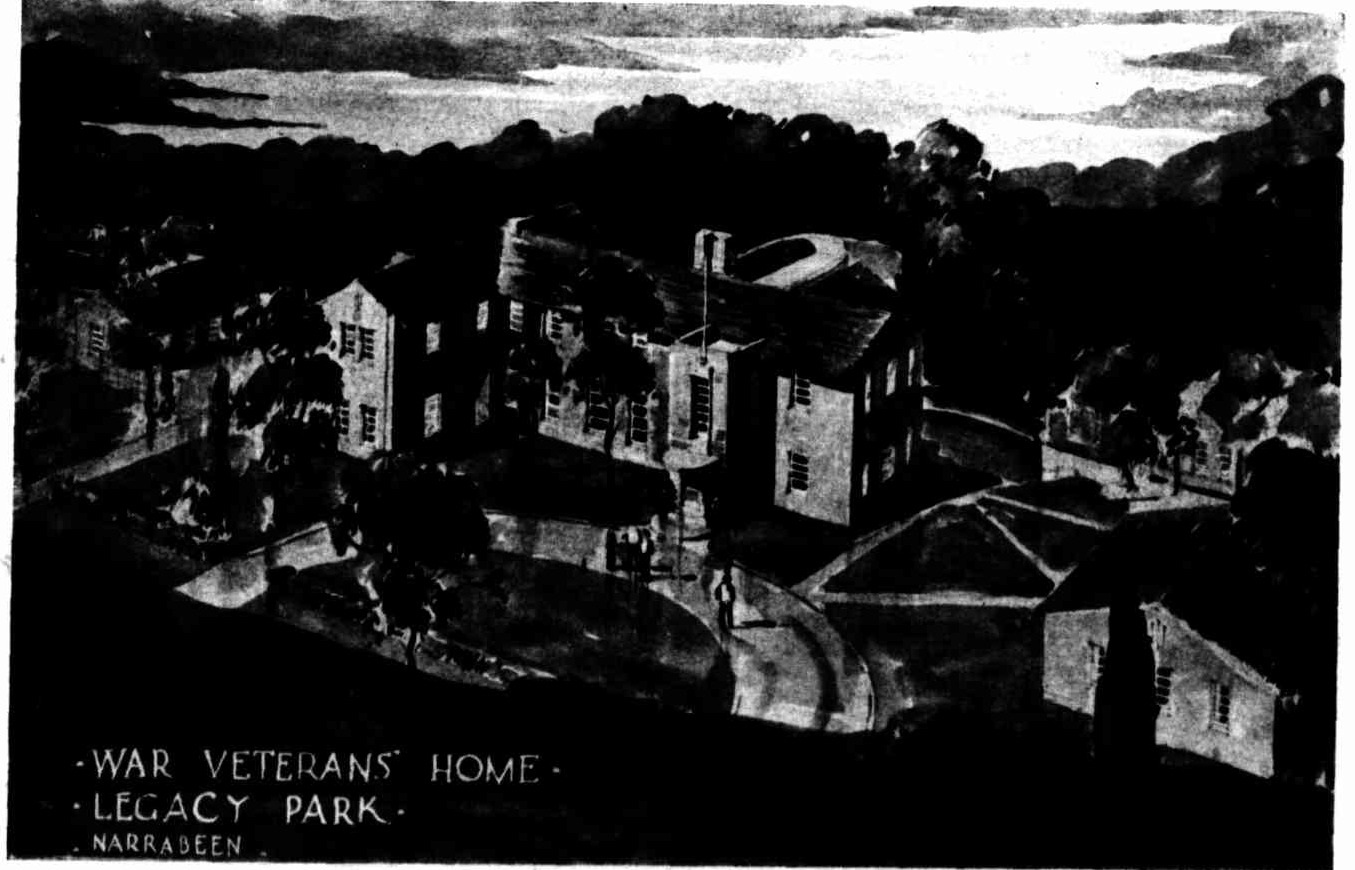
The home, which has been designed to accommodate 100 War Veterans, is being constructed under the joint auspices of the State branch of the Returned Soldiers' League and the Legacy Club, the foundation stone being laid last Anzac Day by the, Governor, Lord Wakehurst. The main block is of two storeys with a lower ground floor on the north side, and contains administration offices, recreation, billiard and dining rooms and a kitchen to serve 100, which will be the number the home will ultimately accommodate.
The remainder of the buildings will be separate cottage blocks scattered around the attractive grounds of 11 1/2 acres overlooking Narrabeen Lakes; the site was made available by the Warringah Shire Council. Two of the ultimate ten cottage blocks are being built under the initial contract, which it is understood is in the vicinity of £15,000. WAR VETERANS' HOME, NARRABEEN, SYDNEY. (1938, September 7). Construction (Sydney, NSW : 1938 - 1954), p. 5. Retrieved from http://nla.gov.au/nla.news-article222852810
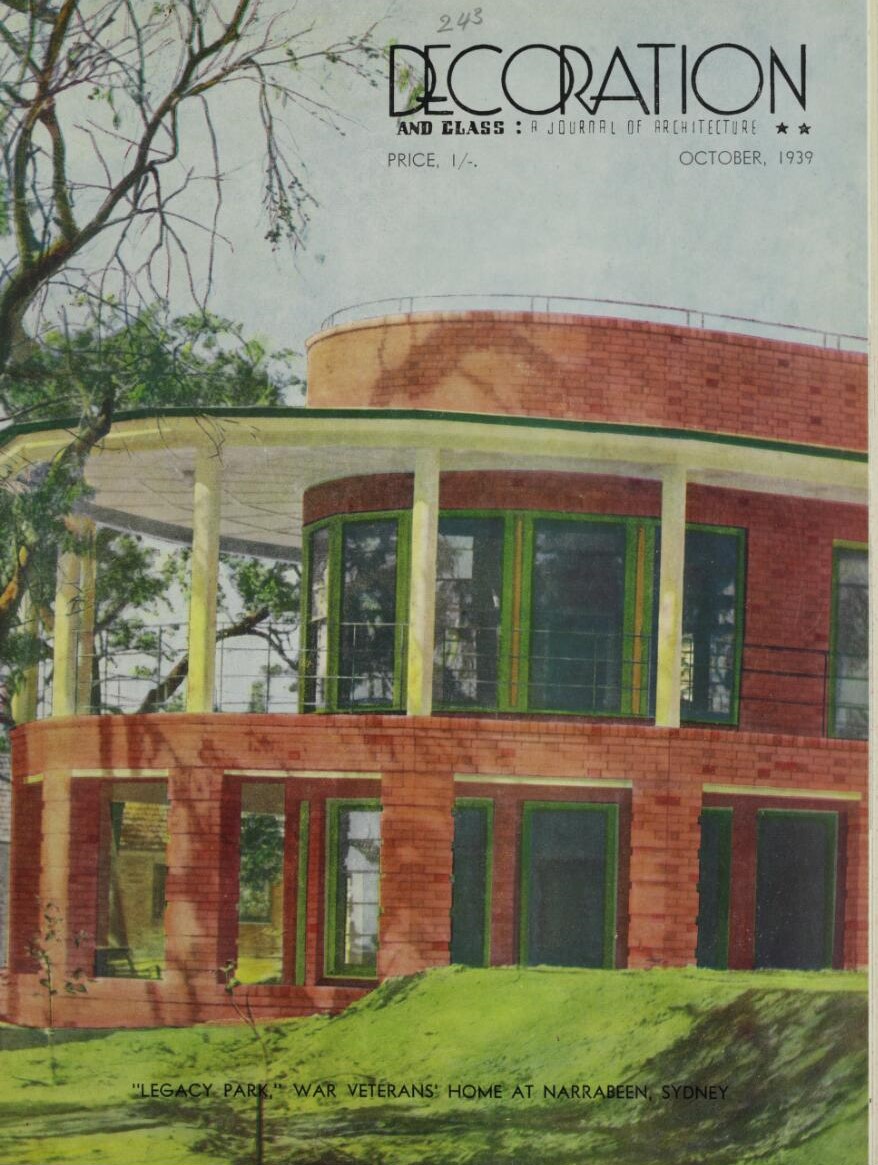
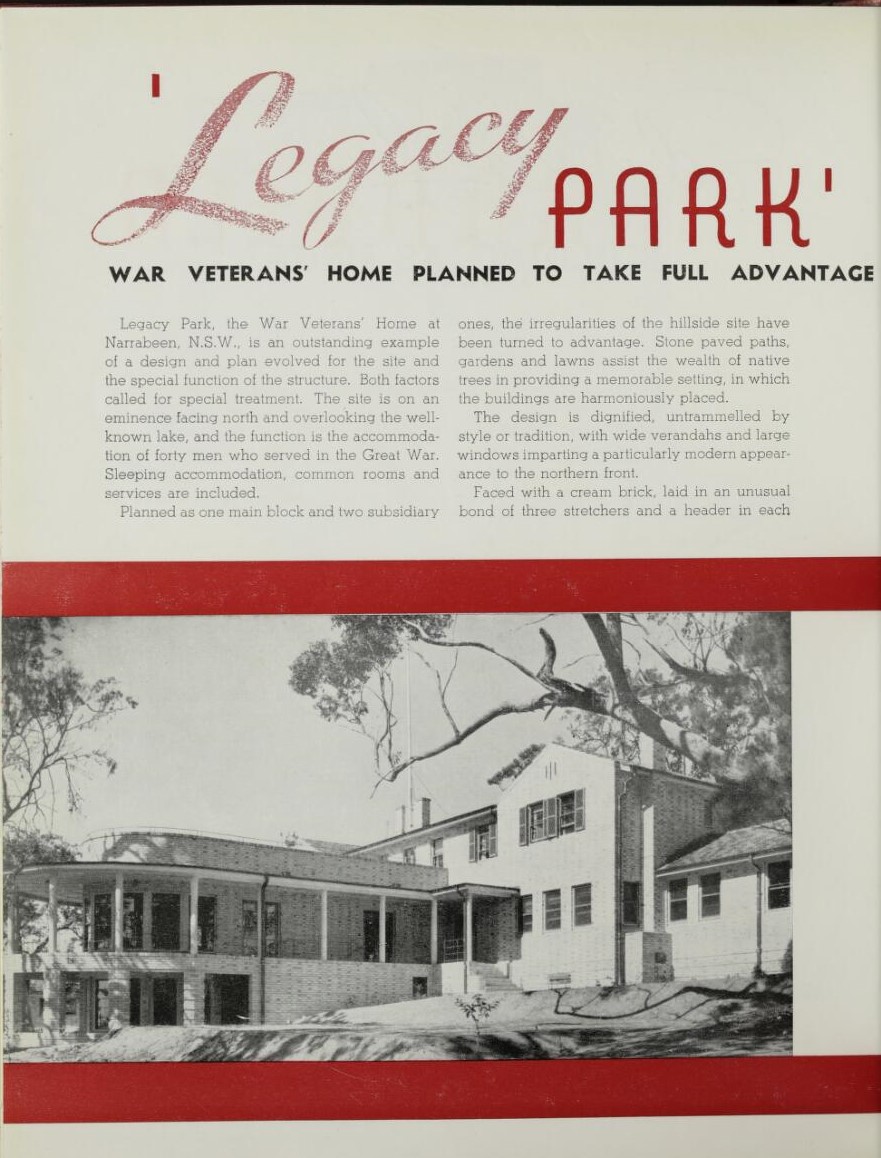
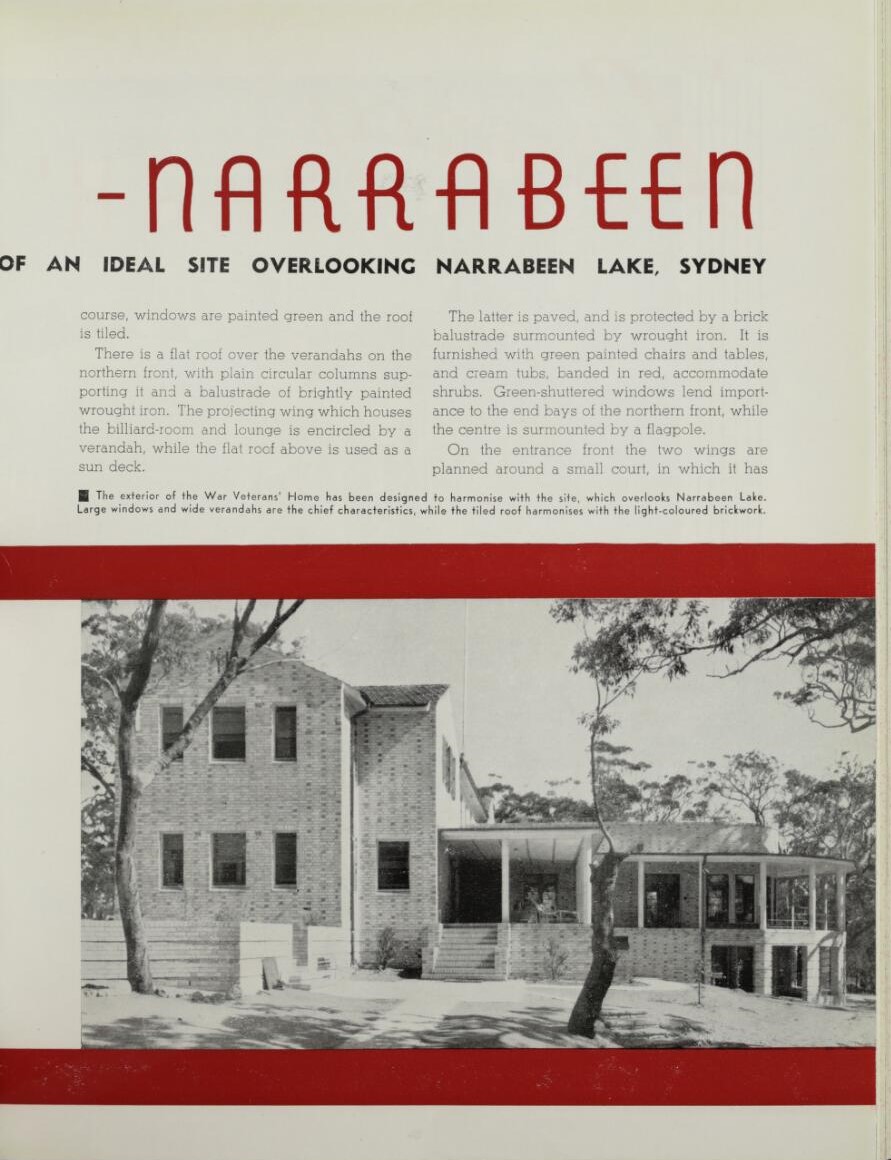
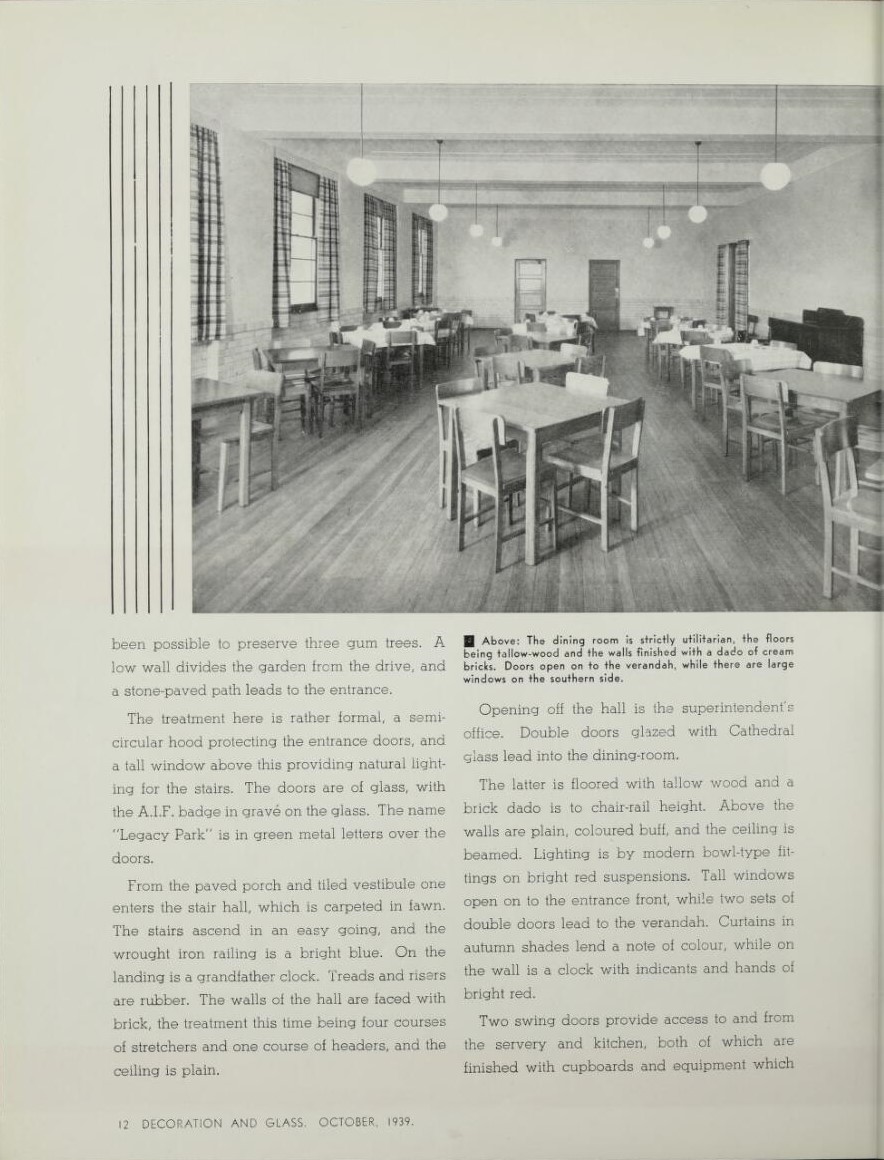
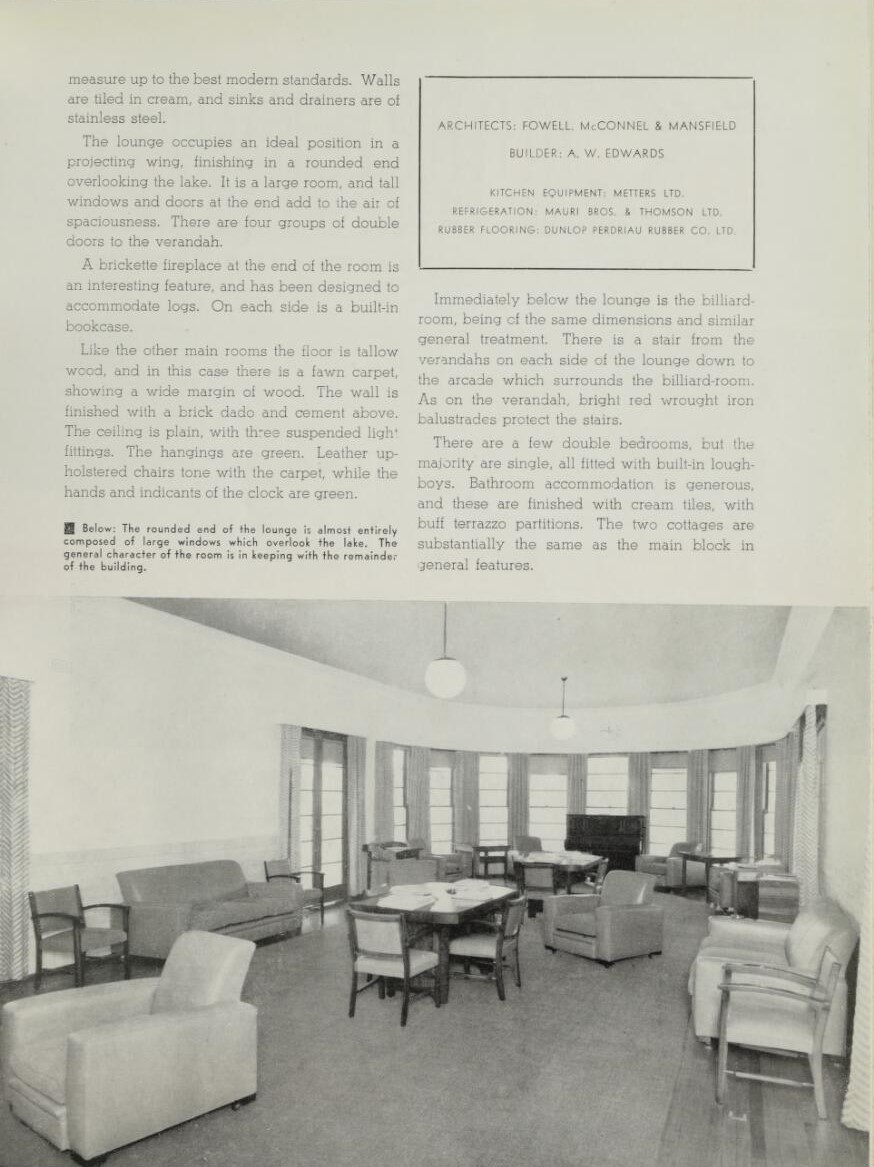
John Lander Browne would also have heard the discussions about the Minerva Theatre from the Lamplough family as the then partnership of Lamplough-Wharton were brokers for the shares, although apart from incorporating the 'modern' curved windows into his designs, along with opening out the spaces to bring the outside in, he stuck to building sturdy family homes.
NEW FILLIP TO CITY'S NIGHT LIFE
BIG VENTURE AT KING'S CROSS
Opera-hatted theatre patrons, escorting bejewelled and fashionably-attired women, will soon become regular features of the night life of King's Cross. Two new theatres, a roof restaurant, cabaret, and other attractions will be in operation by the middle of next year, when a comprehensive building scheme in Macleay and Orwell-streets is completed.
The venture, projected by Minerva Centre Limited, will do much to remove criticism that Sydney lacks night life, and the public attractions that a city of its size should have. The object of the company is to construct two theatres on nearby sites.
One, which will be named the Paradise, will be an elaborate structure with large seating accommodation designed for staging musical comedies, spectacles, and ballets. The other theatre, the Minerva, will be suitable for plays, revues, and similar presentations.
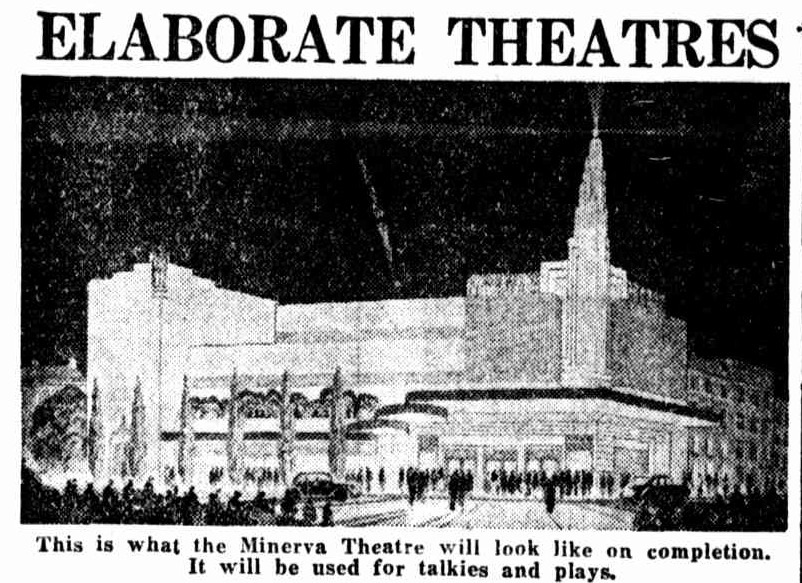
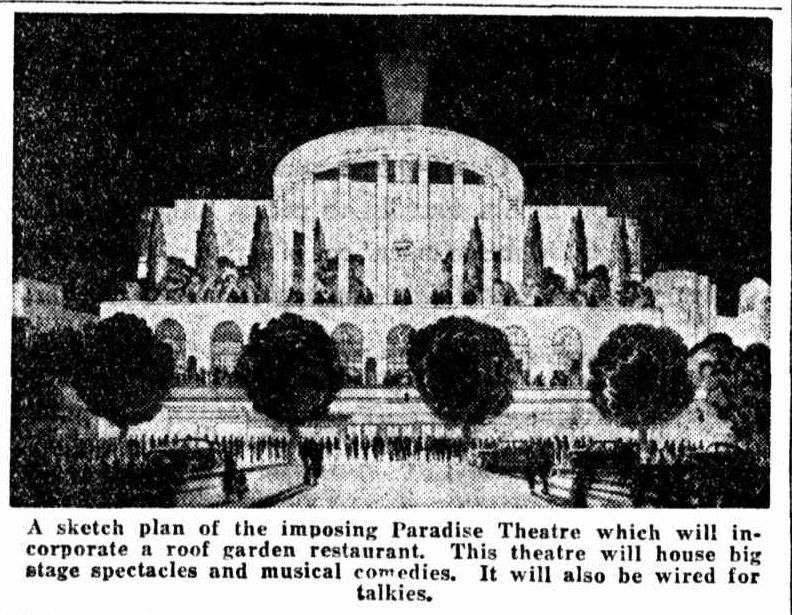
Fitted For Films
Both theatres will be equipped for talking pictures, but the policy of the company is to have the Paradise or the Minerva always at the disposal of "flesh and blood" shows that may ' book a season. Both theatres will be a revelation : In graceful architecture.
A roof restaurant catering for dinners and after-theatre supper parties 1 will be provided in conjunction with : the Paradise theatre, but the restaurant and cabaret section will be detached from the theatre proper.
The whole of the Issue of 50,000 ordinary shares of £1 each, offered In the prospectus, have been underwritten by Messrs. Lamplough and Wharton, members of Sydney Stock Exchange. The directors of the company are David Nathaniel Martin (managing director. Imperial Theatres Ltd., Liberty Theatre), Norman Lethbridge Cowper (solicitor), John Alexander Carpenter (company director), and James Ian Blomfield Dickson (chartered accountant). The architect is Mr. C. Bruce Dellit: solicitors. Messrs. Allen, Allen, and Helmsley; auditors, Messrs. Flack and Flack; and the secretary, Mr. Kenneth B. Thompson. NEW FILLIP TO CITY'S NIGHT LIFE (1937, September 12). The Sun (Sydney, NSW : 1910 - 1954), p. 9 (News Section). Retrieved from http://nla.gov.au/nla.news-article229445102
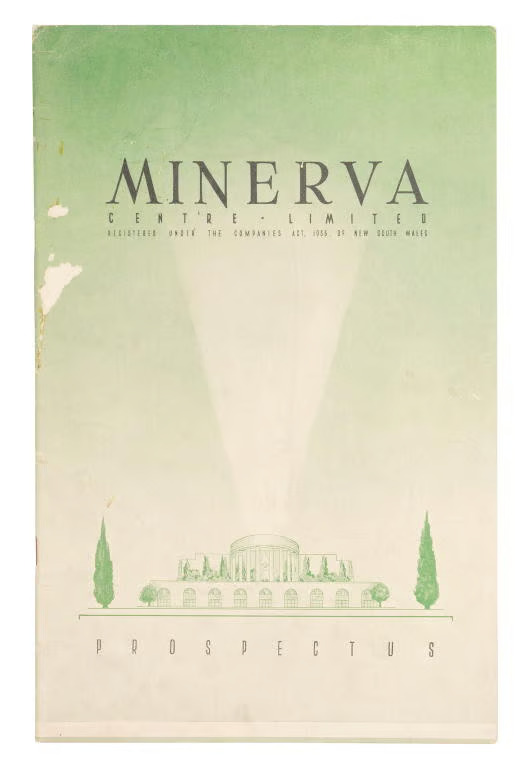
1937 Lamplough and Wharton propsectus
CAUSES' IN No. 2 COURT.
(Before Mr Acting Justice Ferguson and jury. )
TRANSACTION IN SHARES
A verdict was given for the plaintiff for the full amount claimed, £175/9/, in the action brought by Thomas Vincent Healy, stock broker, against John Richard Lamplough and Gordon Douglas Wharton, carrying on business as Lamplough and Wharton, stock brokers. The claim arose out of an arrangement under which the plaintiff alleged he had agreed to purchase in his own name and with his own moneys shares in a company known as Minerva Centre, Limited, and to hold them for the benefit of the defendants. Plaintiff alleged that the defendants had promised him that when he requested them to do so they would accept a transfer of the shares into their names and would reimburse him, and that he purchased the shares, but the defendants later refused to accept the shares or to reimburse him for them. The defence was a denial that any promise had been given to do as the plaintiff alleged or that any promise had been broken.
Mr. G. E. Barwick and Mr. Hugh Maguire (instructed by Messrs. Murphy and Moloney) for the plaintiff; Mr. M. F. Loxton (instructed by Messrs. Stuart Osborne and Simpson) for defendants. CAUSES IN No. 2 COURT. (1941, March 25). The Sydney Morning Herald (NSW : 1842 - 1954), p. 4. Retrieved from http://nla.gov.au/nla.news-article17727361
SUPREME COURT.
(Before Mr. Acting Justice Ferguson and a jury.)
LAMPLOUGH AND WHARTON v. DAVIES.
John Richard Lamplough and Gordon Douglas Wharton sued Frederick George Scott Davies to recover moneys due under an agreement whereby the plain- tiffs were to finance the defendant in the purchase of shares which were required by the defendant to make him eligible for directorship in Minerva Centre Ltd. The plea was once of accord and satisfaction
The jury returned a verdict for £185,11/11 for the plaintiffs. Mr M F Loxton (instructed by Mr. V S Raves) for the plaintiffs and Mr. R. Maguire (instructed by Messrs. Murphy and Moloney) for the defendant. SUPREME COURT. (1941, March 27). The Sydney Morning Herald (NSW : 1842 - 1954), p. 4. Retrieved from http://nla.gov.au/nla.news-article17739358
The Minerva Theatre opened on 18 May 1939 on Orwell Street in Kings Cross. The following week Construction magazine published a photograph of the building illuminated at night and directed readers to notice:
…the design of the new theatre is very definitely of the contemporary style, window openings being entirely eliminated, a fact which, on reflection is a very logical development for a theatre where the light of day plays little part.
The Minerva Theatre was built in the inter-war functionalist style, which emerged in Australia in the 1930s. It was an evolution of art deco and art moderne styles and greatly influenced by American and European architecture of the 1920s and 1930s. The theatre's vertical massing, sweeping curves, stepped forms and horizontal lines symbolised progress and modernity and were considered appropriate for a venue of popular culture.
Report: Federated Builders' Association of Australia & Master Builders' Federation of Australia. (May 24 1939 edition). THE MINERVA THEATRE, SYDNEY AN INTERESTING DEVELOPMENT., Building : the magazine for the architect, builder, property owner and merchant Retrieved from http://nla.gov.au/nla.obj-357821619
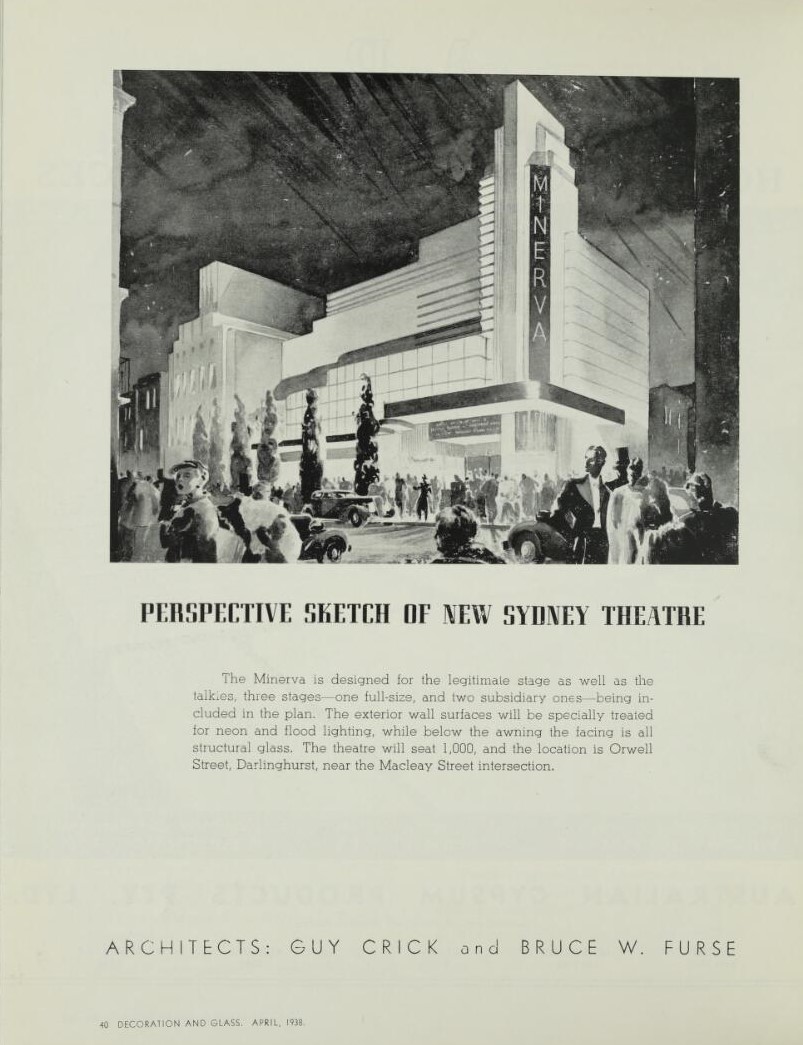 Theatre entrepreneur David N Martin conceived the Minerva Theatre and named it for the Roman goddess of wisdom. Martin owned the Liberty Theatre on Pitt Street and he set his sights on building the Minerva Centre, which was intended to comprise the Minerva Theatre on Orwell Street and Paradise Theatre on Macleay Street although the latter was never realised. In 1937 Martin formed the Minerva Centre Limited, appointed himself managing director, and purchased a block of land with frontage on Orwell Street and Orwell Lane for £10,500 ($21,000). He intended the Minerva Theatre to be designed for motion pictures and stage shows and in 1938 The Film Weekly reported it would 'be appropriate for drama, straight plays, revues, or celebrity concerts'.
Theatre entrepreneur David N Martin conceived the Minerva Theatre and named it for the Roman goddess of wisdom. Martin owned the Liberty Theatre on Pitt Street and he set his sights on building the Minerva Centre, which was intended to comprise the Minerva Theatre on Orwell Street and Paradise Theatre on Macleay Street although the latter was never realised. In 1937 Martin formed the Minerva Centre Limited, appointed himself managing director, and purchased a block of land with frontage on Orwell Street and Orwell Lane for £10,500 ($21,000). He intended the Minerva Theatre to be designed for motion pictures and stage shows and in 1938 The Film Weekly reported it would 'be appropriate for drama, straight plays, revues, or celebrity concerts'.
Martin commissioned C Bruce Dellit, architect of the New South Wales Anzac War Memorial and a great proponent of the art deco style, to design the Minerva Theatre. Dellit's preliminary designs depict a theatre grander than that which eventuated, with a sculptural façade by Rayner Hoff and mural by Norman Lindsay, both unrealised.
Architects Guy Crick and Bruce Furse supervised the design and construction of the Minerva Theatre, which opened in May 1939, seven months past schedule.
The Minerva Theatre combined horizontal and vertical volumes with rounded corners in an asymmetrical composition. The tower had vertical flutings and the name of the theatre on one side, and horizontal lines on the other. Small shops showcased their wares along the street façade. The stepped awning compensated for the fall in street level and the horizontal lines along the fascia gave a modern, dynamic look.
The colour palate was pale pastel-green colour scheme and the design showcased new materials. Laminex structural glass faced exterior walls and piers under the awning. Two curved ticket boxes made of structural glass and metal with chromium-plated grilles stood to either side of three pairs of entrance doors framed with Monel metal.
Dudley Ward designed and supervised the interior decoration, fibrous plaster details and decorative features, and external ornamental features and painting. Concealed Cleora fluorescent tube lighting accented the fluting on the arched foyer ceiling and emphasised the length of the fully carpeted and air-conditioned vestibule. At one end, a photomural above the entrance doors featured an aerial view of Sydney (taking the place of the planned Norman Lindsay mural). At the other end, a broad flight of stairs led to the upper lounge and entrance to the dress circle. Two pairs of flush panelled doors lead from the vestibule to the stalls and a third ticket booth was set behind a circular cutout in the wall.
Inside the theatre, a series of stepped transverse ribs crossed the 1000-seat auditorium. Each rib housed a concealed fluorescent tube that flooded the mediating spaces with red, amber and green light, while a fluted, curved frame around the stage concealed amber, blue and green lighting that changed colour during the audience's arrival. Other auditorium features included an off-gold crushed velvet curtain, rust-coloured exit curtains, autumn-tinted carpet, and an orchestra pit with the latest type of sounding board.
Next to the Minerva Theatre, the Minerva Café and Nightclub, built on the other side of Orwell Lane, featured a large semi-circular pediment with vertical lines, and a round, vaulted roof.
Australian and New Zealand Theatres Ltd., a division of JC Williamson Theatres Ltd, leased the new venue and staged plays until November 1939.
On the opening night of Thursday 18 May 1939, members of Australia's Wonder Theatre performed Robert E Sherwood's Pulitzer prize-winning play Idiot's Delight. The cast included American actress Lina Basquette and British actor Henry Mollison. The Sydney Morning Herald reported a crowd of more than 4,000 watched 'the arrival of an immaculately-dressed first-night audience for the presentation of Idiot's Delight… A spirit of carnival enjoyment ruled under brilliant flood lights'.
It was sold in 1948 to Metro-Goldwyn Mayer. MGM planned to own a number of suburban theatres in addition two major venues, all of which were to be renamed Metro and to this end, MGM officially renamed the Minerva Theatre in early August 1952. It has since been known as the Metro Kings Cross. - Dictionary of Sydney
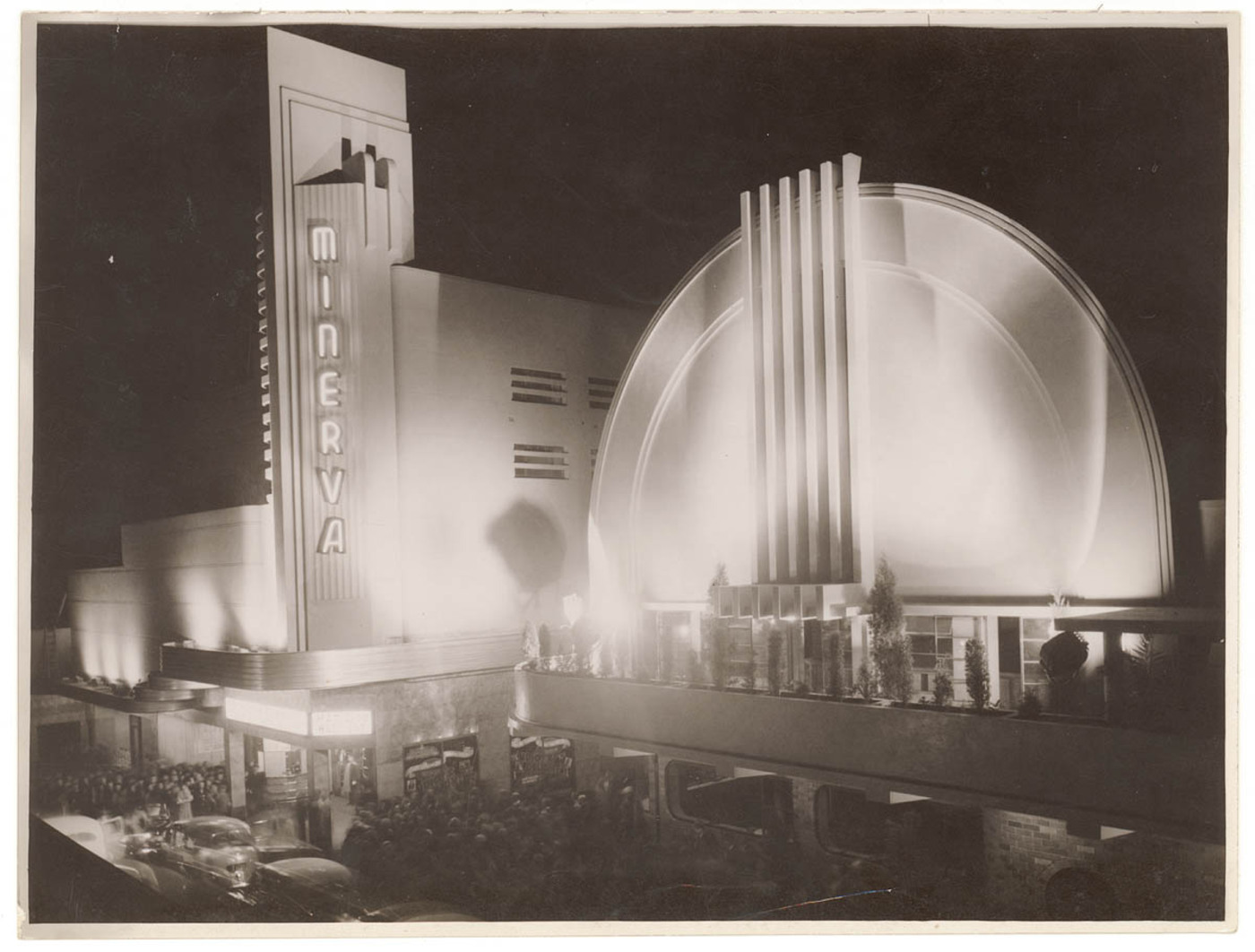
Opening night of the Minerva, photo courtesy State Library of NSW
John Lander Browne married Georgina Laura Lamplough in 1938, one of two daughters of John Richard and George (Georgie nee Grant) Lamplough. George Ann was born on October 28 1876, in Osnabruck, Stormont, Ontario. Georgie Ann became a teacher and went to South Africa as a missionary. It was there that she met John Richard Lamplough. They were married in South Africa on March 11 1907 at Dewetsdorp, Bloemfontein, Orange Free State, South Africa, and later moved to Australia where John was from. She made several trips back to Canada. Their daughter, Lucinda Eileen, was born in Canada in 1908, and daughter, Georgina Laura was born in England in 1915, and son, Robert Henry Grant, in England on January 16 1916. Another son, named after his father, was also born to the couple in Mosman on April 2nd 1910 and passed away in February 1943, at just 32 years of age.
Georgina's sister Lucinda Eileen married a Hobart gentleman (Boss-Walker) and was living interstate. Both girls attended PLC at Pymble and went on to Sydney University, gaining Teachers accreditations, among other subjects.
John Richard Lamplough is listed for decades as a 'Contractor' and Notices show up in old newspapers of his being a Builder and later worked as a sharebroker which he and his two sons appear to have done as their business, his younger son Robert Henry Grant being one of the founders of Lamplough and Malcolm after World War II, while his elder son, of the same name as he, was a partner in Lamplough and Wharton from 1930.
Browne's aunt-in-law's life was also marked with tragedy with her husband passing away before they had had any children and soon after they were married. Born the only daughter of Jeremiah and Lucinda (also spelt Lucenda) Lamplough, Lucy (1872-1949) and her brother John Richard Lamplough (1869- September 221946) had two older brothers, William (1868-?) and Henry (1866-1885 - aged 19 and 8 months) and one sister Emily R (1873-1875).
Jeremiah Lamplough formerly Lamplugh was born 31 October 1838 in Ruston Parva, Yorkshire, England, United Kingdom the fifth son of Jeremiah Lamplugh and Elizabeth (Brigham) Lamplugh. Jeremiah Lamplugh senior moved to Ruston Parva ( a small village on the southern edge of the Yokshire Wolds west of Bridlington) some time before 1834 when he appears on the electoral roll as entitled to vote, occupying at least 200 acres of land, the biggest farm in the village. Both he and his wife signed their marriage certificate which means they were literate, unusual for then.
By the time Jeremiah Jnr. is readying to leave for Australia his father's farm was listed as being of 501 acres. In 1863, Jeremiah and his brother John (born 1845), immigrated to New South Wales on the 'Ocean Empress'. He was described as being a miller, aged 22 and of Rushton (sic) Parva, Yorkshire, and that became his trade in New South Wales as well. He was sponsored by a Henry H J Pritchard, his brother-in-law.
He married an Irish girl, born Lucenda/Lucinda in 1828, in 1865, although the NSW BDM's records show some extreme misspelling:
2112/1865 LAMPLEIGH SAMUEL STEPHENS LUCENDA GOULBURN
Jeremiah died on 26 December 1887 at Goulburn, NSW, was aged 49.
Interestingly his son John Richard had a similar name for his home at Roseville, as is shown when he passes away, 3 years prior to Lucy:
NOTICE is hereby given, that after -the expiration of fourteen clear days from the publication hereof George Ann Lamplough, of Waimea road, Roseville near Sydney, in the State of New South Wales, widow, and Robert Henry Grant Lamplough, of 117 Pitt street, Sydney, in the said State, stock and share broker, the executrix and executor to whom probate of the will of JOHN RICHARD LAMPLOUGH, late of "Huston Parva," Roseville, near Sydney aforesaid named stock and share broker, deceased, was granted by the Supreme Court of New South Wales, in its Probate Jurisdiction, on the loth day of December. 1946. will APPLY to the Supreme .Court of the State' of Victoria, in its Probate jurisdiction, that its SEAL may be AFFIXED to an Exemplification of the said Probate. JAMES HALL & SONS, solicitors. 17 _Queen street. Melbourne. Advertising (1947, November 6). The Argus (Melbourne, Vic. : 1848 - 1957), p. 9. Retrieved from http://nla.gov.au/nla.news-article22518309
Lucy didn’t remarry. It seems likely she was living near her brother towards the end of her life and when he passed away, was cared for by his children, including niece Georgina, wife of John Lander Browne. Her telephone listing from 1934 on is at Longa Linga, Church Point.
RICHARDS— LAMPLOUGH.— February 7, at Goulburn, by the Rev. A. M. Tait, Albert Edward, third son of John Richards, Birmingham, England, to Lucy, only daughter of the late Jeremiah Lamplough. Goulburn. Family Notices (1893, February 15). The Daily Telegraph (Sydney, NSW : 1883 - 1930), p. 1. Retrieved from http://nla.gov.au/nla.news-article235946097
Husband’s death: a few years later:
DIED. RICHARDS. — At Eastgrove, on Christmas Day, ALBERT EDWARD RICHARDS, third son of JOHN and M. A. RICHARDS, of Birmingham, England ; aged 33 years. Family Notices (1896, December 29). Goulburn Evening Penny Post (NSW : 1881 - 1940), p. 2. Retrieved from http://nla.gov.au/nla.news-article98558072
Death. Mr A. RICHARDS, grocer, died at half-past 10 o'clock on Christmas night at the residence of his wife's mother, Mrs. Lamplough, of Eastgrove. Death was due to heart disease. Deceased had been suffering from nervous prostration for some time and on Wednesday last he completely collapsed, and continued in an unconscious state till he died.
He was only 33 years of age and he leaves a young wife. He had been a resident of Goulburn for upwards of ten years, being in the employ of Mr. Smith, grocer, of South Goulburn for some years, and afterwards being in partnership with Mr. Beyan of Auburn-street. The remains were interred in the Church of England cemetery on Sunday last.
Deceased was a Mason and a member of the Druids, and a number of brethren from both orders marched in front of the hearse. Canon Pritchard officiated at the grave, and the Masonic and Druids' services were also read. Death. (1896, December 29). Goulburn Evening Penny Post (NSW : 1881 - 1940), p. 4. Retrieved from http://nla.gov.au/nla.news-article98558030
Eastgrove was and is situated north of Goulburn, and is now a suburb of the same. Her mother passed away in 1921:
Obituary, MRS. LAMPLOUGH; AGED 93.
Mrs. Lucinda Lamplough, widow of Mr. Jeremiah Lamplough, died at her residence, Marrickville, on Sunday at the age of 93. Mrs. Lamplough was in good health up to the previous Sunday, when during the absence from the room of the person usually in attendance on her, she fell out of bed and sustained a shock. Except that her memory occasionally failed. Mrs. Lamplough retained her faculties to the end. The deceased lady was born in County Cavan, Ireland, in 1828 and came to Australia in 1847. After living in Sydney a few years she came to Goulburn where she resided off and on till 1913. Her connection with Goulburn thus covered, with intermissions, a period of about 60 years. She married in Goulburn, and her husband predeceased her by 34 years. Mrs. Lamplough came to Goulburn by coach, and had many interesting stories to tell of old Goulburn. She was a highly respected resident. The deceased is survived by one son — Mr. Richard Lamplough—and one daughter, Mrs. A. Richards, of Sydney. The interment took place on Monday in the Church of England old cemetery, Goulburn. Obituary. (1921, March 1). Goulburn Evening Penny Post (NSW : 1881 - 1940), p. 2 (EVENING). Retrieved from http://nla.gov.au/nla.news-article98936045
John Lander Browne graduated as an Architect on July 4th 1934. The Architects Roll for NSW gave his address as:
4th July 1934 – Browne, John Lander – No. 1 Englemere, Shell Cove Road, Neutral Bay. ARCHITECTS' ROLL OF NEW SOUTH WALES FOR YEAR 1935. (1935, January 25). Government Gazette of the State of New South Wales (Sydney, NSW : 1901 - 2001), p. 373. from http://nla.gov.au/nla.news-article224745840
4th July 1934 – Browne, John Lander – 88 Eastern Road, Turramurra. ARCHITECTS' ROLL OF NEW SOUTH WALES FOR YEAR 1939. (1939, January 27). Government Gazette of the State of New South Wales (Sydney, NSW : 1901 - 2001), p. 472. Retrieved from http://nla.gov.au/nla.news-article222079118
The Church Point of the late 1920s and early 1930's was a place changing from orchards and shacks with a dirt road access to a place to go to. The NRMA backed them up in:
Congestion at Church Point
The popularity of Church Point, on Pittwater, causes the narrow roadway to be heavily congested on fine week-ends, says the N.R.M.A. 'Many cars are parked from early morning to nightfall, the occupants meanwhile engaging in launch tripe. It has been suggested to the N.R..M.A. that the mud flat at the point might be filled in so as to provide an area for their use on which a parking charge could be made. The N.R.M.A. is approaching the Warringah Shire Council in the matter. Congestion at Church Point (1928, November 29). The Cumberland Argus and Fruitgrowers Advocate (Parramatta, NSW : 1888 - 1950), p. 22. Retrieved from http://nla.gov.au/nla.news-article107103923
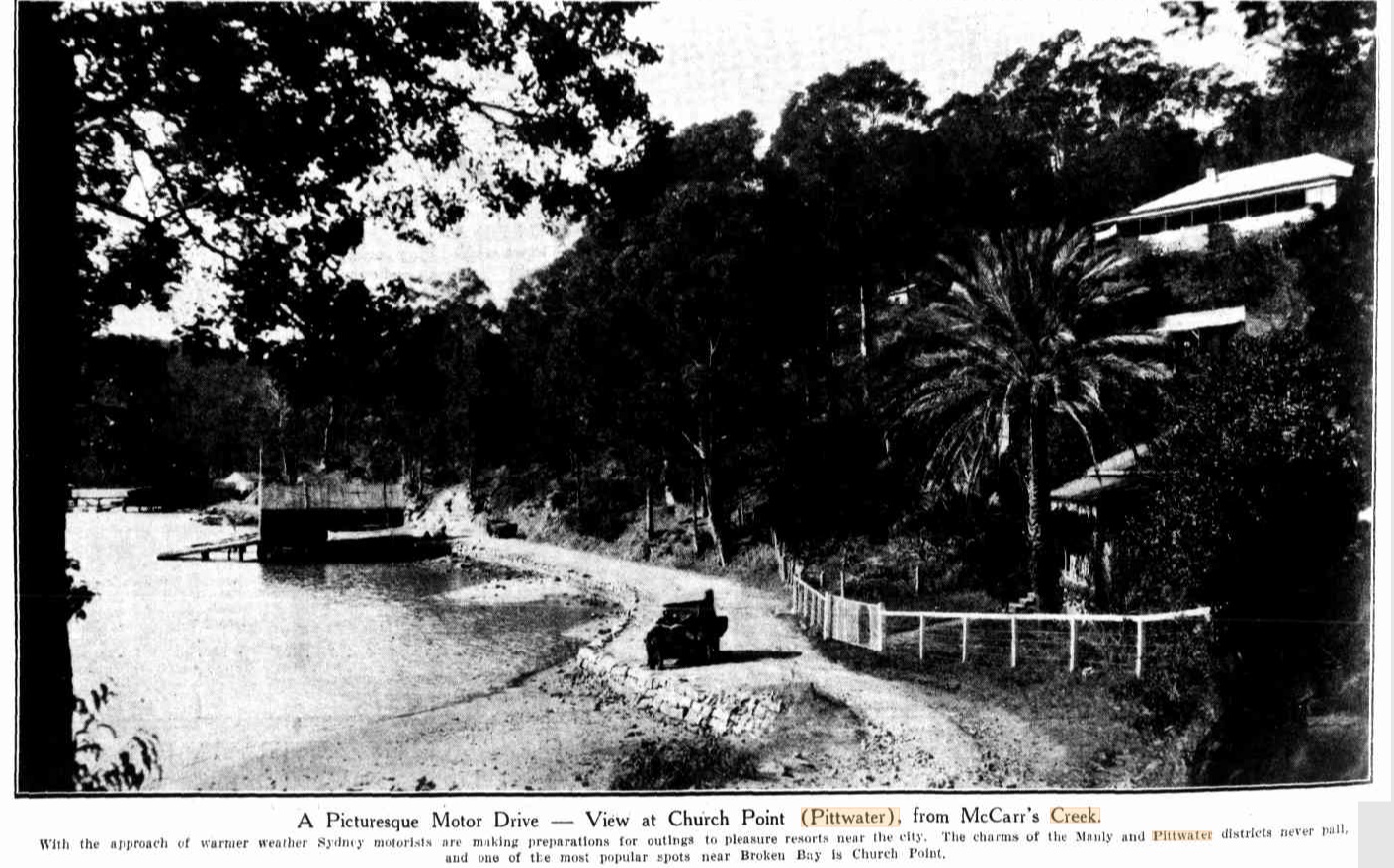
With the approach of warmer weather Sydney motorists are making preparations for outings to pleasure resorts near the city. The charms of the Manly and Pittwater districts and one of the most popular spots near Broken Bay is Church Point. MOTORING (1929, August 28). Sydney Mail (NSW : 1912 - 1938), p. 45. Retrieved from http://nla.gov.au/nla.news-article160395048
By 1930 Item 19 of Warringah Shire Council Minutes of Meetings records: Bayview & Church Point Progress Assoc. 10/5/30. .. . Suggesting that the sandy-mud flat adjoining Wymark's new store at Church Point be reclaimed for the purpose of providing a parking area. Referred to the Works Committee for report.
In 1936 £ were set aside to acquire land and begin infilling near the wharf, most likely that section between the Pasadena and the General Store known today as Thomas Stephens Reserve.
Mostly Church Point was known for its quietness:
CHURCH POINT.
A Pittwater Beauty Spot.
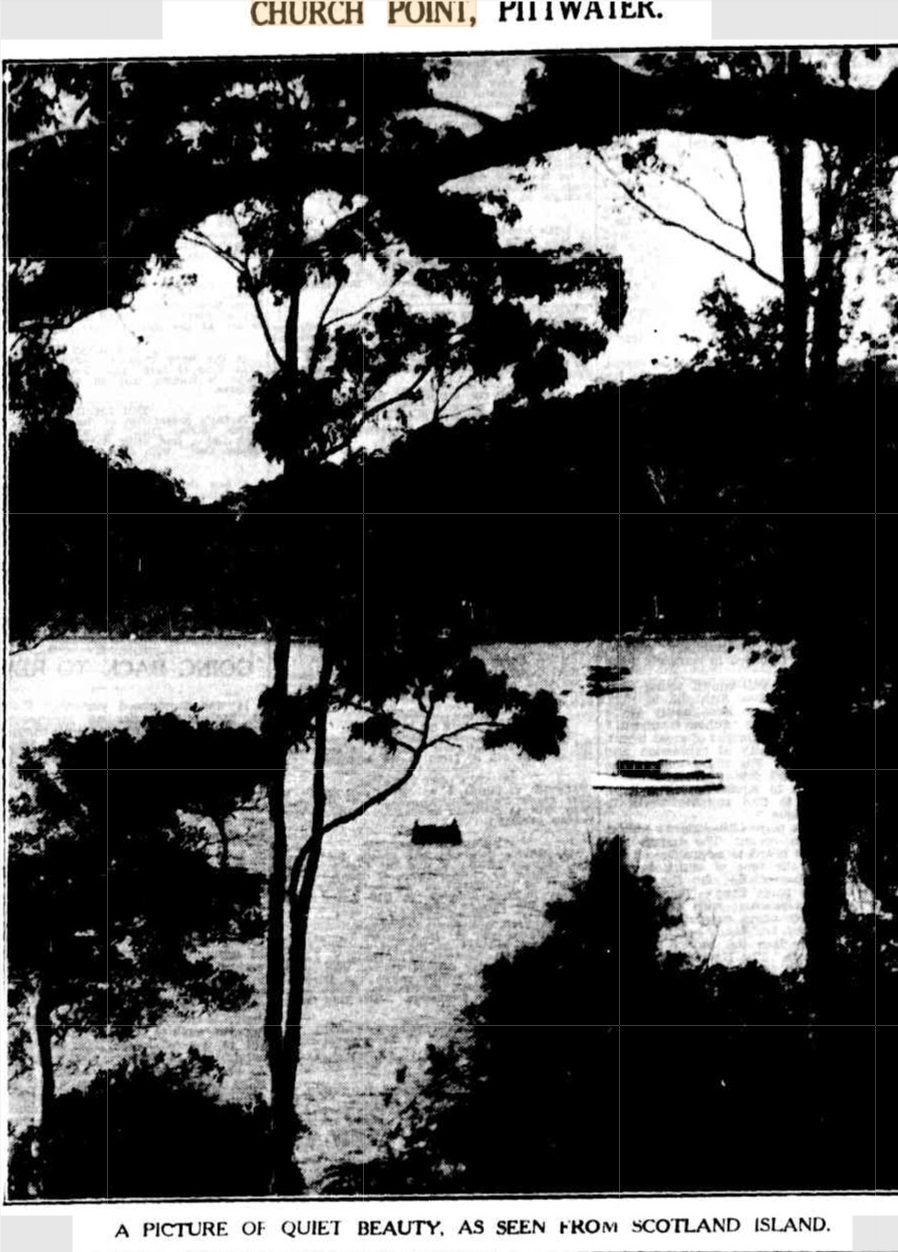
There are few more beautiful spots within in easy reach of Sydney than Church Point, on the Pittwater. Rich in local, ecclesiastical association, the old timbered Methodist Church, from which the locality takes its name, was formerly a school, but the people moved Mona Valewards, and with them their children. Time was when the neighbouring hills echoed the voice of man, uplifted in praise, blending with the purl of rippling waters and soughing winds, in thanksgiving for Nature's beauties, so bounteously bestowed. Man's voice ls silent there now, but Nature still sings her own paeans in her own wonderful way.
The picture is taken from Scotland Island, the name dating back to the days of "Lachlan Macquarie, Esq., Governor." Macquarie's protégé, Andrew Thompson, whose grave is in the historic old churchyard of Windsor, got a grant of the island, and because the surroundings reminded him of his own dear native land, gave it the name it still bears. Church Point is but a mile or so from Mona Vale. May it long preserve its quiet calm! CHURCH POINT. (1930, August 16). The Sydney Morning Herald (NSW : 1842 - 1954), p. 11. Retrieved from http://nla.gov.au/nla.news-article28044177
The chapel from which the place derived its name was demolished in 1932 - see under References - and people were visiting their weekenders from the early 1930's on, not without 'making the papers', or the scandal sheeted versions, when they reported on supposed salacious doings:
Whisky, Women, Dead Marines And Wild Week-Ends
MOTOR MAN'S GAY PARTIES AT CHURCH POINT
SHADE of Bacchus! Whiffs of whisky! Sniffs of beer ! And dead marines by the dozen/ THE old reprobate, god of every boozer with a thirst, would have sung his ribald songs with a great rattling of overflowing goblets had he been in the Sydney Divorce Court during the week, where startling allegations were made against Darcy 1 Vincent Ryan, Sydney motor man.
I Shades of Bacchus whiffs of whisky! Sniffters of beer And dead marines by the dozen! They were all conjured up for the' vision to behold by an affidavit filed for Mr. Justice Owen's benefit by Ryan's pretty ex-wife, Mrs. Olive Ryan, who alleged that Ryan quaffed from the flowing bowl and entertained indiscreet ladies in his cottage at Church Point. BUT Ryan, whom his wife divorced last year, denied as emphatically that he had imbibed as ingloriously as was alleged against him, and protested strongly that he had never spent weekends alone with bibulous ladies at Church Point, on the banks of Brisbane water. It had all to do with the question of Ryan's access to his little seven years old son, Darcy. the custody of whom was granted the wife at ... of her divorce suit In 1931, but whom access was 'given the husband.
Under the order for access, Ryan was allowed to see the boy once a week and have him for one week-end a month and half the school holidays. However, last week, he asked Mr. Justice Owen for a variation of that order so that he could have the child every alternate week-end. The wife opposed this, brought in the allegations about Ryan's drinking habits with women at Church Point, and more or less had a victory, as Ryan lost some of the time that he used to have with his boy. '
SON'S WEEK-END
The wife, in an affidavit, suited that Ryan, who lives in Bennett-street, Bondi, went to Church Point at the week- end for pleasure and not for business, and if the child went every alternate week-end his religious education would be neglected. Ryan, in a broadside in retaliation, declared that he took the child down on Friday week last, cooked the evening meal, saw that he said his prayers, and tucked him into bed all nice and comfortable that night. The boy, he went on and played with other youngsters during the week-end. Nobody else was there, and each night he made him say his prayers again, after which he saw that he was comfortable. On the other hand, the wife, in another affidavit, swore that, when her husband was taking the boy down to Church Point over the week-end referred to by him, he visited a couple of hotels on the way, and she added that during married life he was in the habit of getting drunk and ill-treating her. Said the wife, who is living in Coogee Bay Road, and for whom Mr. C. V....appeared. 'I say that my husband hasn't attended his...for over .. years, and had scoffed at the religious beliefs, saying that all Catholics were ... hypocrites.'
On top of that, there was read the affidavit of Douglas George Robertson, a contractor at Church Point. Robertson, who lives nearby, declared that he had seen Ryan under the influence of liquor at Church Point. 'Ryan has had parties of women and men there,' stated Robertson, 'and on one occasion. I took as many as 32 beer and whisky bottles from Ryan's house. That week-end there was only Ryan and a woman there. 'Ryan,' he went on, 'has stayed at his property with a woman named Kenny, and after the week-end I took away a number of whisky and beer bottles from the house.' Recently he averred, Ryan stayed at Church Point for a week, the first part of
.jpg?timestamp=1694574537727) ALLEGED THAT HER EXHUSBAND entertained women with whisky and beer at Church Point.— Mrs. Olive Ryan.
ALLEGED THAT HER EXHUSBAND entertained women with whisky and beer at Church Point.— Mrs. Olive Ryan.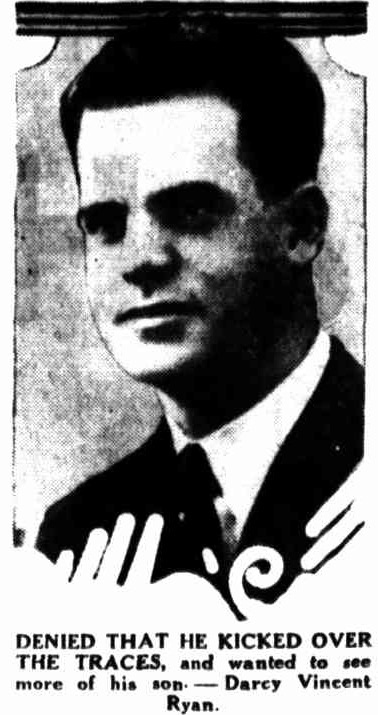 DENIED THAT HE KICKED OVER THE TRACES, and wanted to see more of his son* — Darcy Vincent Ryan.
DENIED THAT HE KICKED OVER THE TRACES, and wanted to see more of his son* — Darcy Vincent Ryan.
which he had two women staying there with him. They were the only people in the house. Tim two women left on the Wednesday or the Thursday, and on Sunday the woman named Kenny, with another woman, came down to stay. 'On the Monday morning,' stated Robertson, 'I was asked 1o take the two women to Chun-h Point, where the woman named Kenny's car was parked. The woman with Kenny was suffering from the effects of drink. '- -n my return, 1 saw Darcy Ryan, who was suffering from t lie effects of drink. Tim two women and Ryan were the only three in the place.' Robertson went on to state that, after Mrs. Ryan had been granted her decree nisi, Ryan had a woman named Dulcie Green with him for the week-end, and they were both drinking. During a week-end following, Robertson alleged, Ryan had the woman named Kenny down there again. Both were drunk, and were the only people in the house.
POSED IN NUDE
Making further allegations, Robertson added that, during one week-end last year, Ryan had a man named Richards and two women down at the Point with him. The whole party had had a good deal of drink, and it was Robertson's statement that Ryan behaved in a deplorable and shameless manner in the presence of the women. .
'Ryan,' he concluded, 'frequently entered the water in the nude, and I have seen him pose for his photo in the nude.'
A friend of Ryan's, one Arthur William Yager, on the other hand, filed an affidavit in which he explained the photograph incident by saying that there was nobody about, and the picture was taken just for a joke, as Ryan was about to enter the water.
Ryan denied that he went into the hotel on the way to Church Point to have a drink as alleged by his wife, denied her other allegations, and said that he was never down at Church Point alone with women. 'I am prepared to admit,' he went on, 'that married men have brought their wives down to Church Point, but never has drinking been carried on to excess, or was there ever any conduct of mine that could be, objected to.' Ryan emphatically denied that he had ever scoffed at religion, and said that he was always ready to meet any medical expenses for the child.
As for what Robertson had stated, he gave it an equally emphatic denial. 'It is preposterous to say,' he added, 'that the parties were rowdy. It is possible that a large number of bottles that had accumulated was taken away, but I deny that the women were there with me alone drinking.
'I deny that there were any women suffering from the effects of drink,' he stated, 'and I do not admit that Dulcie Green or any other woman were staying there with me for the week-end alone, or that any other person was drinking to excess.'
Describing Robertson's statement as to his alleged deplorable and shameless conduct as being absolutely without foundation, Ryan went on to say that he had never entered the water for a swim in the nude other than as Mr. Yager had described. However, his application availed Ryan little. The varied order is that he is to have the boy one day a week from 2 p.m. till 6, and during school holidays for three days a week for the same hours.
The week-end trips were knocked on the head, the judge saying that he wouldn't allow the boy to be taken to Church Point, and the atmosphere that had been described. Mrs. Ryan called at 'Truth' Office in connection with this case, and stated that she was firmly convinced that an injustice had been done her husband by ventilating the facts in court. She said that she had made a mistake, and now believed that the photograph had been snapped without his knowledge. Whisky, Women, Dead Marines And Wild Week-Ends (1932, May 29). Truth (Sydney, NSW : 1894 - 1954), p. 10. Retrieved from http://nla.gov.au/nla.news-article169136277
This was also when a road was being formed, finally, at McCarrs creek and Church Point:
PUBLIC WORKS ACT, 1912.
Ku-ring-gai Chase Roads: McCarrs Creek Road.
Authorisation.
HIS Excellency the Governor, with the advice of the Executive Council, has authorised the carrying out under the provisions of the Public Works Act, 1912, as amended, of the work described in the Schedule hereto, the estimated cost of which does not exceed £20,000, and has approved of the Minister for Public Works being deemed the Constructing Authority.
Dated this sixth day of August, 1937.
E. S. SPOONER, Minister for Public Works.
Schedule.
McCarrs Creek road: Construction, subject to such deviations as may be deemed necessary by the Minister, of a road: Commencing within portion 26, parish of Narrabeen, county of Cumberland, and extending generally south-westerly along the south-eastern side of McCarrs Creek to The Upper Gledhill Falls, and extending-thence generally - westerly through the Ku-ring-gai Chase area to a point in West Head road, near the southern boundary of that area. (Misc. 37-2,112) (4395) PUBLIC WORKS ACT, 1912. (1937, August 6). Government Gazette of the State of New South Wales (Sydney, NSW : 1901 - 2001), p. 3225. Retrieved from http://nla.gov.au/nla.news-article224748056
Conditions for the workers, 500 in all according to this report, weren't ideal:
"DRINK WITH HORSES"
Shocking Conditions On Relief Job
MEN BEAT TEA BAN
SYDNEY.—"We would be pleased if you would publish some of the following complaints on the McCarr's Creek Road job," writes a representatives of the Manly-Warringah Council of Unemployed and Relief Workers.
"Last week the Public Works' Department made definite efforts to tighten up the already foul conditions on this job by instructing their gangers that the morning tea which the men had been having, more or Iess under the lap, had to stop, and the first man who attempted to boil the copper would be instantly dismissed.
"The Unemployed Council, not wishing to see anybody -victimised, decided to approach all the men on the matter, and it was decided that at 9.30 a.m. every worker in each gang down tools and walk over to the copper in a body and all take part In boiling the water. This was done while the gangers looked on and threatened that everyone would be docked half an hour, but this was not done.
HYGIENE
"This, I think, proves a victory for us, seeing that we are continuing to have it every day by the same methods. We have had several deputations to the engineer and head office on this and other matters and have explained that some of the men have to arise at 4 am to get to this job, which means eight hours without anything to eat.
"Another serious matter is the fact that we' have no latrines on the Job. This may not sound so bad to some people, seeing that there is nothing but bush out there, we wouldn't mind, either, if we didn't have to drink the water which runs through the bush, and which the men ate forced to use. Another i thing: the horses have to drink from the same holes as us.
"The department did provide two tanks, but these had been used to preserve herrings in, and the water made some of the men sick. In any case, these are stored about a mile and a half from where' the bulk' of the men are working, the position when the hot weather comes oh.
ACCIDENTS
"Another very serious matter is the fact that we have no transport in case of bad accidents and no means of communication. The nearest telephone is five miles away. The department will not connect with the 'phone because it would cost about £60. Apparently it is not worth that amount to protect the lives of about 500 men for at least three years, which the job will take.
"Just before we close we would like to mention that two members of the Council were victimised over the morning tea trouble. These men were sent to other jobs and isolated. However, they were just on the tail-end of their two weeks on and will now be off for two weeks, so we will have to see what happens when they start again." “DRINK WITH HORSES” (1937, August 31). The Workers' Weekly (Sydney, NSW : 1923 - 1939), p. 4. Retrieved from http://nla.gov.au/nla.news-article211822157
Warringah Shire Council Minutes of Meetings records:
22.11.1938 19. The Shire Clerk reported that he had this day received a telephone message from Mr. Brooks, of the Public Works Department, that the new road constructed by the Government as unemployed relief, work from West Head Road via Coal & Candle Creek and McCarr’s Creek to Church Point would be completed in about a week's time, that it was proposed to hold an official opening by the Minister for Works & Local Government, probably on Saturday, 10th December, and the Department would like the Council to participate in the function. Resolved, - That the party be entertained by the Council at "Pasadena", Church Point, at the expense of the Council, and the arrangements be left in the hands of the President. (Crs. Butcher, Nicholas)
ROAD REPORTS.
New Road to Church Point.
Officers of the NRMA touring department recently inspected the new road by way of McCarr's Creek to Church Point which has just been completed by the Department of Public Works. The road is of gravel formation of good average width and well graded.
To reach the new road the motorist proceeds along the St Ives-Mona Vale road from Terrey Hills and turns left on to the Coal and Candle Creek road at a small garage. A little more than a mile further on the new road to Church Point bears away to the right. Then follows a long, winding down grade through picturesque bush country. The road crosses the extreme upper reaches of McCarr's Creek near a turn-off to Coal and Candle Creek. This is a new road not yet open to traffic.
The Church Point road bears slightly to the right and continues over easy grades down the eastern side of McCarr's Creek. In the last two or three miles to Church Point there are some very pretty glimpses of the creek as the road winds round the eastern bank. The surface throughout is in very fair condition but until this road is tar sealed the association warns drivers to exercise care as with the dry summer weather and in-creased traffic loose edges might appear. The total distance from the Coal and Candle Creek road turn off to Church Point is five miles. ROAD REPORTS. (1938, December 16). The Sydney Morning Herald (NSW : 1842 - 1954), p. 5. Retrieved from http://nla.gov.au/nla.news-article17562662
NEW SCENIC ROADS.
Opening Up Kuring-gai Chase.
MANY IMPROVEMENTS.
Hundreds of men employed by the Public Works Department is ere engaged during the past year building roads which will eventually open up more of the scenic beauties of Kuring gai Chase.
Bobbin Head on a picturesque bend of Cowan Creek has long been a popular motor drive and the completion of the road through from the lodge gates at the Turramurra end of the Mount Colah enhance to the Chase provided what is considered to be one of the finest scenic trips In the metropolitan area. At the northern end it connects with the Pacific Highs leading to Brooklyn at the extremity of the Chase.
A deviation at Bobbin Head which is almost finished leads to Apple Tree Bay, where the trustees propose to reclaim about four acres for a picnic area and construct capacious baths.
Men have been engaged for some time in the construction of a road from Church Point near Pittwater to the head of McCarrs Creek and thence to Coal and Candle Creek opposite Bobbin Head. On its way this road junctions with West Head Road, recently completed a branch of the highway from Pymble to the northern beaches.
The chairman of the trust Mr. R B Orchard said these new roads opened up some of the most beautiful country around Sydney including parts of the Chase that had not accessible to tourists.
The trust is erecting a boatshed at Oyster Bay at the entrance to Coal and Candle Creek adding a refreshment room and conveniences for picnickers. The trust also has plans for further improvements at Bobbin Head where an adequate electric light supply has just been provided Eventually Orchard Park and other resorts in the vicinity will be lit up at night as will the approach roads It was estimated that 500 motorists used the parking area each week. Several times that number passed through on the new road to Mount Colah.
"We still have difficulty," Mr Orchard said protecting the native flora of the Chase. Prosecution of offenders during the year how-ever has had a salutary effect." NEW SCENIC ROADS. (1939, January 3). The Sydney Morning Herald (NSW : 1842 - 1954), p. 8. Retrieved from http://nla.gov.au/nla.news-article17560501
NEW SCENIC ROAD OPENS UP FRESH COUNTRY.
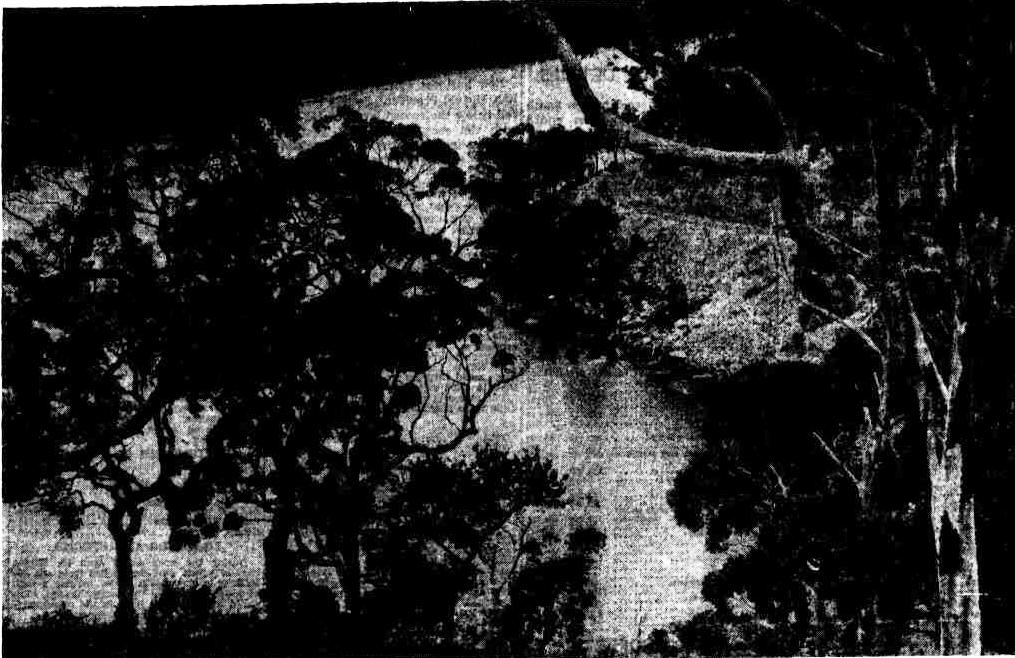
A glimpse of the quaintly-named Coal and Candle Creek from the new scenic road which is being constructed by the Public Works Department. As an accompanying article explains, this road can be reached from Church Point on the Pittwater or from Pymble. It runs through part of the area controlled by the Kuring-gai Chase Trust and opens to the motorist some of the wild and unspoilt areas of the Hawkesbury River country. NEW SCENIC ROAD OPENS UP FRESH COUNTRY. (1939, April 22). The Sydney Morning Herald (NSW : 1842 - 1954), p. 13. Retrieved from http://nla.gov.au/nla.news-article17570090
Relief Workers' Complaint
P. E. MEDANA (North, Sydney) writes: Last Thursday 60 men returning home from the McCarrs Creek relief job were held up for five hours when their bus skidded into a ditch on the way to North Sydney. They had to wait until a breakdown truck arrived and repaired the bus. Yet— when a bus breaks down on the way to work, a relief bus is made available immediately, and only one hour is lost.
Wives were waiting at North Sydney for the men to get home— it was pay night— and the police station was besieged by anxious Inquirers. Children ran all over the suburb to see If other fathers had returned home yet. But families just had to wait patiently for five hours!
The least that could be done to compensate the men would be to pay them for that time. Australia will need every man to defend her shores— even the 200,000 unemployed. Is this the way to earn their co-operation?
Only If the Government eliminates the many injustices, such as the above, now meted out to relief workers, will It be on the road to getting that spirit.
I have been Instructed to write this letter as delegate for the men on the McCarr's Creek Job. Relief Workers' Complaint (1939, April 24). Daily News (Sydney, NSW : 1938 - 1940), p. 4. Retrieved from http://nla.gov.au/nla.news-article236292374
World War Two came and John Lander Browne went off to serve his country. His records show he was located at Waukivory, a small town near Gloucester, New South Wales when enlisting although he was enlisted at Port Moresby in Papua New Guinea itself. Possibly Georgina maintained ties with the old stomping grounds of her aunt.
A holiday visitor to the district is Mrs. L. Brown, of Turramurra, who is the guest of Miss Marie Green, at Waukivory. Personal. (1946, April 2). The Gloucester Advocate (NSW : 1905 - 1954), p. 3. Retrieved from http://nla.gov.au/nla.news-article160471338
His registration number: PX159, Sargent, LHQ Survey. He served in New Guinea and was discharged on October 26 1945.
The Royal Australian Survey Corps (RA Svy) was a Corps of the Australian Army, formed on 1 July 1915 and disbanded on 1 July 1996. As one of the principal military survey units in Australia, the role of the Royal Australian Survey Corps was to provide the maps, aeronautical charts, hydrographical charts and geodetic and control survey data required for land combat operations.
Functional responsibilities associated with this role were: theatre wide geodetic survey for – artillery, naval gunfire and close air support – mapping and charting – navigation systems – command and control, communications, intelligence, reconnaissance and surveillance systems; map production and printing for new maps and charts, plans, overprints, battle maps, air photo mosaics and photomaps, rapid map and chart revision; map holding and map distribution; production, maintenance and distribution of digital topographic information and products. RA Svy survey and mapping information was, and still is, a key information source for geospatial intelligence.
The operational doctrine was that the combat force deployed into the area of operations with topographic products adequate for planning, force insertion and initial conduct of tactical operations, that new products and broad area updates of the topographic base would be provided by the support area and communication zone survey forces, and that the combat support survey force in the area of operations would update the topographic base, add tactical operational and intelligence information and provide the value-added products required by the combat force.
The Historical Collection of the Survey Corps is maintained by the Australian Army Museum of Military Engineering at Holsworthy Barracks, south-west Sydney. Survey Corps Associations of ex-members, family and friends are located in Adelaide, Bendigo, Brisbane, Canberra, Perth and Sydney. Many wartime maps produced by the Survey Corps are in the Australian War Memorial collection, while all of the maps produced by the Corps are also in the national collection at the National Library of Australia. All of these are available to the public and some are online.
Initially, the Australian Survey Corps continued its mapping for the defence of Australia, proceeded with basic survey triangulation and provided training cadre for new field and training units. In January 1940, Field Survey Units RAE (Militia) were established in 1st Military District – Queensland, 2nd Military District – New South Wales and 3rd Military District – Victoria to accelerate the mapping effort. Deputy Assistant Directors – Survey were appointed to Military District Headquarters to advise on survey needs and to liaise with State agencies. In April 1940 the 2/1 Corps Field Survey Company RAE was raised as part of the 2nd Australian Imperial Force for service overseas and a Survey staff was appointed to the formation (Corps) headquarters.
On his return he served at his brother-in-laws second marriage. Robert Lamplough had married a lass who died very young prior to that after just a few years of marriage:
ENGAGEMENTS
LAMPLOUGH—CHAMPION.—The Engagement is announced of Miss Ann Champion, elder daughter of Mr. and Mrs. P. D. Champion, of North Sydney, to Lieut. R. H. G. Lamplough, A.I.F., youngest son of Mr. and Mrs. J. R. Lamplough, of Roseville. Family Notices (1942, December 14). The Sydney Morning Herald (NSW : 1842 - 1954), p. 10. Retrieved from http://nla.gov.au/nla.news-article17799639
LAMPLOUGH-CHAMPION.-July 20, 1943, at Christ Church, Lavender Bay, by the Rev. P. Cash, Ann, elder daughter of Mr. and Mrs. P. D. Champion, of North Sydney, to Capt. Robert H. G. Lamplough (A.I.F.), youngest son of Mr. and Mrs J. R. Lamplough, Roseville. Family Notices (1943, August 7). The Sydney Morning Herald (NSW : 1842 - 1954), p. 16. Retrieved from http://nla.gov.au/nla.news-article17859382
LAMPLOUGH.—February 24, 1945 (suddenly), Ada May (Ann), dearly beloved daughter of Percy and Sadie Champion, of 267 Alfred Street, North Sydney, aged 27 years. Family Notices (1945, February 27). The Sydney Morning Herald (NSW : 1842 - 1954), p. 10. Retrieved from http://nla.gov.au/nla.news-article17940356
LAMPLOUGH.-February 24, 1945, suddenly, Ada May (Ann), dearly beloved wife of Robert Henry Grant Lamplough, aged 27 years.
LAMPLOUGH.-The Funeral of the late Ada May (Ann) Lamplough will leave Christ Church, Lavender Bay, To-morrow Tuesday, after Service commencing at 9.45 a.m., for the Church of England Cemetery, Northern Suburbs. Wood Coffill Limited. Family Notices (1945, February 26). The Sydney Morning Herald (NSW : 1842 - 1954), p. 10. Retrieved from http://nla.gov.au/nla.news-article17945119
ADA MAY LAMPLOUGH also known as Ann Champion late of Roseville In the State of New South Wales Married Woman who died 24th February 1945 intestate. Advertising (1945, April 20). The Sydney Morning Herald (NSW : 1842 - 1954), p. 9. Retrieved from http://nla.gov.au/nla.news-article17933754
LAMPLOUGH.—In loving memory of Ada (Ann) who passed away February 24 1945. Sadly missed by her loving mother father and family. Family Notices (1947, February 24). The Sydney Morning Herald (NSW : 1842 - 1954), p. 14. Retrieved from http://nla.gov.au/nla.news-article18007267
Robert Lamplough's second marriage:
LAMPLOUGH-BROTCHIE.-The Engagement is announced of Winsome, elder daughter of Mr and Mrs G Brotchie, of Roseville, to Captain R. H. G. Lamplough, younger son of Mr. and Mrs. J. R. Lamplough, of Roseville. Family Notices (1946, May 28). The Sydney Morning Herald (NSW : 1842 - 1954), p. 16. Retrieved from http://nla.gov.au/nla.news-article17981265
TO MARRY TO-DAY
MISS WINSOME BROTCHIE, elder daughter of Mr. and Mrs. G. Brotchie, of Roseville, will marry Mr. Robert H. G. Lamplough, younger son of Mr. and Mrs. J.L. Lamplough, of Lindfield, at St. Philip's Church, Church Hill, to-night. Miss Betty Brotchie will be her sister's bridesmaid, and Mr. John Lander Browne will attend the bridegroom. A reception will be held at the Wentworth Hotel. Mr. Lamplough was recently discharged as a captain in the A.I.F. Miss Brotchie was formerly publicity officer of the R.A.A.F. Comforts Fund younger set, which has recently been abandoned after raising £2,500 for comforts for the men serving abroad. TO MARRY TO-DAY (1946, July 17). The Sydney Morning Herald (NSW : 1842 - 1954), p. 6. Retrieved from http://nla.gov.au/nla.news-article17991385
FRINGED FROCK FOR BRIDE
A draped white crepe afternoon frock trimmed with fringe and a cocktail hat of taffeta roses were worn by Miss Winsome Brotchie yesterday for her marriage to ex-A.I.F. Captain Robert H. G. Lamplough at St. Philip's Church. Church Hill. The bride, formerly publicity officer of the R.A.A.F. Comforts Fund younger set, is the elder daughter of Mr., and Mrs. G. Brotchie, of Roseville. Miss Betty Brotchie, the bridesmaid, wore a pale blue crepe frock with white accessories. She carried a bouquet of pale pink camellias Mr. John Lander-Browne, ex-A.I.F. also, attended the groom, who is the younger son of Mr and Mrs. J R. Lamplough, of Lindfield. After the ceremony a reception was held at the Wentworth Hotel. FRINGED FROCK FOR BRIDE (1946, July 18). The Daily Telegraph (Sydney, NSW : 1931 - 1954), p. 22. Retrieved from http://nla.gov.au/nla.news-article248525916
BrideTo-Be Caught Bouquet
The wedding: superstition about catching the bride's bouquet came true for Betty Brotchie, whose wedding to A.I.F. Major Leonard Stansfield takes place at St. Philip's tomorrow. Betty caught her sister Winsome's bridal posy last Friday at her wedding to Mr. Robert Lamplough. Winsome is returning from her honeymoon to be matron of honour.
Brides are the daughters of Mr. and Mrs. George Brotchie, of Roseville, and Betty is an ex-member of the W.A.A.A.F. Bride-To-Be Caught Bouquet (1946, July 25). The Daily Telegraph (Sydney, NSW : 1931 - 1954), p. 22. Retrieved from http://nla.gov.au/nla.news-article248527195
Robert and Winsome Lamplough would have two sons, the first one born the following year:
LAMPLOUGH (nee Brotchie).—May 12, at Mater Maternity private hospital, to Winsome, wife of Robert Lamplough—a son. Family Notices (1947, May 13). The Sydney Morning Herald (NSW : 1842 - 1954), p. 22. Retrieved from http://nla.gov.au/nla.news-article18025816
A few insights from Winsome Brotchie's WWII Service of an evening:
Bomb Cocktails Served Before Blackout Siren
Special "bomb cocktails" were served at the Blackout Party held last night at the Wintergarden Theatre, Rose Bay, by the R.A.A.F. Comforts Fund (Richmond Station) Younger Set committee.
The cocktails were subdivided into two types, "high-explosive ' and "delayed action." More than 200 guests, including many airmen on leave, attended the party which was held in the lounge of the theatre. It was decorated to represent a deluxe air-raid shelter. The trestle tables, on which was set the buffet supper, were labelled "canteens," in the character of a shelter. Instead of the usual savories, nourishing dishes with thick slices of bread were served. Committee members, in order to save expenses, prepared the supper themselves, having worked on it from 3 p.m. The party began at 6.30, with dancing and games. At 9.30, at the sound of the blackout siren, all lights were switched out, and guests donned masks before the lights went on again. During the following half-hour, anyone seen without a mask was fined a subscription to the fund. Led by a record of the R.A.A.F. choir singing "Stout-hearted Men," guests joined in community singing during part of the blackout.
Another musical feature was the singing of "Sweetheart in Blue," written by Mr. Barry Keen for the occasion. Among the hostesses for the evening were Miss Pat O'Sullivan (the newly-elected president, who was presiding at her first party for the fund), Miss Joyce Maddrell and Mrs. C. W. Farrell (hon. secretaries), Miss Peg Berch (honorary treasurer). Miss Margaret Gilligan (vice-president). Misses Beth Leyburn, Winsome Brotchie, Peg Condon, and Pauline Chappie. Bomb Cocktails Served Before Blackout Siren (1941, August 18). The Daily Telegraph (Sydney, NSW : 1931 - 1954), p. 6. Retrieved from http://nla.gov.au/nla.news-article247504222
Birthday Dance
To celebrate the ;fourth birthday of the RAAF Younger Set Comforts Fund, the committee will hold a dance at, the White City ballroom, Rushcutters Bay, on July 22, when a blue and silver decorated birthday cake will be cut. Bookings may be made by ringing Miss Winsome Brotchie at MA3875. Birthday Dance (1944, June 28). The Sun (Sydney, NSW : 1910 - 1954), p. 6 (LATE FINAL EXTRA). Retrieved from http://nla.gov.au/nla.news-article231691681
Robert Lamplough's War Service Records show he was considered an outstanding gentleman, well suited for his Captaincy:
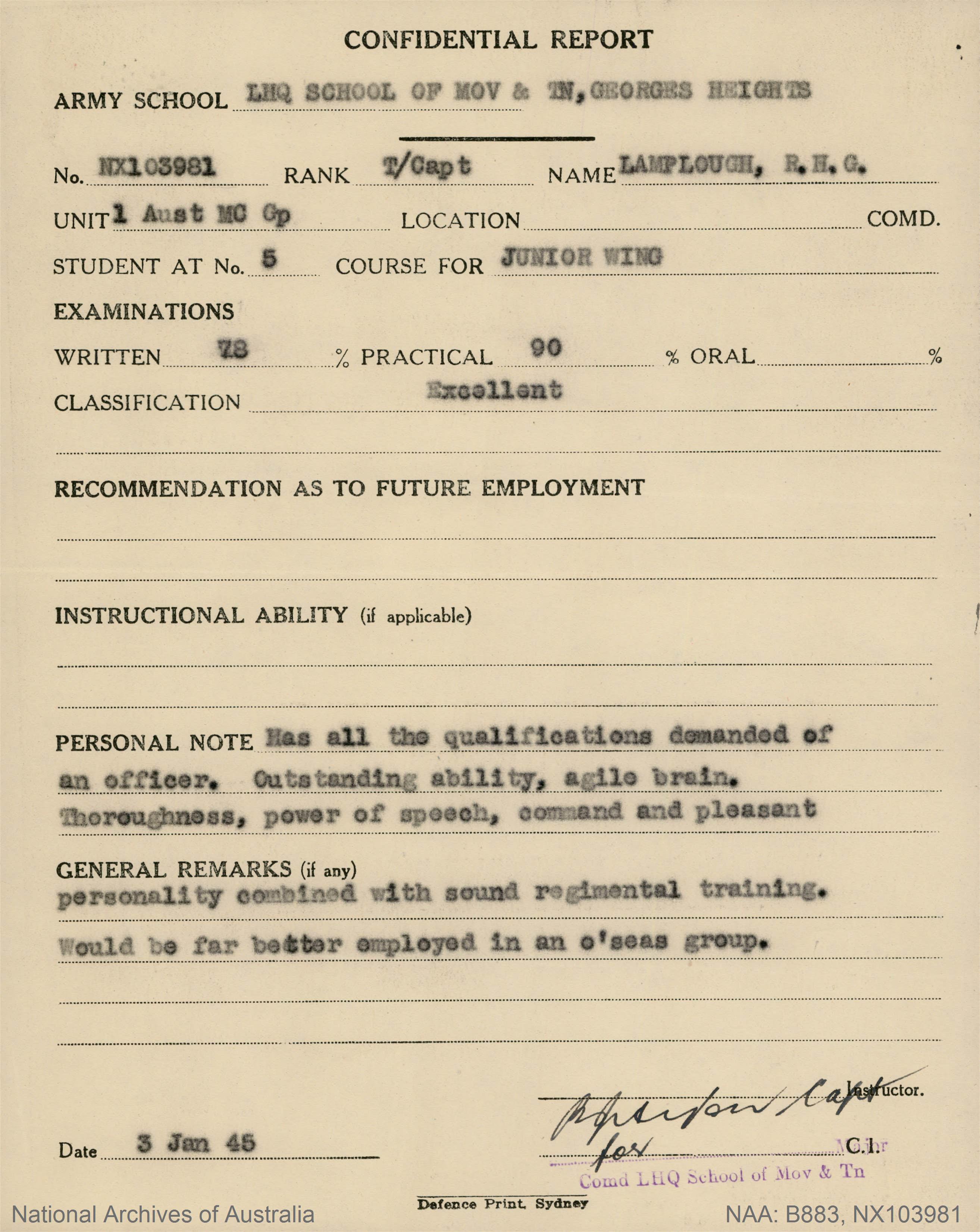
Lucy Richards passed away in 1949, clearly in hospital and ill:
RICHARDS, Lucy.-October 17 1949 at private hospital, widow of the late Alfred Richards.
RICHARDS.-The Funeral of the late Mrs. LUCY RICHARDS will leave Ernest Andrews' Chapels, corner Pacific Highway and Thomas Street, Chatswood, This Day after service commencing at 3 p.m., for the Northern Suburbs Crematorium. Family Notices (1949, October 18). The Sydney Morning Herald (NSW : 1842 - 1954), p. 16. Retrieved from http://nla.gov.au/nla.news-article27576996
Her two nephews-in-law are the executors, with Probate granted in 1950:
IN the Will (and two Codicils) of LUCY RICHARDS late of Church Point near Sydney In the State of New South Wales Widow deceased. Application will be made after 14 days from the publication hereof that Probate of the last Will and Testament dated 11th December, 1944 (and 2 Codicils thereto dated 10th April, 1945 and 19th January, 1946 respectively) of the abovenamed deceased may be granted to John Lander Browne and Robert Henry Grant Lamplough the Executors named In the second Codicil of the said Will and all notices may be served at the undermentioned address. All creditors in the Estate of the deceased are hereby required to send In particulars of their claims to the undersigned. F. J. CHURCH & CO , 133 Pitt Street. Sydney. Advertising (1949, November 11). The Sydney Morning Herald (NSW : 1842 - 1954), p. 15. Retrieved from http://nla.gov.au/nla.news-article18134996
IN the Supreme Court of New South Wales.—Probate Jurisdiction.—In the will and two codicils of LUCY RICHARDS, late of Church Point, near Sydney, in the State of New South Wales, widow, deceased.—Probate granted by Supreme Court of New South Wales on 5th April, 1950,—Pursuant to the Wills, Probate and Administration Act, 1898-3940, the Testator's Family Maintenance and Guardianship of Infants Act, 1916-1938, and the Trustees Act, 1925-1940, John Lander Browne and Robert Henry Grant Lamplough, the executors of the will of the said Lucy Richards, who died on the 17th October, 1949, hereby gives notice that creditors and others having any claim against or to the estate of the said deceased are required to send particulars of their claims to the said executors in care of the undersigned at their office hereunder mentioned on or before the 21st April, 1951, at the expiration of which time the said executors will distribute the assets of the said deceased to the persons entitled, having regard only to the claims of which they then have notice.—Dated this 8th day of February, 1951. F. J. CHURCH & CO., Solicitors, 333 Pitt street, Sydney. 445—£1. IN the Supreme Court of New South Wales.—Probate Jurisdiction.—In the will and two codicils of LUCY RICHARDS, late (1951, February 16). Government Gazette of the State of New South Wales (Sydney, NSW : 1901 - 2001), p. 520. Retrieved from http://nla.gov.au/nla.news-article220103432
The 1950 Real Estate listing of the home, this time listed as 'Linga Longa', and after Lucy Richards passes away on October 17, 1949, provides a description of the premises and describes multiple rooms and even an Orchid House.
The description of Longa Linga in 1950
L. J. HOOKER LIMITED
AUCTION SALE, WED., APRIL 12, 10.30 A.M.
Church Point/Pittwater - Vacant Possession
Gentleman's Two-storey Residence
"LINGA LONGA," QUARTER SESSIONS ROAD, OPP. POST-OFFICE.
Set in a glorious position with an uninterrupted view over Pittwater, this delightful Home is to be offered with IMMEDIATE VAC. POSS.
Built to ensure maximum light and views.
ACCOM.: Gd. Floor. Lrge. lounge-rm., dining-rm.. sunrm., kit.. Alcove and pantry. 1st Floor: Large main bedrm., with own bathrm., three additional bedrms., each opening on to a semi-enclosed observatory, second bathrm.. sunrm.. sewing-room. and large semi-end. ver.
Laundry, with man's bathrm.
ORCHID HOUSE. DOUBLE GARAGE. SERVICES Include H.G.A. Range and Septic Sewerage.
LAND: 2 roods 12 perches. Plan and photos at Auctioneers.
In conj.: A. S. COLWELL and SONS, Gordon, and BLAKE and HANKINS, Roseville
Solicitors: F. J. CHURCH & CO. Advertising (1950, March 29). The Sydney Morning Herald (NSW : 1842 - 1954), p. 16. Retrieved from http://nla.gov.au/nla.news-article18154177
It seems likely that the photos taken by Max Dupain date from this sale of the by then 9-year old home:
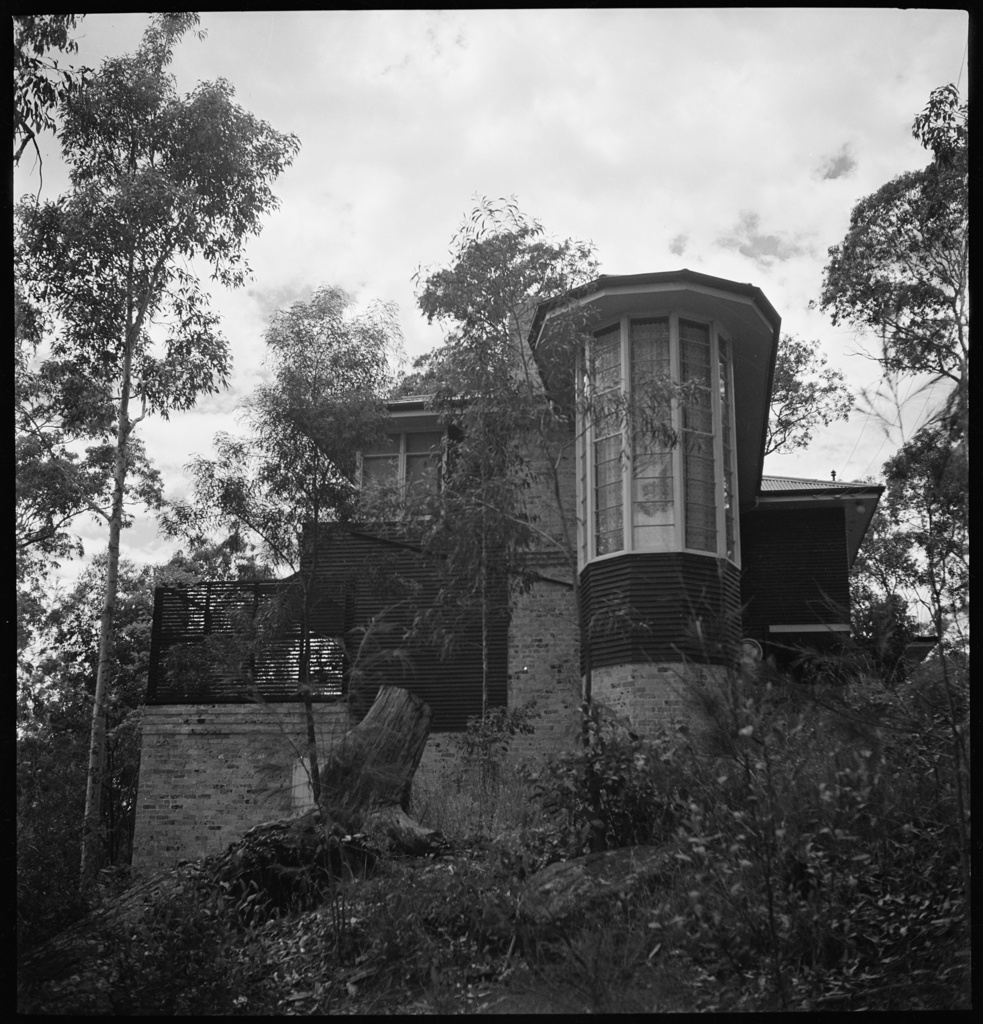
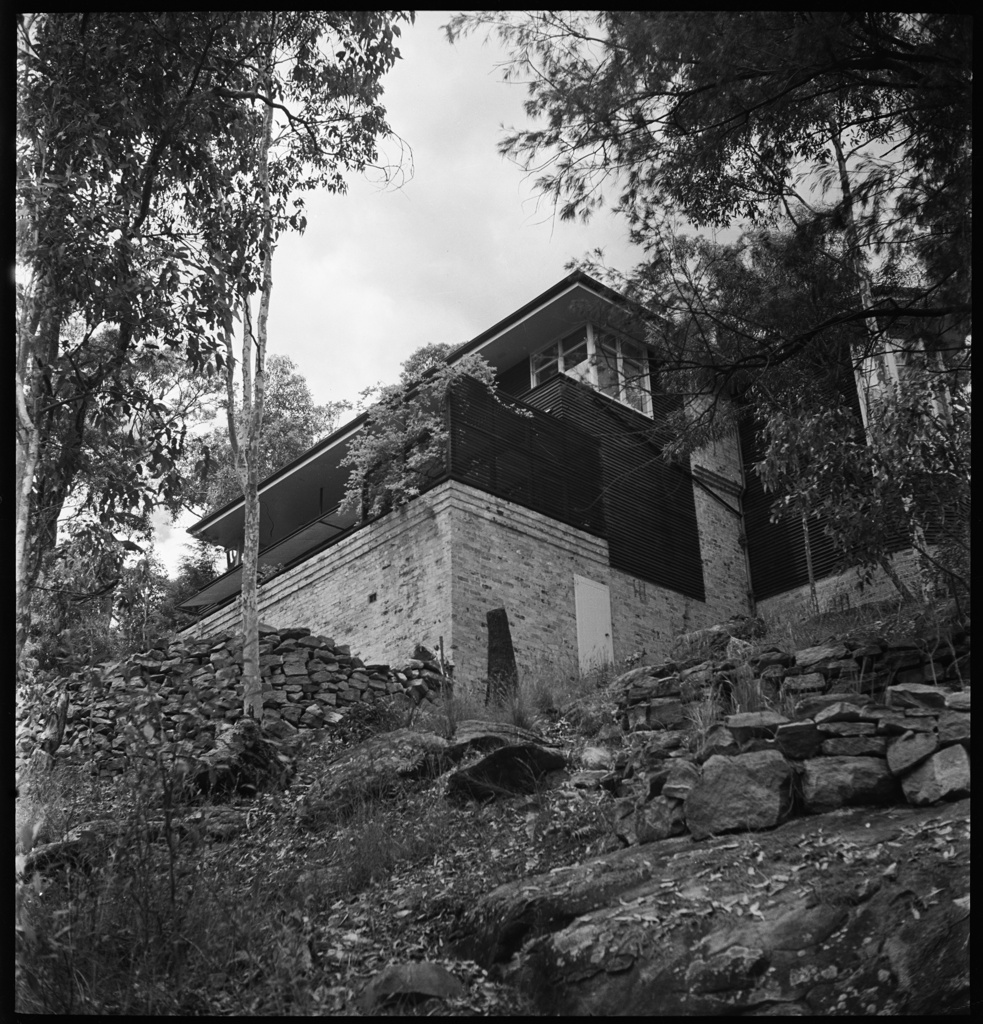
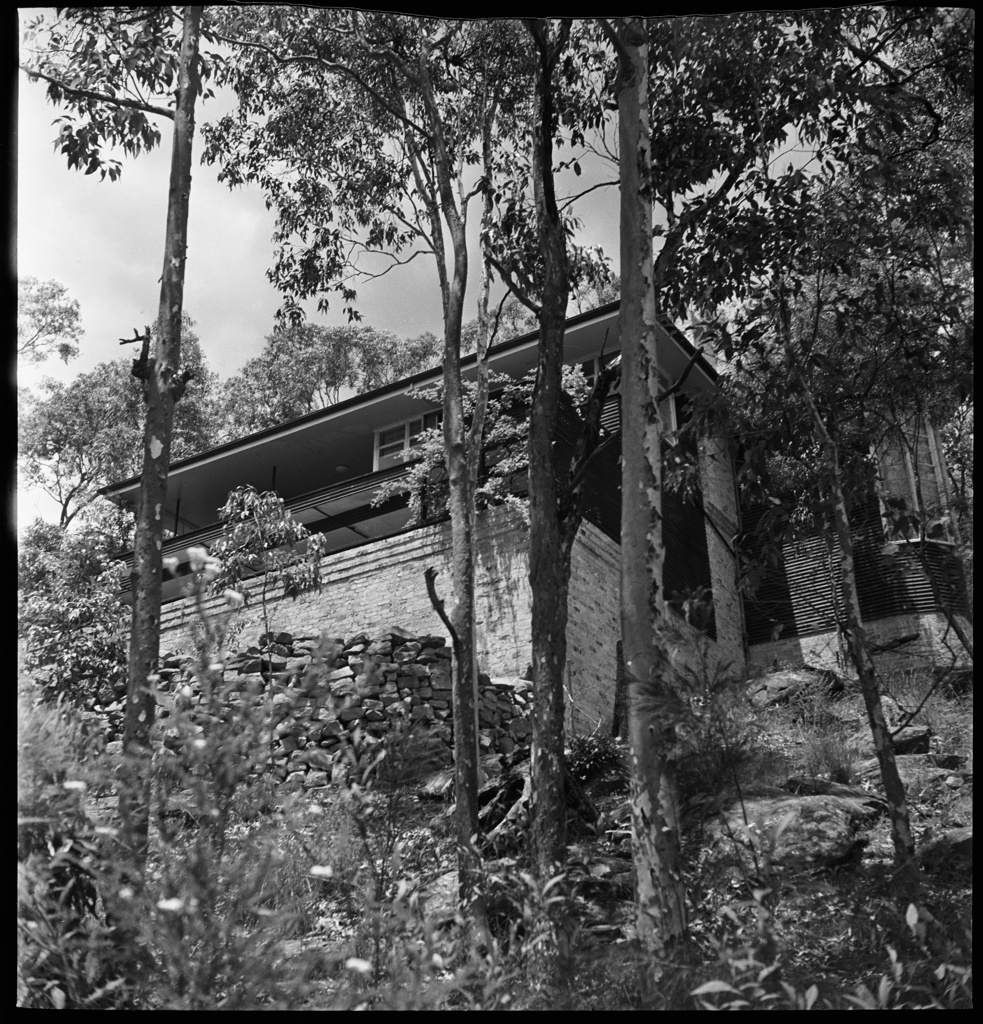
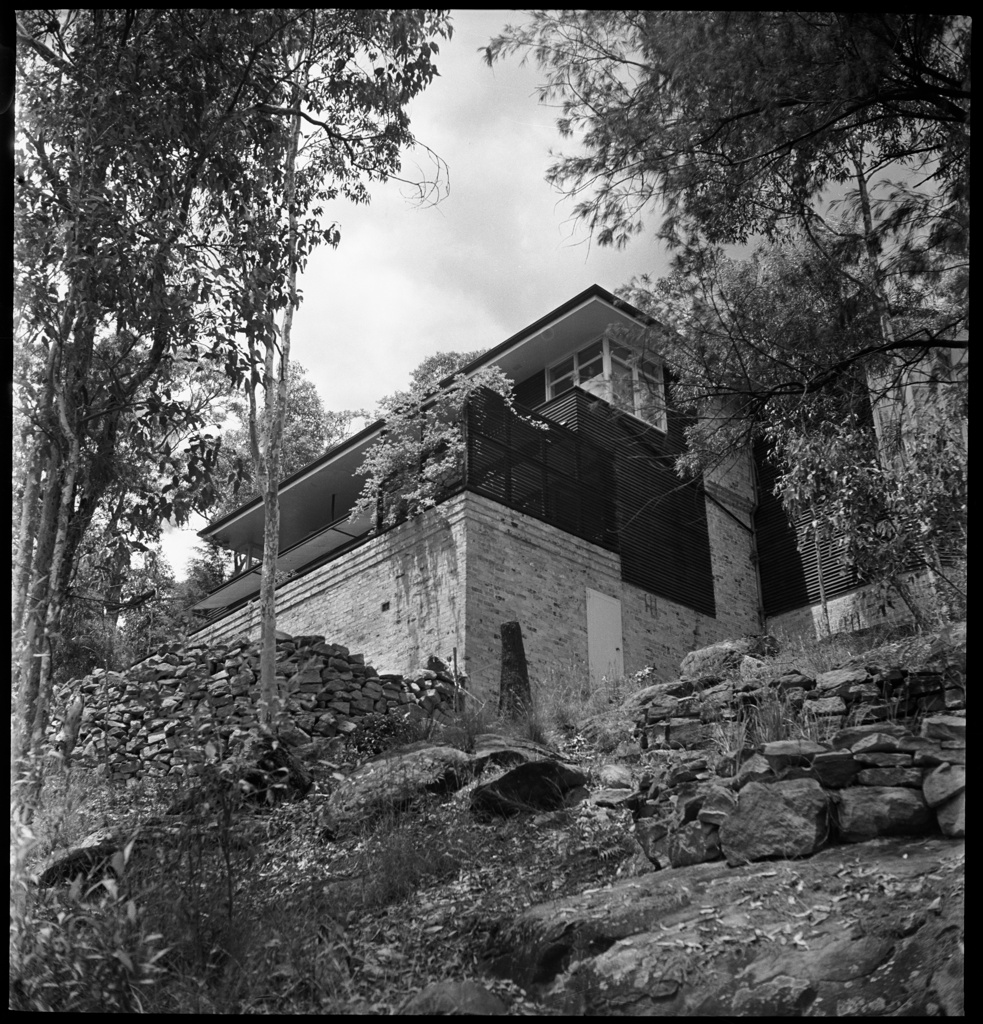
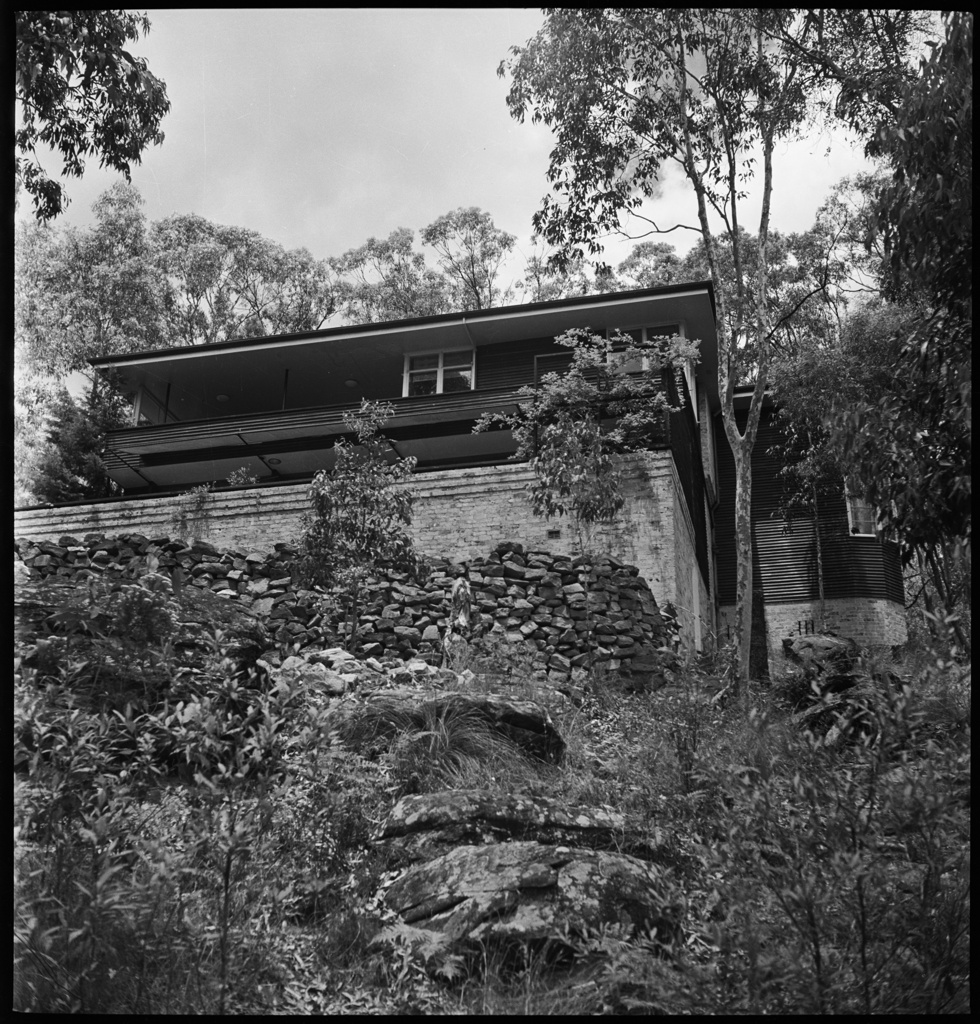
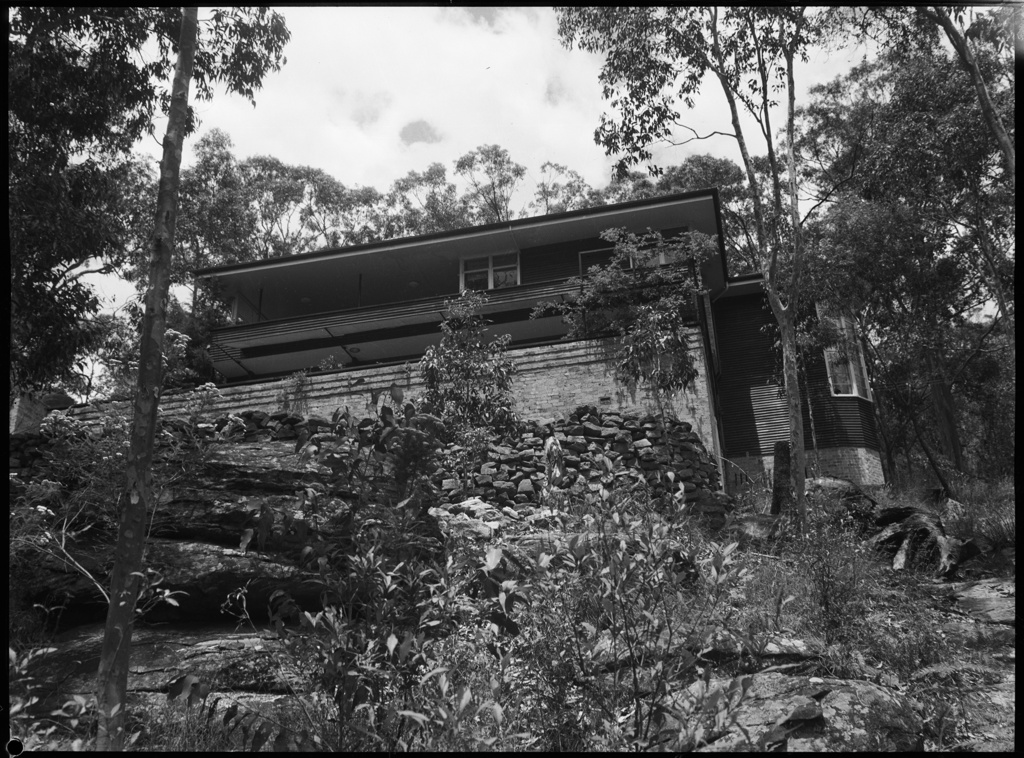
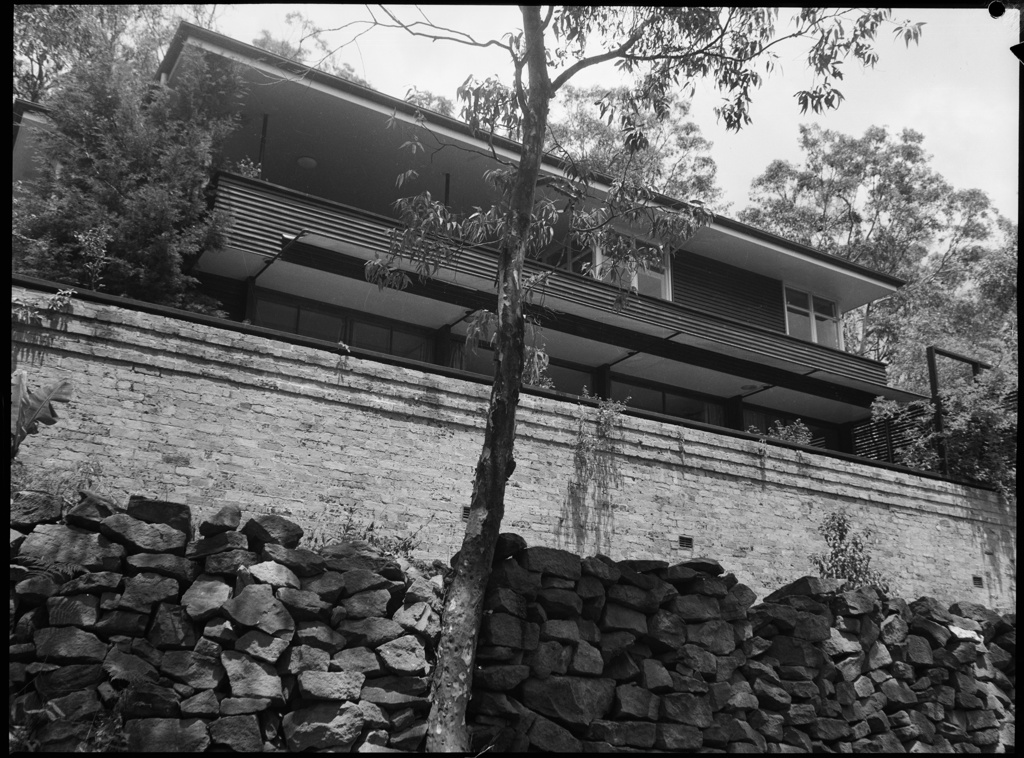
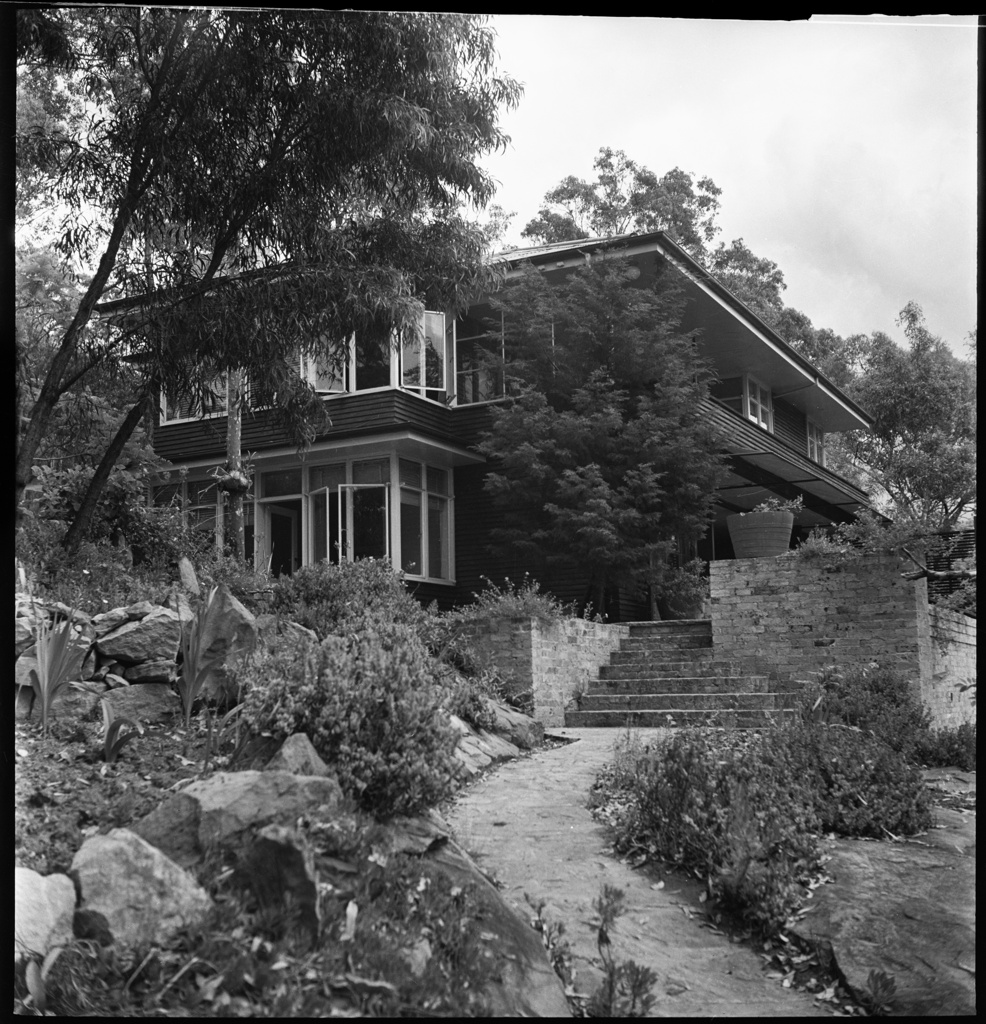
Longa Linga sold in December 1950 to Percy Cambourn of Dover Heights, retired gentleman who put the property on the market again just a few years later, this time getting the name correct:
Church Point - Early V.P. LONGA LINGA Opp Post office a Commodious 2 storey Home of 7 rooms with separate domed cocktail bar unique Sunroom and spacious observation verandah commending glorious views of Pittwater. Double Garage Terraced Gardens The perfect setting for gracious living. In CONJUNCTION ALLAN A- JAMES PTY LTD XW9507 - RAINE & HORNE PTY. LIMITED. Advertising (1954, November 17). The Sydney Morning Herald (NSW : 1842 - 1954), p. 12. Retrieved from http://nla.gov.au/nla.news-article18453453
CHURCH POINT Longa Linga Quarter Sessions Road Two storey residence cont 8 rooms and offices Double Garage Large area of land VACANT POSSESSION. - RAINE & HORNE PTY. LIMITED CORNER PITT AND HUNTER. STREETS SYDNEY. Advertising (1954, November 25). The Sydney Morning Herald (NSW : 1842 - 1954), p. 20. Retrieved from http://nla.gov.au/nla.news-article18462709
Percy Cambourn sold to Herbert Stuart Jeskie and Margaret Lauder Jeskie, formalised in September 1955 with the Certificate of Title registered in October who then onsells to Leslie John Miller of Narrabeen, Company Director, with him being registered as the owner in September 1960.
The house became the home of Don and Jean Wood, legendary Pittwater sailors, whose family members still live in Pittwater and have done great things for the sport of sailing both here and internationally.
Four Generations of the Waterhouse, Bolewski, Darmanin and Wood family - multi World Champions and Olympians (except for the littlelest one - so far...)
Jason Waterhouse, Olympian and World Champion - Rod and Kerry Waterhouse, multi World Champions and Don Wood, World Champion - Don and his wife Jean started sailing on Pittwater in 1949 in Stingrays. Don won his last World Championship at age 74. From prior report Palm Beach Sailing Club Honours World and Olympic Champion Members At 2018 'Come Have Some Fun' Open Day
Don Wood, owner of 'Pitwood' with wife Jean until recently. Above photos: A J Guesdon.
The home was now called 'Pitwood', in deference to the family who owned it, although the beautiful trees and north facing aspect filled with views of the water and treed hills, could have been mistaken for the naming. The Wood family kept the home as is without changing the splendid vision realised by Architect John Lander Browne for Lucy Richards and his own family.
Family members state many happy memories were made here and the beautiful home was enjoyed by four generations of the Waterhouse, Bolewski, Darmanin and Wood family.
The home still retains the larger land holding of 2,068m² with the home and land realising well over 3 million when it was sold on 26 August 2022 by L J Hooker Mona Vale.
The description of the Ground and First Floor, along with a floor plan of same provided, stated there are still 4 bedrooms, 2 bathrooms and room for 2 cars. The listing, accompanied by photos, reads:
''Pittwater Dreaming - Incredible Due North Vistas
** QUARTER SESSIONS ROAD, CHURCH POINT
'Pitwood' - sited perfectly on a sprawling, mostly usable 2,068sqm (approx.) north facing allotment is this classic waterside residence. While sizeable at just over half an acre, the private block has been planted with easy to maintain gardens so it's easy to manage.
The magnificent water and bushland views are all encompassing and you will feel like you are living in a 'moving picture' as you take in the activities on the stunning waterway from the comfort of home.
Rare near direct level access into the home is an attribute that is hard to find in this tranquil and picturesque locale.
You are immediately greeted by the breath-taking views of Pittwater and the national park as soon as you enter the front door. Once inside you feel like you are enveloped into a big gentle hug of serenity, and you will appreciate the expansive water views from every room of the house with a spacious open plan living that opens to the sprawling sandstone terrace leading to a lovely sun drenched pool.
Still showing hallmarks of its magnificent original glory days with finishes and architecture that belie its true age and established garden setting. Timber, big panes of glass and feature porthole windows create a luxury liner ambience. Ripe for renovation and further capitalisation to shine once again you will be amply catered for comfortably as you live while deciding on how best to revive this beauty.
Astute purchasers may even consider future development of the site and those seeking additional accommodation options may wish to consider a granny flat (subject to council approval).
Lounge room, Ground floor, and fireplace - with glimpse of outside terrace and sandstone flagging.
Sunroom - First Floor - with that great view
Entrance way at back of home. Photos: L J Hooker Mona Vale/Real Estate.com/Domain.com/Homely.com - overhead shot via Google maps of 2020 footprint:
Conveniently situated less than 200m to the waterfront where you will find a choice of cafes, marina and public transport nearby, yet elevated so that it is quiet and private.
You are also an easy 4km drive into Mona Vale which is a vibrant shopping village with a selection of major grocery stores, specialty shops, cafes and restaurants not to mention the B-Line express bus service to the city centre.
Filled with love and laughter for many years and enjoyed by four generations of the one family, now is your chance to acquire one of the northern beaches' most charming properties. An irreplaceable slice of history that can never be replicated...''
Hopefully what John Lander Browne tried to instil into this home remains intact - sunlight and openness which welcomes the outside indoors but retains the privacy of the occupants, and that curved bay of windows facing west, built to catch the last of the sun over McCarrs creek through glorious trees.
With a view to Ku-ring-gai Chase National Park, and built to simulate sailing or a building that has been 'put to sail', and to enjoy this pristine and secluded part of Pittwater, the home still invites its generations of families to linger longer at Church Point.
Church Point - Rostrevor reserve in 1945
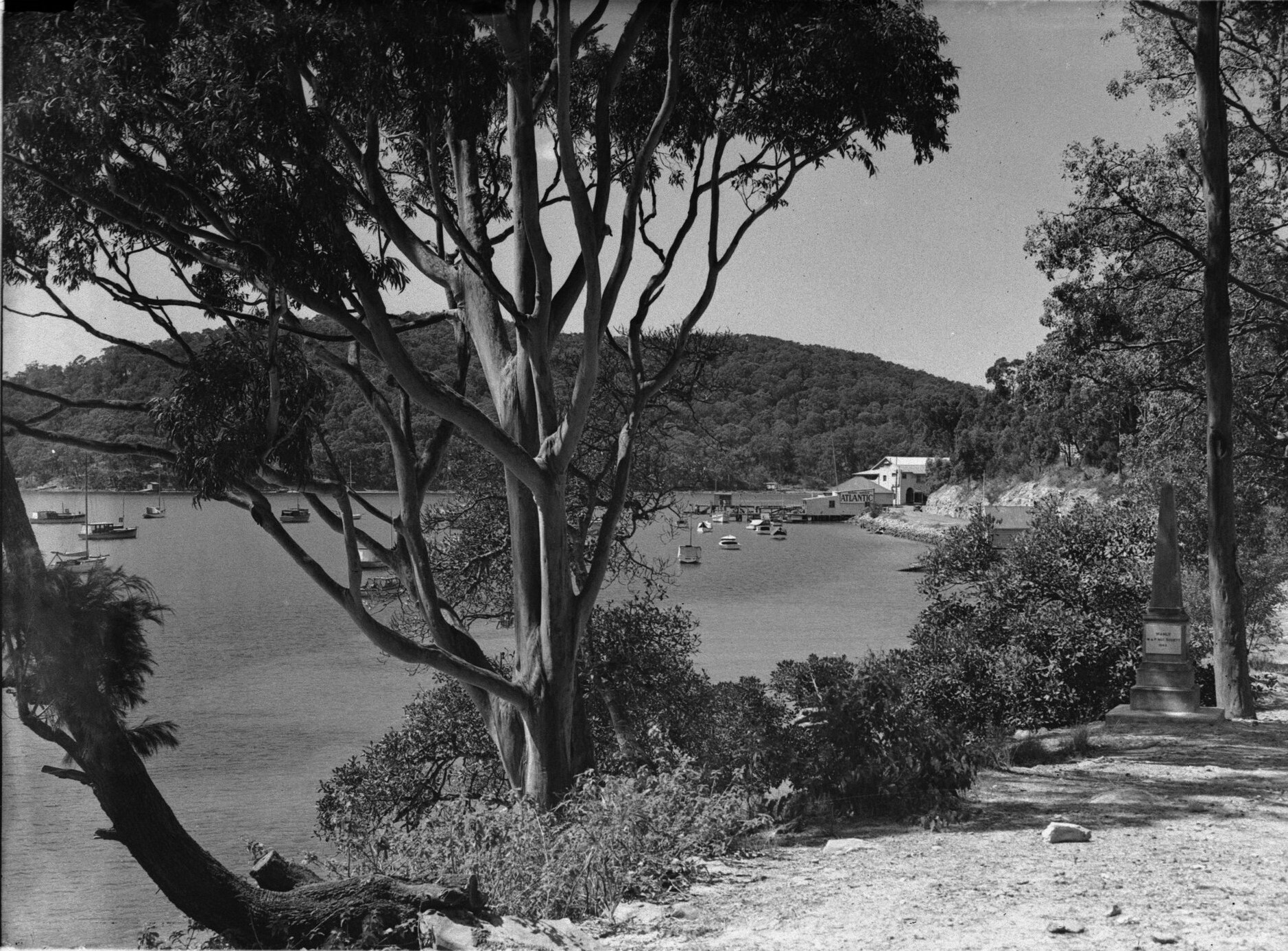
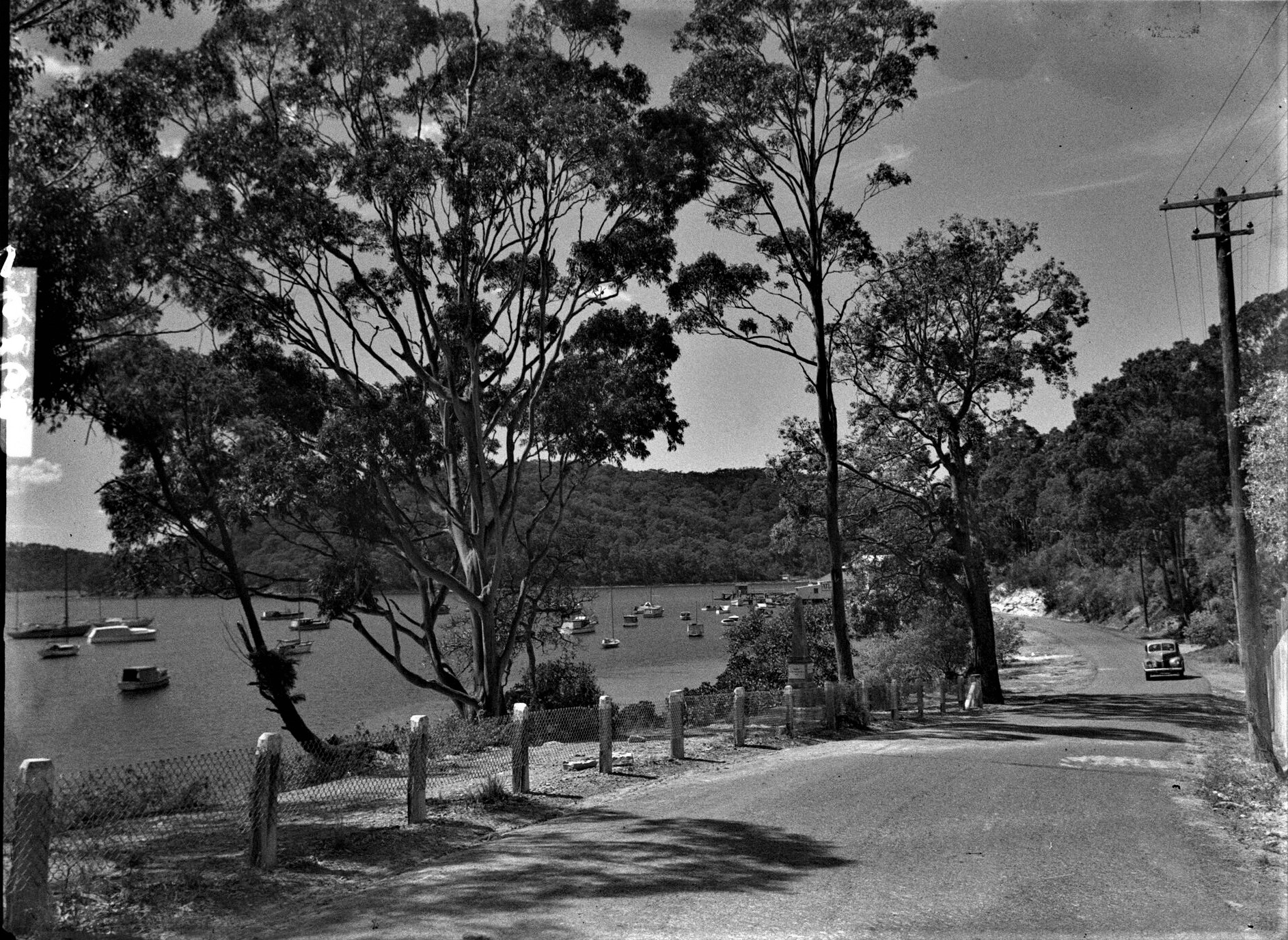
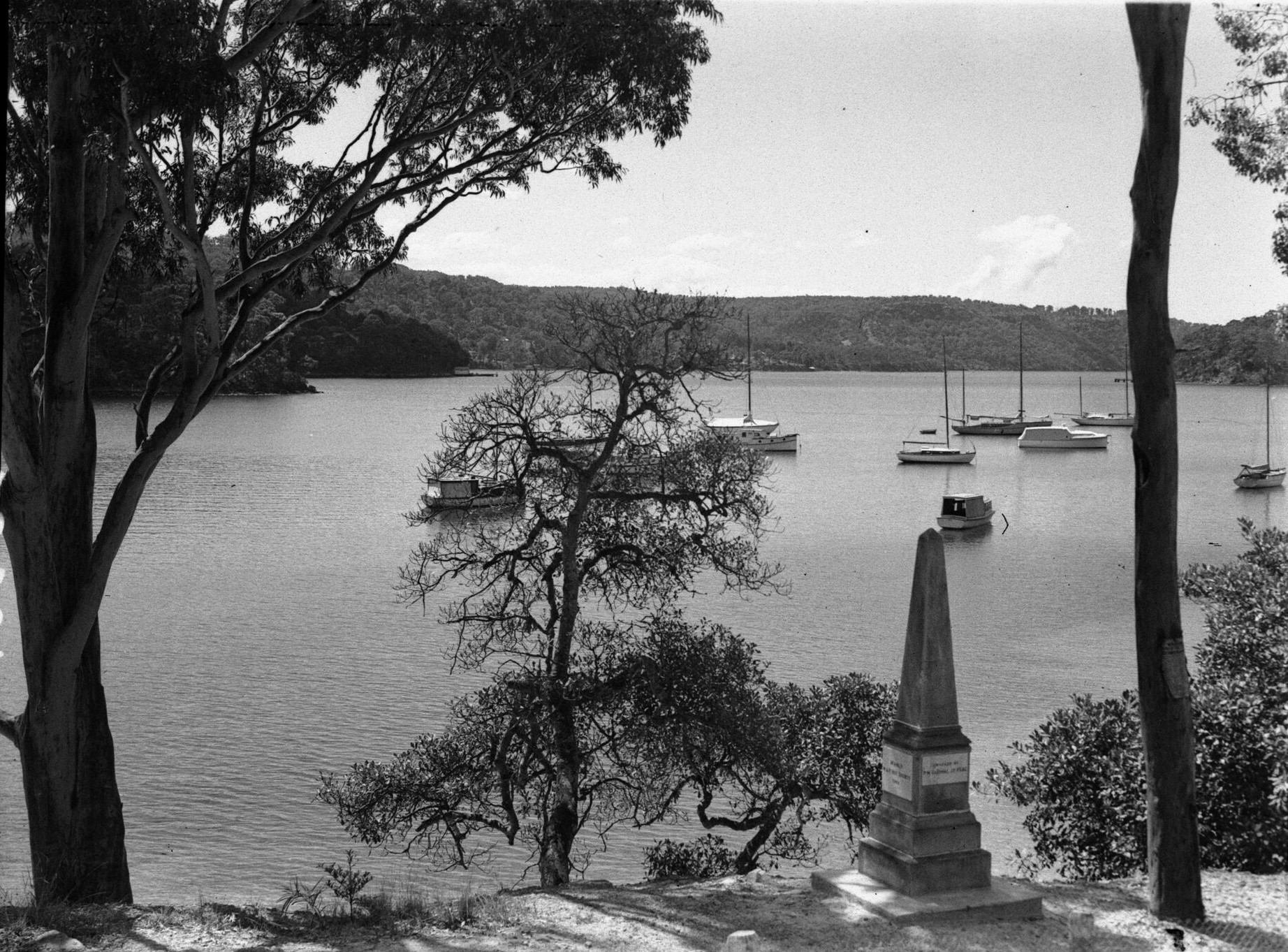
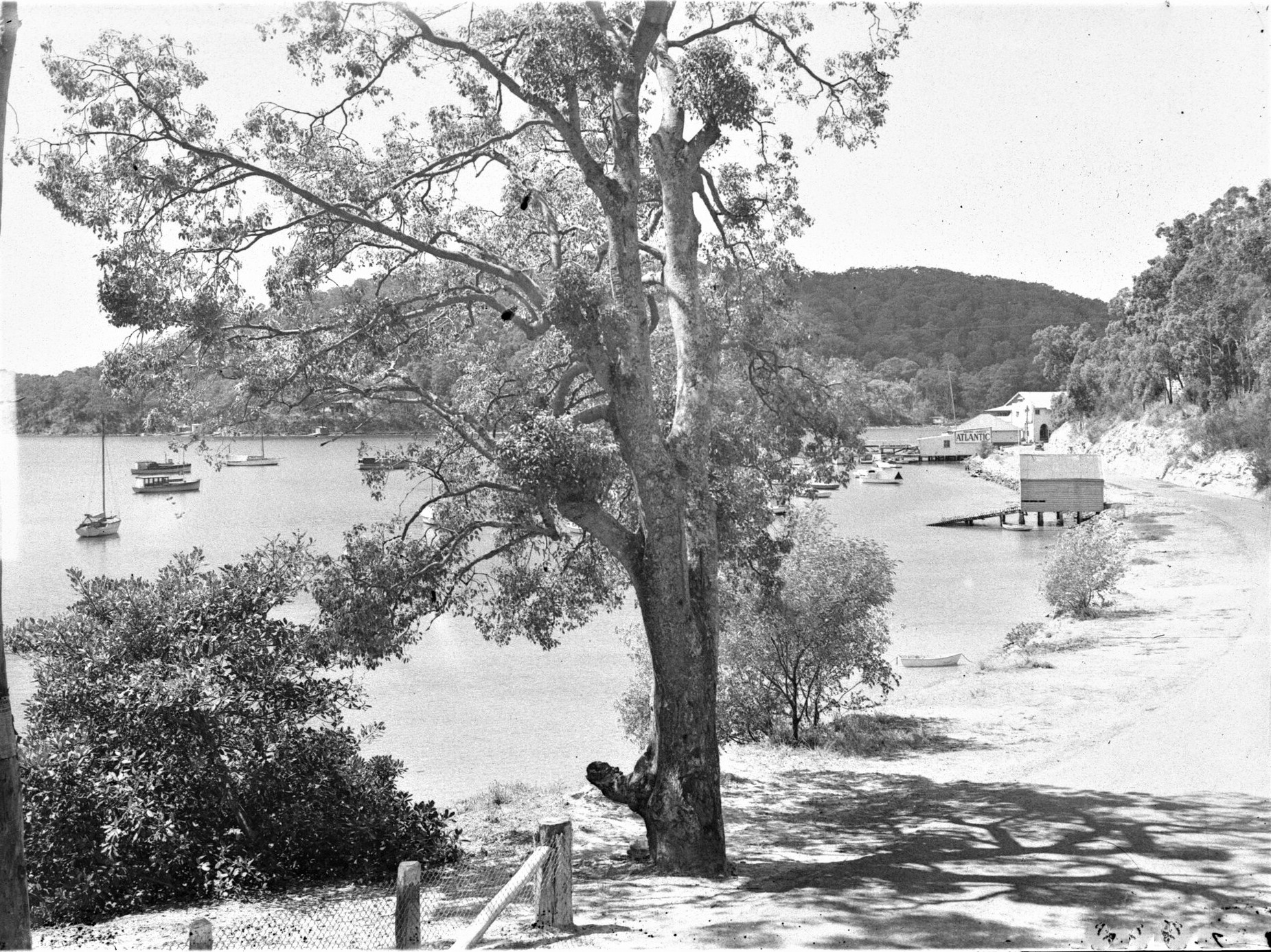
References - Notes
- TROVE - National Library of Australia
- Pittwater Roads II: Where The Streets Have Your Name - Church Point
- Church Point Precinct Upgrade Scheduled To Be Completed This Financial Year (2023-2024): Boardwalk Completed In December 2022 Now A Popular Suntrap For Residents + Visitors Beside The Estuary + Scotland Island Bells and Carol Wharf Upgrades Completed
- Church Point, Pittwater: Winter 2023 + Some Photos and Snippets From The Past

|
Longa Linga Church Point House Research Notes.pdf Size : 1464.524 Kb Type : pdf |
Quarter Sessions Road: A Quarter Sessions Road is a road established under the Public Roads Act following a reference to the Court of Quarter Sessions where no access to the nearest formed road exists.
This is the original McCarrs' creek road:
AN ACCOMMODATION ROAD
In conformity with the provisions of the Act of Council, William V , No 11, section 21, George Brown being the owner of portion No 6, parish of Narrabeen, applied to the Chairman of the Quarter Sessions for an accommodation road from his land to run through land supposed to be the property of trustees of the Wesleyan Church Dr Tibbetts and Alfred McIntosh being part of Olivers grant, portion 7, until it should meet the road from Manly, at the public wharf Church Point, Pittwater, such being the nearest highway. Evidence was given by the applicant that he had no thoroughfare nor right of away to get to a highway from his land as described consisting of 11 acres, and the accommodation road he now applied for was the best available, considering all the interests. No objection was raised to the road being made and the application was granted by His Honor. QUARTER SESSIONS. (1897, November 19). The Sydney Morning Herald (NSW : 1842 - 1954), p. 3. Retrieved from http://nla.gov.au/nla.news-article14100043
The track that led from Church Point to Brown’s estate was replaced some years ago by a narrow road to the spot where the house of David Walker stood, now a turning point for motorists. The portion through the old “Waterside” Estate was named ''Brown’s Road''.
WARRINGAH SHIRE COUNCIL.—Re-naming of Upper Section of Quarter Sessions Road, Church Point as Captain Hunter Road.—Notice is hereby given that the Council, in accordance with the provisions of section 249 of the Local Government Act, 1919, as amended, has re-named the upper section of Quarter Sessions Road, Church Point, as Captain Hunter Road. J. MORGAN, Shire Clerk, Shire Hall, Brookvale. 9337—$2.40 WARRING AH SHIRE COUNCIL.—RE-NAMING OF UPPER SECTION OF QUARTER SESSIONS ROAD, CHURCH POINT AS (1970, August 7). Government Gazette of the State of New South Wales (Sydney, NSW : 1901 - 2001), p. 3154. Retrieved from http://nla.gov.au/nla.news-article220163356
Some of those boatsheds and jetties along the McCarrs creek road during the 1940's - as per Mr. the 1945 photo above:
Parish Narrabeen, county Cumberland; Special Lease 29-10, Metropolitan, for boatshed. Land applied for—10 1/2 perches below high water of Pittwater, adjoining the public wharf at Church Point. Applicant—Richard Harold Costin. Objections may be lodged at the Land Board Office, Sydney. APPLICATIONS FOR LEASES FOR SPECIAL PURPOSES. (1944, March 31). Government Gazette of the State of New South Wales (Sydney, NSW : 1901 - 2001), p. 589. Retrieved from http://nla.gov.au/nla.news-article225094643
Parish Narrabeen, county Cumberland; Special Lease 31-56, Metropolitan, for boat-building, repairing and hiring. Area applied for—about 1 rood 20 perches below high-water mark at Church Point, Pittwater. Applicants—Aloysius James Joseph Glacken and Harold Henry Griffin. Objections may be lodged at the Land Board Office, Sydney.
Parish Narrabeen, county Cumberland; Special Lease 46-276, Metropolitan, for boat-hiring and repairing. Area applied for—about 18 perches below high-water mark of McCarr's Creek, Pittwater, adjacent to and south of Special Lease 45-181. Applicant—Harold Peter Mackay. Objections may be lodged at the Land Board Office, Sydney. APPLICATIONS FOR LEASES FOR SPECIAL PURPOSES. (1947, May 2). Government Gazette of the State of New South Wales (Sydney, NSW : 1901 - 2001), p. 1022. Retrieved from http://nla.gov.au/nla.news-article224768413
NORTH SHORE WEDDING
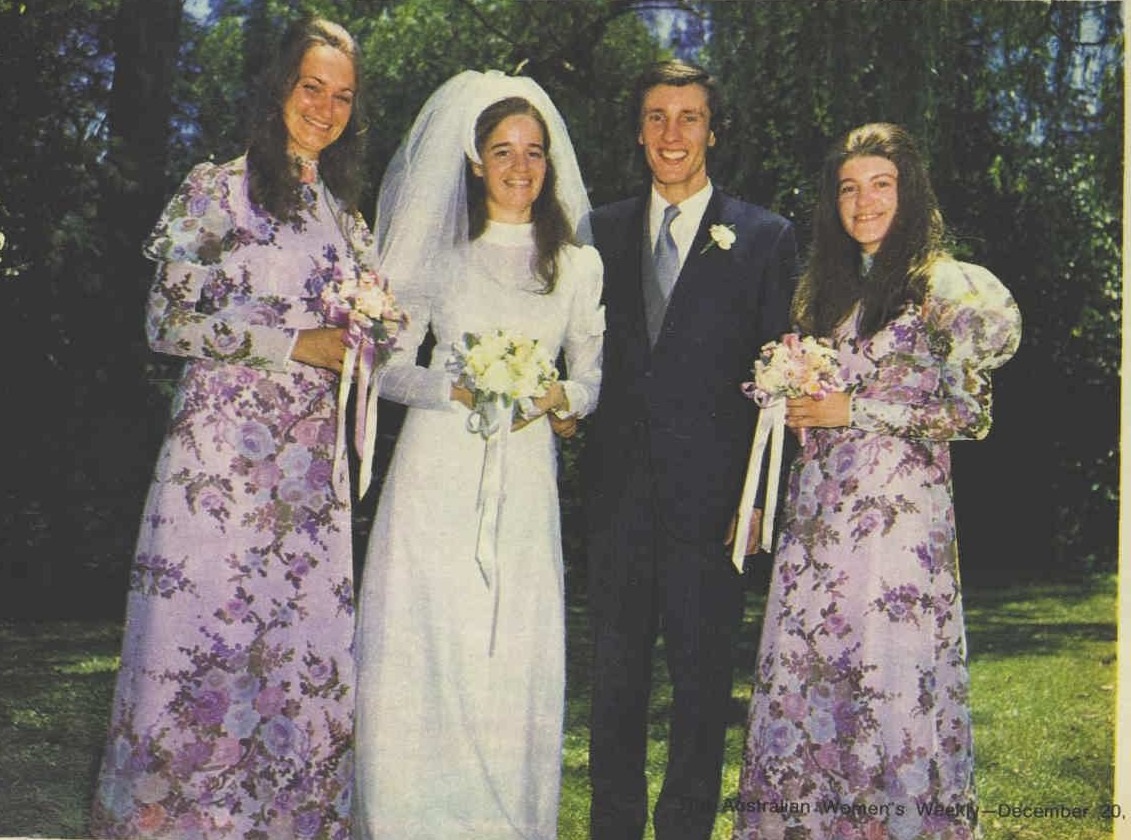
A reception in the garden of the St. Ives home of Mr. and Mrs. Norman Vivian followed the wedding at Christ Church, St. Ives, of their only daughter Victoria, to John Lamplough, elder son of Mr. and Mrs. Robert Lamplough, of St. Ives. The bride's embroidered swiss cotton gown had a high neck and leg o'mutton sleeves. Her attendants, Tricia Wachsmann, left, and Pam Sloan, wore chiffon gowns, similar in style to the bride's. WHAT PEOPLE ARE WEARING OVERSEAS (1972, December 20). The Australian Women's Weekly (1933 - 1982), p. 14. Retrieved from http://nla.gov.au/nla.news-article51196033
John Richard Lamplough, son of Jeremiah and Lucinda - Prohibition League (anti-alcohol drinking) when still at Goulburn:
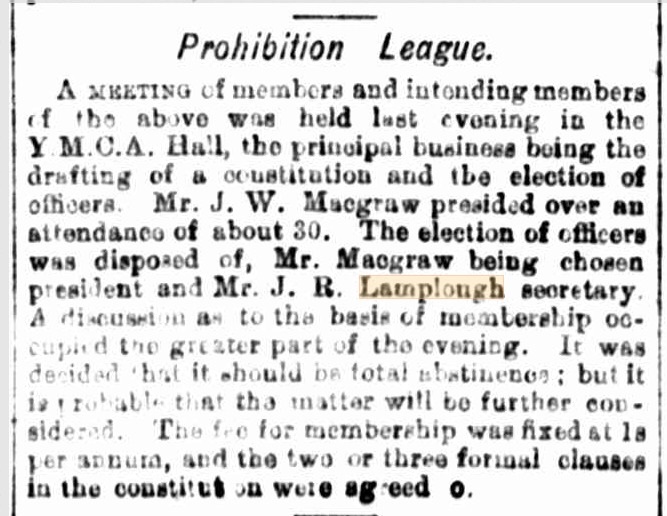
28 May 1891 - Prohibition League. - Trove J R Lamplough
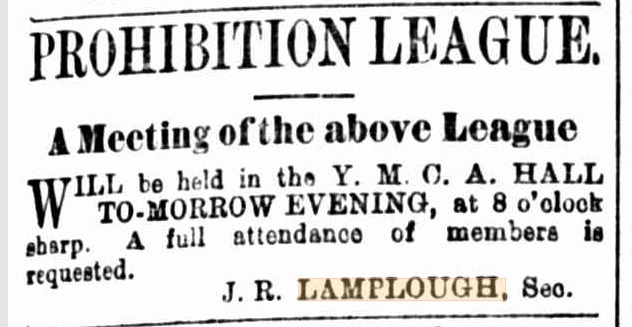
July 7th 1891 advertisement
The Australian Mutual Investment and Building Company, Limited, report having sold the following allotments in the subdivision of Eastgrove, Goulburn; ... lots 15 and 16; section 9, to Mr. Jeremiah Lamplough; lots 17 and 18, section 9, to Mr. Henry Lamplough. COMMERCIAL. (1883, September 25). Goulburn Herald (NSW : 1881 - 1907), p. 3. Retrieved from http://nla.gov.au/nla.news-article103794512
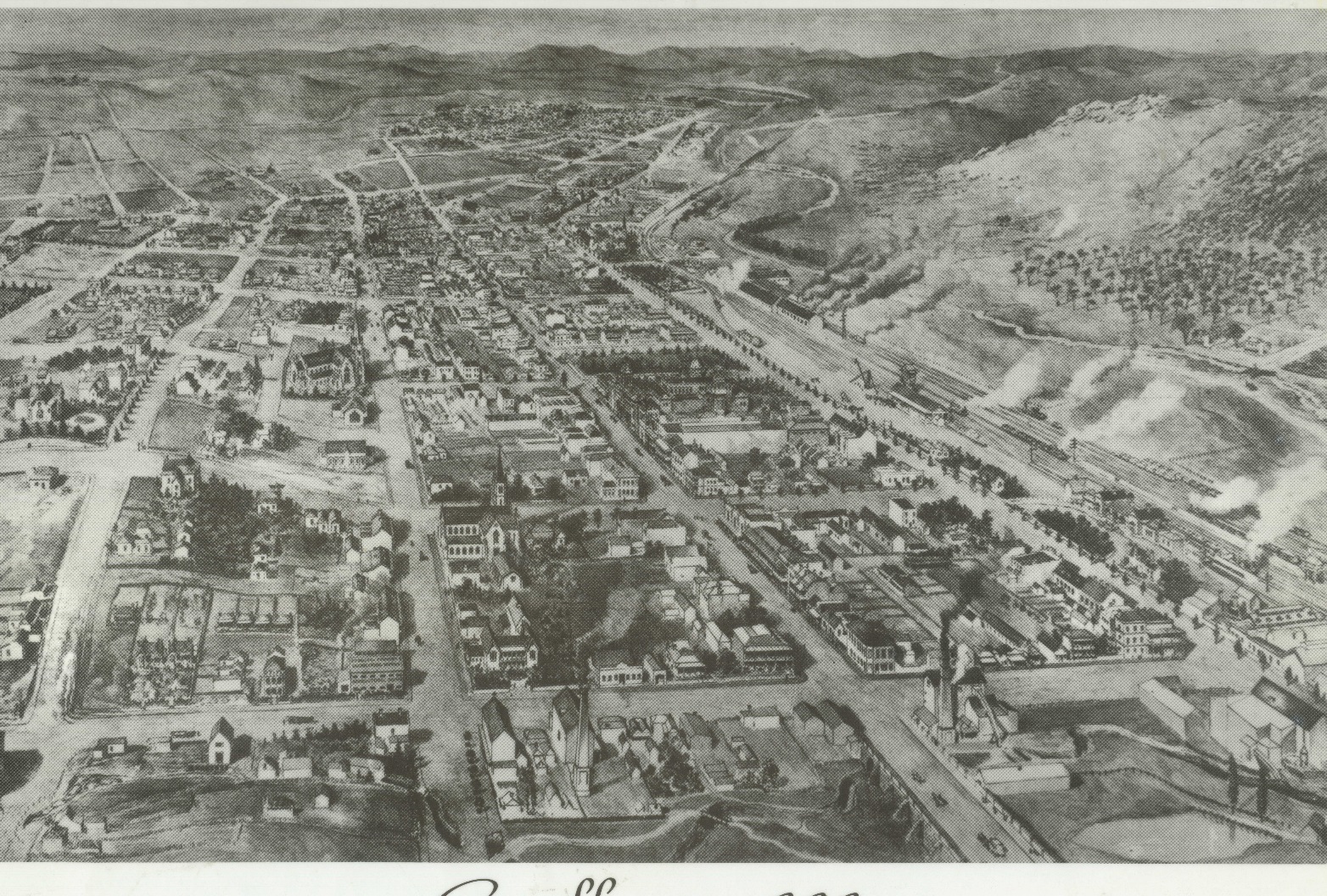
Goulburn 1888 - drawing. Photo courtesy Goulburn Mulwarre Library
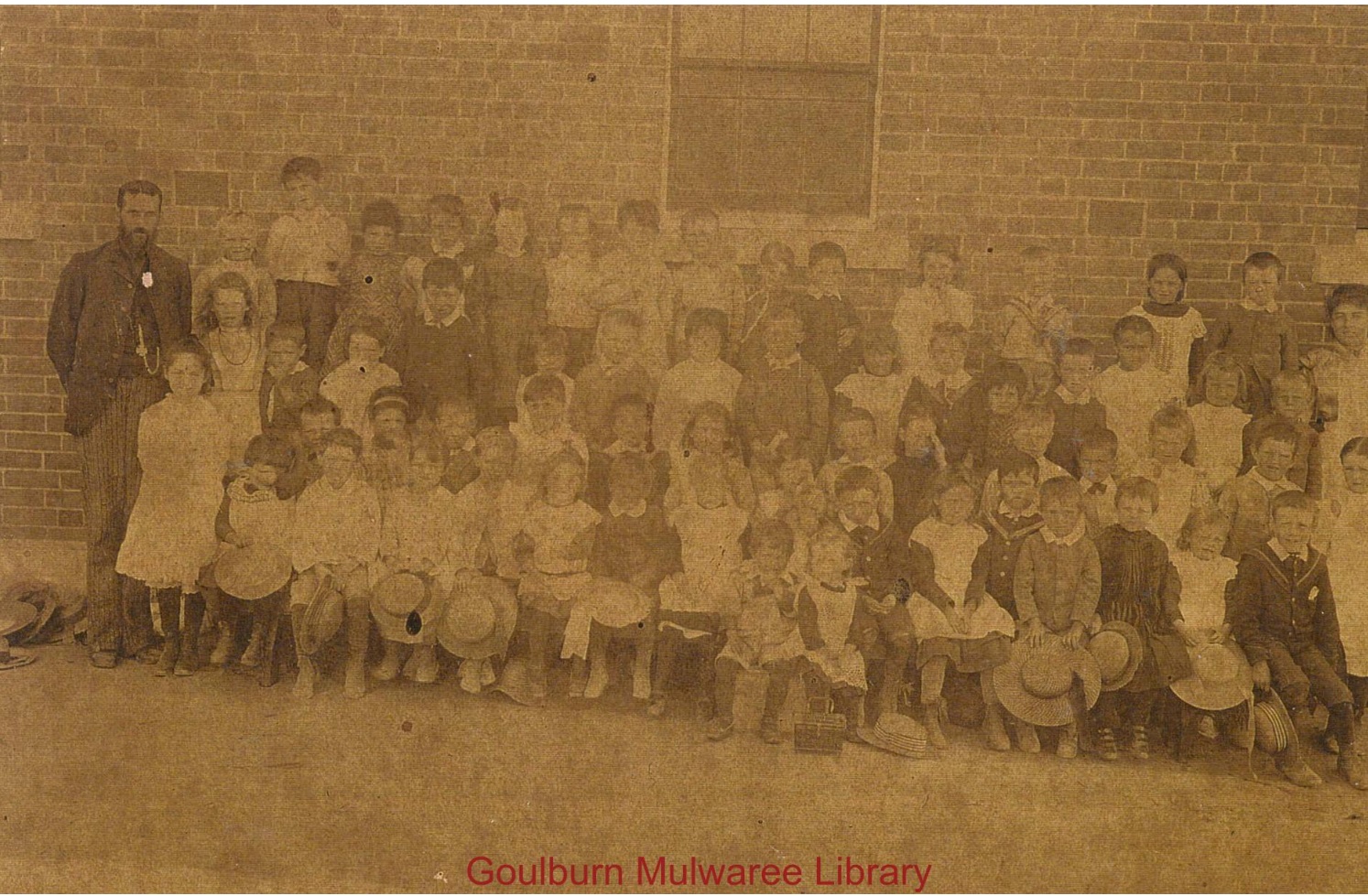
Eastgrove Public school circa 1890. Photo courtesy Goulburn Mulwarre Library
GENERAL NEWS.
The tender of J. R. Lamplough of Goulburn (£283) has been accepted for the erection of a cottage for Wharfinger, Coff's Harbor. GENERAL NEWS. (1894, September 5). Goulburn Herald (NSW : 1881 - 1907), p. 3. Retrieved from http://nla.gov.au/nla.news-article100440328
Rates paid From the 1906-7 Rate Book Goulburn:
ADA STREET EAST SIDE- 3462 dwelling Richards, Sarah (?) widow, Owner: Richards Sarah Section 30, Lot 6, frontage 66 feet.
CLIFFORD STREET SOUTH SIDE: BOURKE STREET: 400 vacant lot Lamplough Rich. - Lamplough Rich 10 13 ( 66) and 401 vacant lot Lamplough Rich. Owner of same.
CHARLOTTE STREET EAST SIDE: 3560/2 dwelling Lamplough Lucy, Owner: Lamplough Lucy. Section: 9 Lot: 15/21
REPRODUCTION OF SOUND
THE WESTERN ELECTRIC SYSTEM
In order to give some information about the working of the 'Talkie', plant to its readers, the 'Liberal' approached Mr. J. R. Lamplough, head engineer, Western Electric Co., who is responsible for its installation. In the following article, Mr. Lamplough gives lucid details of the construction and manipulation of the wonderful and almost human piece of mechanism now in operation at the Monarch-Empire Theatre.
The Western Electric reproduction of sound in theatres uses two systems— Movietone and Vitaphone. To the layman these two terms have no meaning whatsoever. So, for the benefit and general enlightenment of the 'Talkie' public, it has been suggested to me to give a brief explanation of just how the voices, etc., on the screen are recreated. .
Movietone means that the sound is recorded on and reproduced from the film itself, the sound being actually photographed on the film. Vitaphone means that the sound is recorded on and reproduced from a disc, run in conjunction with the film.
We shall take the Movietone system first. In the making of a Movietone film, the sound, or more technically 'speaking, sound waves, are picked up by extremely sensitive microphones, which are electrical instruments ,:for converting sound waves into electrical, impulses. These minute electrical impulses, which are exactly copies of the original sound waves, are amplified or magnified by ; many- stages of vacuum tube amplifiers, and are then made to control what is technically known as a. light .valve. , This light valve is an instrument which' opens and closes a -miniature shutter. The valve, which is really ii mechanical instrument, is . supplied with a constant source of light,; and passes a tiny beam of light on to the side of the film, which, by the way, is a negative film, and is also having a picture printed on it.
When the light, valve is closed no exposure is made on the film. This track down the side of the film is called the sound track. The sound track is approximately one-tenth of an inch wide, and has little black lines with clear spaces between them. Now this film, when the finished positive is made, is drawn through the reproducing- 'machine at. a constant speed. A tiny slit of light is focussed on to; the moving sound track of the film. This light, is derived from 12 volt banks of batteries, and it is absolutely constant and of an extremely high intensity. Let us see what happens. 'This light, as -I said before, is focussed right on to the. sound track. Well, now, when instantaneously a black line is in front of the light no light passes through the film. ' At the next instant, when the film has moved d fraction, the light shines right through the .-'sound' track between the preceding and succeeding, black lines. Thus,' as there are an infinite number, of black lines and clear, spaces, and as the film is being moved at a constant speed, we got. a series of light waves or fluctuations, corresponding in nature ,to the markings on the sound track of the film. These, light waves are then concentrated into what is technically known as a 'Photoelectric- cell.' This is, in reality, ail electric eye, which reproduces in electricity what; it sees in light. . Wo now have another electrical copy of the original sound waves. You will say, how does ono obtain sound with pitch, tone, volume, etc., from these electrical impulses? What happens is this. The impulses are magnified enormously, and are then made to actuate a -'horn receiver.' These receivers convert electricity into sound. The sound itself is then amplified by attaching the horn Teeojver to a wooden horn. This still does not explain where the pitch, and volume come from. Pitch is produced h; the frequency of the impulses.
Thus, if wo have a sound track with lines close together a high pitch .will result. Volume is produced by the contrast between black lines and clear spaces. Tone results from the conversion of sound to .electricity, ' to light, to electricity, and again to sound without distortion. In other words, the reproduced sound is a perfect, copy of its original. The vacuum tube amplifiers are similar, to ordinary wireless receivers, etc., except that they are of perfect quality and construction, and are much larger. The sound which you hear at the Monarch Theatre, say Maurice Chevalier speaking, has been amplified by seven valves before you finally hoar if as sound.
Some idea of how perfect the amplification must, be can be gathered from this fact, .that, when the sound is being, amplified, distortion, if present, is also being amplified. Now, you will say: how does the sound keep in', synchronisation with, the picture'? The answer is, just, because the picture and the sound come from the same piece of film at the same time. The projector head projects the light on to the sheet, and. at the same time the sound unit is reproducing the sound. Let us now return to the Vitaphone system. As before, the sound waves are converted, into electricity , and , are amplified, but this time they are converted into! mechanical vibrations, which cut an impression, in the grooves of a disc. This disCi.is run iii conjunction with the film and it turns at 33 1-3 revolutions' per minute, instead of the usual 78.
Also the needle is placed on the inside' of the record, not the outside, as the' usual phonograph record. Synchronisation is obtained by setting the film in the machine at a point marked 'start,' and also placing the needle on the record at a point marked 'start.'', As the film and the disc are driven by' the same motor at a constant' speed they must necessarily keep in step. Another thing to be explained is how the grooves of the record produce sound. What happens is this. As the needle passes through the grooves it is vibrated by the wavy nature of the sides of the grooves, thus producing mechanical vibrations in the needle. The needle is attached to a permanent .magnet..
As the magnet vibrates in a coil of ' wire it produces electrical currents; in the coil. Amplification and conversion to sound takes place as before. Perhaps the most important, thing of all in the reproduction of sound' from cither disc or film is to 'have both disc and film travelling at constant speed. This sound film is 90 feet per' minute. Constant speed is obtained by controlling each projector motor with an electrical governor , called a motor control, cabinet. Thus, regardless, of power supply, variations-, the motors still- keep up to speed. Two identical projector, machines are employed, this being necessary to have a continuous picture and Continuous sound. One machine is started up just before the. previous reel of film has run. through, so that at the precise moment a change is made, and sound and picture are then reproduced from the .other machine. Thus, a succession of changes between each reel produces a, continuous programme, Each projection machine is called a Universal Base, because any type of projector head can be mounted On it tor picture projection.
Each machine can run Movietone or Vitaphone at the will of the projectionist. The change from Movietone to Vitaphone (film to disc), or vice 'versa, is made by a simple switch oil the front, of each machine. The next, question is: Where does the sound come from?,' 'Well, it comes right through the picture sheet, or screen. One, two or three wooden horns of true .exponential typo are located two-thirds the height of the picture. Thus, when a person's imago is projected on to the screen, their head is approximately two-thirds of the way up the picture., The result is that the illusion that the sound is actually coining from the speaker's mouth is kept, and the picture' becomes life-like. The screen itself is made of a rubberised material with myriads of small holes through it. These holes permit the sound to pass through it practically unobstructed. This little explanation, I think, will be no doubt somewhat of a revelation to many. but it will serve to answer many of the questions regarding 'The Talkies. 'REPRODUCTION OF SOUND (1930, April 25). The Dubbo Liberal and Macquarie Advocate (NSW : 1894 - 1954), p. 8. Retrieved from http://nla.gov.au/nla.news-article132088551
He then went into sharebroking just over a year before he passed away - his eldest son John Richard Lamplough (1910-1943) was the broker of Lamplough-Wharton for the Minerva venture:
Mr. J. R. Lamplough, has been elected a member of the Sydney Stock Exchange. Financial Editor's Diary (1946, August 7). The Sun (Sydney, NSW : 1910 - 1954), p. 15 (LATE FINAL EXTRA). Retrieved from http://nla.gov.au/nla.news-article231580289
Mr. Cleland Niebel Malcolm has been elected a member of the Sydney Stock Exchange. Financial Editor's Diary (1946, March 1). The Sun (Sydney, NSW : 1910 - 1954), p. 10 (LATE FINAL EXTRA). Retrieved from http://nla.gov.au/nla.news-article228799717
Messrs. Robert H. G. Lamplough and Cleland N. Malcolm, members of the Sydney Stock Exchange, have entered Into Partnership as stock and sharebrokers. The business will be conducted under the name of Lamplough and Malcolm. Financial Editor's Diary (1946, August 28). The Sun (Sydney, NSW : 1910 - 1954), p. 14 (LATE FINAL EXTRA). Retrieved from http://nla.gov.au/nla.news-article231572956
Cleland Niebel Malcolm was appointed a JP in 1951. He passed away in 1968, the death registered at St Leonards.
TAKE notice that as from 30th September, 1974, Timothy Ronald Crammond has retired from the firm of Lamplough & Malcolm and the business of this firm is now carried on by Robert Henry Grant Lamplough, Phillip William Averill and Hugh Jeremy Middleton. LAMPLOUGH & MALCOLM. 4490—$2
John Lamplough, the brother who came out with Jeremiah to Australia(?):
THE LATE MR. JOHN LAMPLOUGH.
After months of intense suffering from the effects of heart disease Mr. John Lamplough, licensee of the Australian Hotel, breathed his last at his home yesterday morning. It was known for some weeks that his condition was extremely critical and that the end might come at any moment, consequently the sad news occasioned little surprise. Notwithstanding his serious condition the patient up to a short time before the spirit fled was extremely hopeful, and with apparent cheerfulness informed his many callers that he would soon be as well as ever he was, but it was simply another instance of the truism " Man proposes but God disposes."
We first made the acquaintance of our late old townsman about forty years ago at Grenfell, he then being in the employ of the late Mr. Donald Nelson, cordial manufacturer in that town. Something over a quarter of a century ago he came to Cowra and started cordial making on his own account, and later still he became licensee of the Australian Hotel, where he succeeded in working up a good connection and amassing a fair share of the world's wealth, it may be thus understood that his popularity as a business man was firmly established. On the occasion of the Coronation celebrations he visited England with one of his sons, and on his return to Cowra derived infinite pleasure from narrating his experiences and sundry interesting incidents that came under his notice. He was a native of Yorkshire, England, and arrived in Sydney about 46 years ago, he being then in his 20th year. About two years after coming to the country he went to Grenfell, and after residing there for over 20 years he settled in Cowra where he continued to the end of his days. He married Miss Sarah Jones at Lithgow about 30 years ago by whom he leaves issue a grown up family of three sons and three daughters, including Oswald, Sydney, George, Mrs. G. Leahy (Back Creek), Kate and Daisy. Two boys died in their infancy.
The funeral will move to-day at 2.30 from the Australian Hotel for the C. of E. cemetery. THE LATE MR. JOHN LAMPLOUGH. (1912, November 30). Cowra Free Press (NSW : 1911 - 1937), p. 4. Retrieved from http://nla.gov.au/nla.news-article99633699
John Lander Browne and his wife passed away within a few months of each other in 1970 - Mr Browne was aged 63, his wife 55:
IN the Supreme Court of New South Wales.—Probate Jurisdiction.—In the will of JOHN LANDER BROWNE, late of St Ives, in the State of New South Wales, architect, deceased.— Letters of administration granted by Supreme Court of New South Wales on 5th February, 1971.—Pursuant to the Wills, Probate and Administration Act, 1898-1940, the Testator's Family Maintenance and Guardianship of Infants Act, 1916-1938, and the Trustee Act, 1925-1940, Robert Henry Grant Lamplough, the legal representative of Georgina Laura Browne, the executrix named in the will of the said John Lander Browne, who died on 3rd January, 1970, hereby gives notice that creditors and others having any claim against or to the estate of the said deceased are required to send particulars of their claims to the said executrix in care of the undersigned at their office hereunder mentioned on or before the 26th March, 1971, at the expiration of which time the said executrix will distribute the assets of the said deceased to the persons entitled, having regard only to the claims of which she then has notice.—Dated this 22nd day of March, 1971. CHURCH & GRACE, Solicitors, 34 Hunter Street, Sydney. 2797—$4 IN the Supreme Court of New South Wales.—Probate Jurisdiction.—In the will of JOHN LANDER BROWNE, late of (1971, March 26). Government Gazette of the State of New South Wales (Sydney, NSW : 1901 - 2001), p. 1027. Retrieved from http://nla.gov.au/nla.news-article220053395
IN the Supreme Court of New South Wales.—Probate Jurisdiction.—In the will of GEORGINA LAURA BROWNE, late of St Ives, in the State of New South Wales, married woman, deceased-—Probate granted by Supreme Court of New South Wales on 17th September, 1970.—Pursuant to the Wills, Probate and Administration Act, 1898-1940, the Testator's Family Maintenance and Guardianship of Infants Act, 1916-1938, and the Trustee Act, 1925-1940, the substituted executor of the will of the said Georgina Laura Browne, who died on 8th March, 1970, hereby gives notice that creditors and others having any claim against or to the estate of the said deceased are required to send particulars of their claims to the said executor in care of the undersigned at their office hereunder mentioned on or before the 6th day of January, 1971, at the expiration of which time the said executor will distribute the assets of the said deceased to the persons entitled, having regard only to the claims of which he then has notice.— Dated this 29th day of October, 1970. CHURCH & GRACE, Solicitors, 34 Hunter Street, Sydney. 714—$4. IN the Supreme Court of New South Wales.—Probate Jurisdiction.—In the will of GEORGINA LAURA BROWNE, late (1970, November 6). Government Gazette of the State of New South Wales (Sydney, NSW : 1901 - 2001), p. 4471. Retrieved from http://nla.gov.au/nla.news-article220044676
Lucy Richards 1 acre, 3 roods and 6 1/2 perches:
Lucy Richards (Lamplough) Lot 1 of the Church Point Estate - note that the 'Quarter Sessions Road' is still the way to Browns' 41 acres and is not the name of the track/road at the back of Church Point Cemetery and going up the hill as yet - this is years prior to this track/path becoming a road and renamed 'McCarrs Creek Road'.
Lot 1 - Longa Linga land
Lot 1 sold to William Newcombe on November 22nd 1912 Vol/Fol: 2321-4. 1 acre, 3 roods 6 ½ perches. Permanent Trustee Co becomes in charge June 11th 1917; they sell to Alfred Ernest Burton, Printer, May 20th 1918, Burton to Frederick Wymark Bookseller, on March 19th 1930, Wymark to Lucy Richards October 12th 1933, she sells part to Lawrence Edward McDonnell of part (Vol/Fol: 5444-118 – April 24th 1944 – 1 acre 34 ½ perches) and retains Vol/Fol: 5465-29; 2 roods and 12 perches remains hers (2326.90 square metres) and is sold by Browne and Lamplough in 1951 after her Will passes probate
Today the property has 2,068m² of land.
Lucy acquires Lot 1 on October 12th 1933 from Frederick Wymark who had purchased it from Alfred Burton in 1930- :
.jpg?timestamp=1694115953546)
.jpg?timestamp=1694115995121)
.jpg?timestamp=1694116186890)
.jpg?timestamp=1694116283975)
.jpg?timestamp=1694570921988)
The residue of Lucy's land at Church Point, 2 roods 12 perches, or 2326.90 square metres, with the home and land sold by Browne and Lamplough in December 1950 after her Will passes probate in 1951:
.jpg?timestamp=1694116845508)
.jpg?timestamp=1694117765406)
.jpg?timestamp=1694117809989)
.jpg?timestamp=1694117852229)
Lucy sells one acre, 34 and one half perches to Lawrence McDonnell of Manly, Medical Student in 1944 who onsells to the Wrights in 1957:
.jpg?timestamp=1694571931646)
.jpg?timestamp=1694571970581)
.jpg?timestamp=1694572048430)
.jpg?timestamp=1694572095088)
McDonnell sells to Wright family and then they onsell accessway to Cambourn (see above) - Volume/Folio 127-210 refers to part of the God's acre that was sold to the Wrights by McDonnell - see below.
.jpg?timestamp=1694117389341)
.jpg?timestamp=1694117443746)
.jpg?timestamp=1694117567747)
.jpg?timestamp=1694117602715)
Percy Cambourn has 2 roods 7 3/4 perches after transferring an access way to Owen and Frank Wright - this is still present in the landscape:
.jpg?timestamp=1694118239122)
.jpg?timestamp=1694117693260)
.jpg?timestamp=1694118285687)
.jpg?timestamp=1694118320094)
Percy Cambourn sells to Herbert Stuart Jeskie and Margaret Lauder Jeskie of Church Point, formalised in September 1955 with the Certificate of Title registered in October who then onsells to Leslie John Miller of Narrabeen, Company Director, with him being registered as the owner in September 1960:
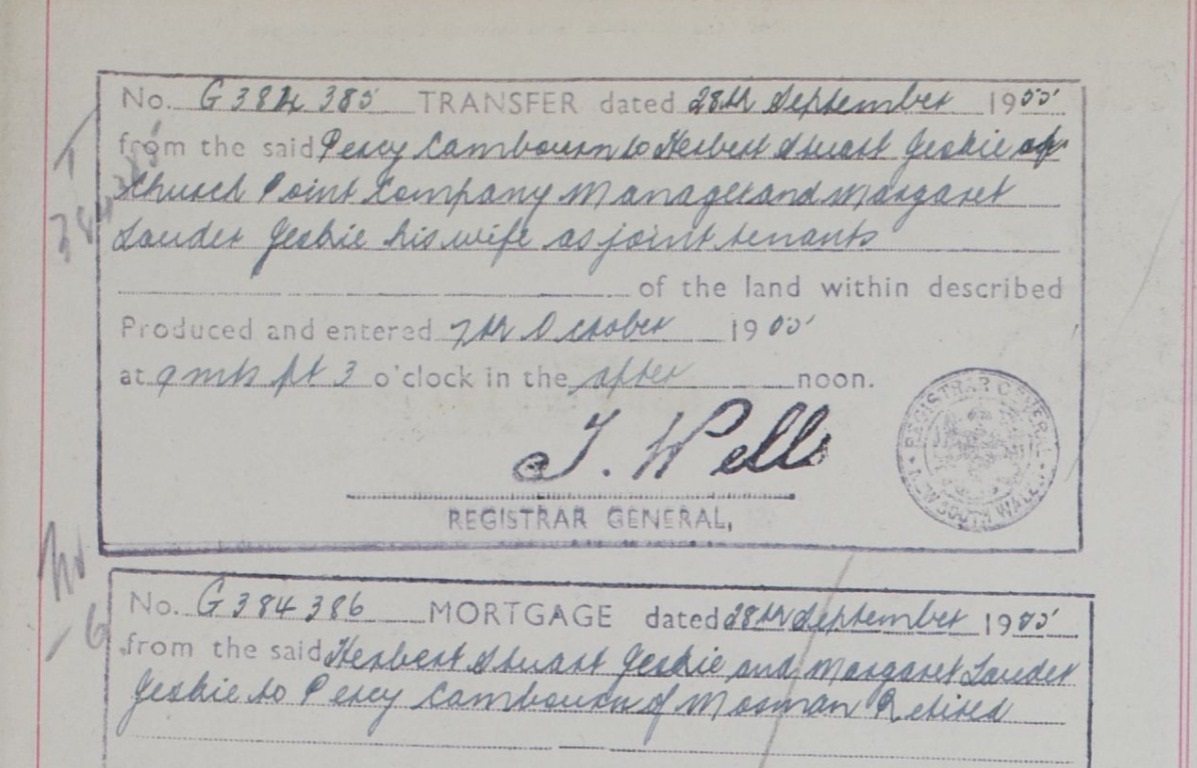
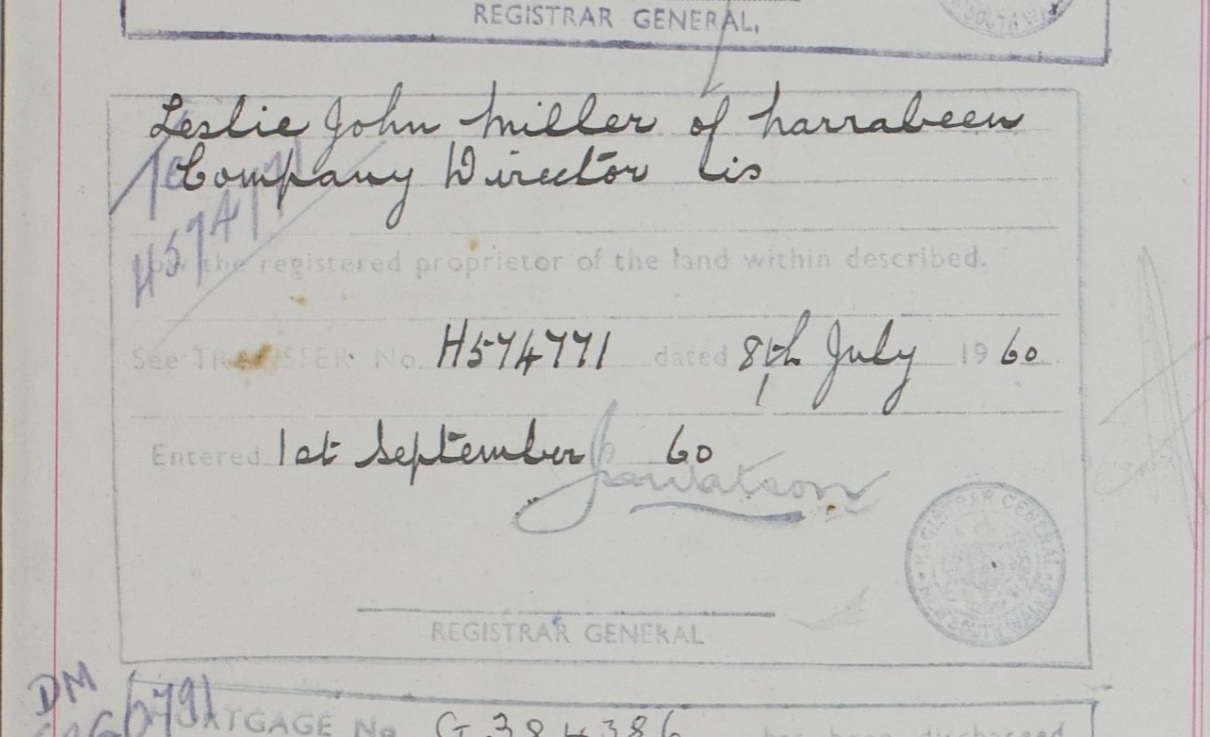
Kuring-gai Chase.
(By the Hon. Secretary.)
No. 1.
Not a few of my acquaintances recently have accosted me with the query, 'What the mischief is the meaning of Kuring-gai Chase Trust, under which your name seems frequently to appear?" Not that many of my querists get hold of the correct pronunciation of this euphonious aboriginal name. To those unacquainted with the dialect of our predecessors, I might suggest that the first vowel is long, as also is the last. The 'Kuring-gai' were the coastal tribe of blacks occupying the country between the Hawkesbury and Broken Bay, and therefore the hunting grounds and apparently camping place of some of these native gentry was, after them, aptly named Kuring-gai Chase.
For years past those whose vocations have necessitated the study of the archives of the Lands Department will have noticed a huge blank space on the map of the northern end of the county of Cumberland, extending along the Hawkesbury and its tributary, Cowan Creek, from Church Point, Pittwater, round to the Hawkesbury Bridge; and, though the land was long open to selection, only a few of the scattered beaches proved tempting enough to induce the settler to mark out his 40 acres. The reason to those acquainted with the country is obvious. Not any 40 contiguous acres would feed a goat, or at any rate fatten one.
By a fortuitous circumstance a gentleman, whose philanthropic exertions helped to open up the Blue Mountains to the tourist, struck, in the Hon. Hy. Copeland (the then Minister for Lands), a kindred spirit, and between these gentlemen the idea was evolved of conferring upon the metropolis a boon, for which, our grandchildren will probably immortalise them. By the dedication of this tract of country 53,000 acres in area, as a national park to the northern suburbs, an opportunity is afforded of preserving for many years to come the many distinctive classes of native flora so fast disappearing. The writer, though still a comparative youngster, can remember when Christmas bush, tree ferns, and stag-horns could be gathered on a Sunday morning's ramble; while as a schoolboy the collection of a satchelful of five corners and geebungs formed the customary Saturday morning's amusement. Alas! those innocent delights seem to have gone for ever, and their places have been changed for an investment of 6d or 1s in a silver double. O tempora! O mores!
Barren, rugged, and precipitous though the great proportion of this reserve is, still its rocky fastnesses have proved a nursery for many of the numerous orchid family, for the graceful tree fern and the stately cabbage-tree palm.
The ruthless gathering of the most attractive of our active evergreens for decorative purposes at festive seasons, combined with the insane craze for packing together (like sardines in a box) huge bunches of flowers at native flower shows (the great majority of which have been pulled up by the roots), has decimated entirely the baronia, the heath, the Christmas bush, Christmas bell, waratah, and other well-known indigenous flora. With a view to the protection of at any rate the surviving members of our fast dying vegetable family, Kuring-gai Chase has been dedicated to trustees, who have framed regulations intended, not to interfere with full enjoyment of the beauties of the reserve, or the study of its many objects of botanical and aboriginal interest, but to prevent the removal of specimens and destruction of kitchen middens, native carvings, etc., of which there are not a few.
It is not contemplated by the trust that in the immediate future to do anything more than preserve, as far as they can, a piece of natural Australian bush, together with, if possible a few of its feathered inhabitants. And there a note to would-be sportsmen. Spare our woodpeckers and kingfishers, and kookaborras and tomtits. Of wildfowl we have none. I have traversed the Chase from end to end, and though here and there a black cockatoo might be seen, or perhaps a morepork, nothing worthy of a No. 6 cartridge has crossed my path; and yet I am told parties of three and four guns have been seen in parts unaffected by our special constables, and their game-bags if searched would disclose, doubtless, nothing larger than a red-breast or diamond sparrow. I may here state that the carrying of firearms on the Chase is punishable by a fine and confiscation of the weapons, and though our constables have instructions to rigidly enforce these penalties, we look principally to a right-minded public, by example and precept to assist us in our difficult task.
The Chase was dedicated in September of 1894, and vested in the following trustees: Hon. Hy. Copland (president), Sir. Joseph Abbott, J. de V. Lamb, T. A. Dibbs, F. A. Wright, Dr. J. C. Cox, W. J. Lyne, Hon. R. H D. White, E. du Faur; the last-named having recently been appointed managing trustee. Since this date a sum of £600 in all has been received from the Government, and in my next article I shall endeavor to give my readers a short account of the manner of its expenditure, the methods adopted and objects in view, as well as a few suggestions as to reaching the most interesting portions of this huge water park. Kuring-gai Chase. (1896, July 17). Evening News (Sydney, NSW : 1869 - 1931), p. 3. Retrieved from http://nla.gov.au/nla.news-article111034334
William Oliver - land grant at Church Point: 66 acres east of Browns' 41 acre grant.
William Oliver Church Point land – Vol- Fol 115-110 – 1871 - becomes Vol Fol 129-63 after God’s Acre taken out becomes, which is sold to Thomas Wilson and Charles Johnson Vol Fol 225 – 202 (Wilson; 23 acres 3 roods) and 225-202 (Johnson; 40 acres – the 1 acre for church came out of this – transferred lodge 22nd April 1884) Charles Johnson sells 37 acres of his land to Walter Hugh Tibbitts MD of Manly Vol-Fol 776-65 – the residue is in Vol Fol 740-4 – 2 acres
Thomas Wilson: Vol – Fol 225- 201
23 acres – sells one lot to Ada Pritchard and 16 acres to de Kantzow – 7 acres residue.
October 27th 1890 – Benjamin James and John Redman to Edith Maude Baker – same date from Edith to Benjamin James of Sydney
December 22nd 1890 – Benjamin James to Philip Charley of Belmont Park, Richmond, Esquire
August 30 1911 Philip Charley to Arthur Morris Simpson of Pittwater, Grocer
August 30 1911 Mortgage from Arthur Simpson to Samuel Hordern of Sydney, merchant – entered in Certificate of Titles September 18, 1911
Simpson’s father knew him – they were neighbours at Woollahra:
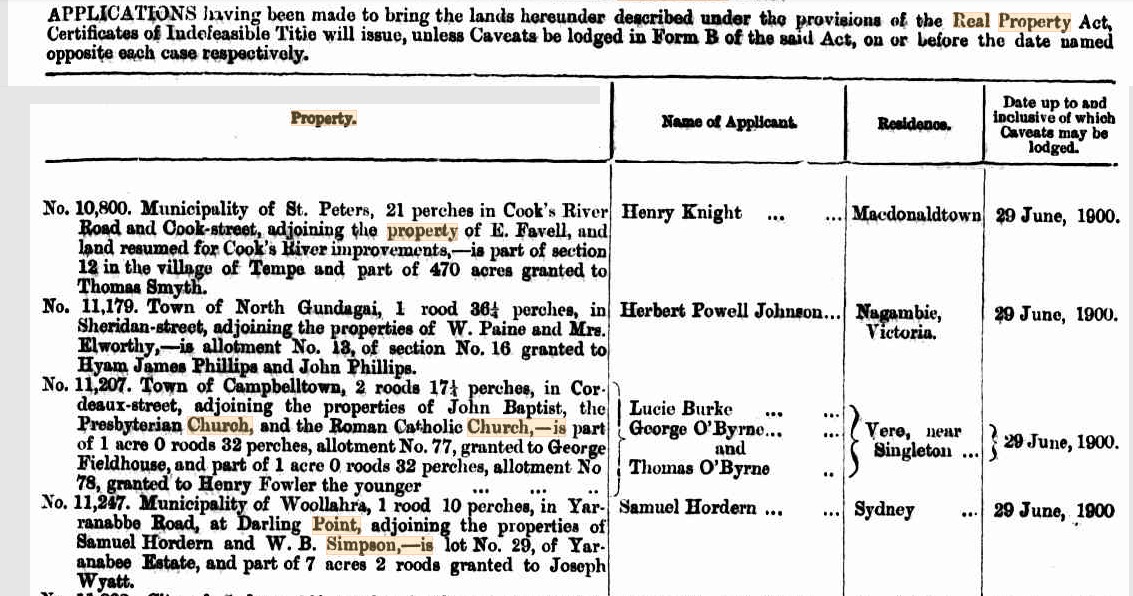
NOTICE UNDER REAL PROPERTY ACT. (1900, May 11). New South Wales Government Gazette (Sydney, NSW : 1832 - 1900), p. 3669. Retrieved from http://nla.gov.au/nla.news-article222498592
December 22 1911 – Arthur Morris Simpson, with consent of Mortgagee to Ada Ellen Pritchard, wife of James Gray Pritchard of St. ? - Vol Fol 2700-110: 1 rood 33 ¼ perches on Bay View Road - The Melrose property was transferred by Benjamin James to Philip Charley on 22 December 1890; then by Charley to Arthur Morris Simpson on 30 August 1911; and then by Simpson to Mrs Ada Ellen Pritchard on 22 December 1915. It remained in the Pritchard family as a private residence.
Vol Fol 3168-174: Charles Adolphus de Kantzow – 16 acres the ‘residue of the land’; Simpson Garden and then Baroona Estate – Simpson held onto 7 acres?
The Green Frog property (lots 7, 8, 21 and 22 with a house on lot 7, on the above map) was transferred by Simpson to de Kantzow and then to Herbert L. Alford and his wife on 4 February 1923, and remained the property of the Alfords.
In February 1923 the property was purchased by Herbert Lionel Somerset Alford ( 5th of November, 1876 – 28th of May 1947) and his wife Ida Mary, nee Griffiths (?- 1970) whom he married in 1908 (registered at Mosman). Mr Alford was the eldest son of Charles George Alford who became a chief in the Bank of New South Wales Their land comprised Lots 7, 8, 21 and 22. A dwelling on Lot 7 becomes the premises at which the Alfords run their tearooms and boarding house called ‘The Green Frog’.
On 11 November 1929 Herbert Lionel Alford transfers Lot 15 & 15A to Frederick Wymark of Sydney, bookseller. Wymark has a mortgage to Alford which is discharged on 27 December 1933. 1934 On 2 January 1934 Frederick Wymark transfers Lots 15 & 15A to Herbert Lionel Alford (who had owned the lots previously). Lots 15 and 15a become Warringah Shire Council land and are a reserve. It is these that Lucy Richards wants the public lavatories in front of her home around the corner moved to.
Lot 1 - Longa Linga land
Lot 1 sold to William Newcombe on November 22nd 1912 Vol/Fol: 2321-4. 1 acre, 3 roods 6 ½ perches. Permanent Trustee Co becomes in charge June 11th 1917; they sell to Alfred Ernest Burton, Printer, May 20th 1918, Burton to Frederick Wymark Bookseller, on March 19th 1930, Wymark to Lucy Richards October 12th 1933, she sells part to Lawrence Edward McDonnell of part (Vol/Fol: 5444-118 – April 24th 1944 – 1 acre 34 ½ perches) and retains Vol/Fol: 5465-29; 2 roods and 12 perches remains hers (2326.90 square metres) and is sold by Browne and Lamplough in 1951 after her Will passes probate
Today the property has 2,068m² of land.
Next door, and over one block towards east in today's residential blocks settings, was the Church Point church, school and graveyard. The pathway up to Quarter Sessions Road as it is today, up the back of the church yard and God's acre, was the Reserve Road marked in Thomas Wilson's acreage on the other side of that current pathway.
.jpg?timestamp=1694114614674)
.jpg?timestamp=1694114649913)
.jpg?timestamp=1694114720989)
.jpg?timestamp=1694114752330)
.jpg?timestamp=1694114792925)
William Oliver to Charles Johnson and Thomas Wilson - 65 acres left after Gods' Acre for church, school and cemetery given to the community, and church for safe keeping, by William Oliver:
.jpg?timestamp=1694114396717)
.jpg?timestamp=1694114504222)
.jpg?timestamp=1694114841093)
Charles Johnson to Walter Hugh Tibbitts -
Mr. Johnson owns the land, 40 acres, 16 perches officially on February 14 1883 - he on sells to Tibbitts on December 30 1884:
.jpg?timestamp=1694114924721)
.png?timestamp=1694114976245)
.jpg?timestamp=1694115202162)
.jpg?timestamp=1694115248403)
Charles Johnson retains 2+ acres - this became the site of 'Rostrevor':
.jpg?timestamp=1694115295729)
.jpg?timestamp=1694115334323)
.png?timestamp=1694115395270)
.jpg?timestamp=1694115437036)
Walter Hugh Tibbits, 37 acres, 2 roods and 9 perches to all those that came:
.jpg?timestamp=1694115702842)
.jpg?timestamp=1694115756740)
.jpg?timestamp=1694115809988)
.png?timestamp=1694115842336)
.jpg?timestamp=1694115880366)
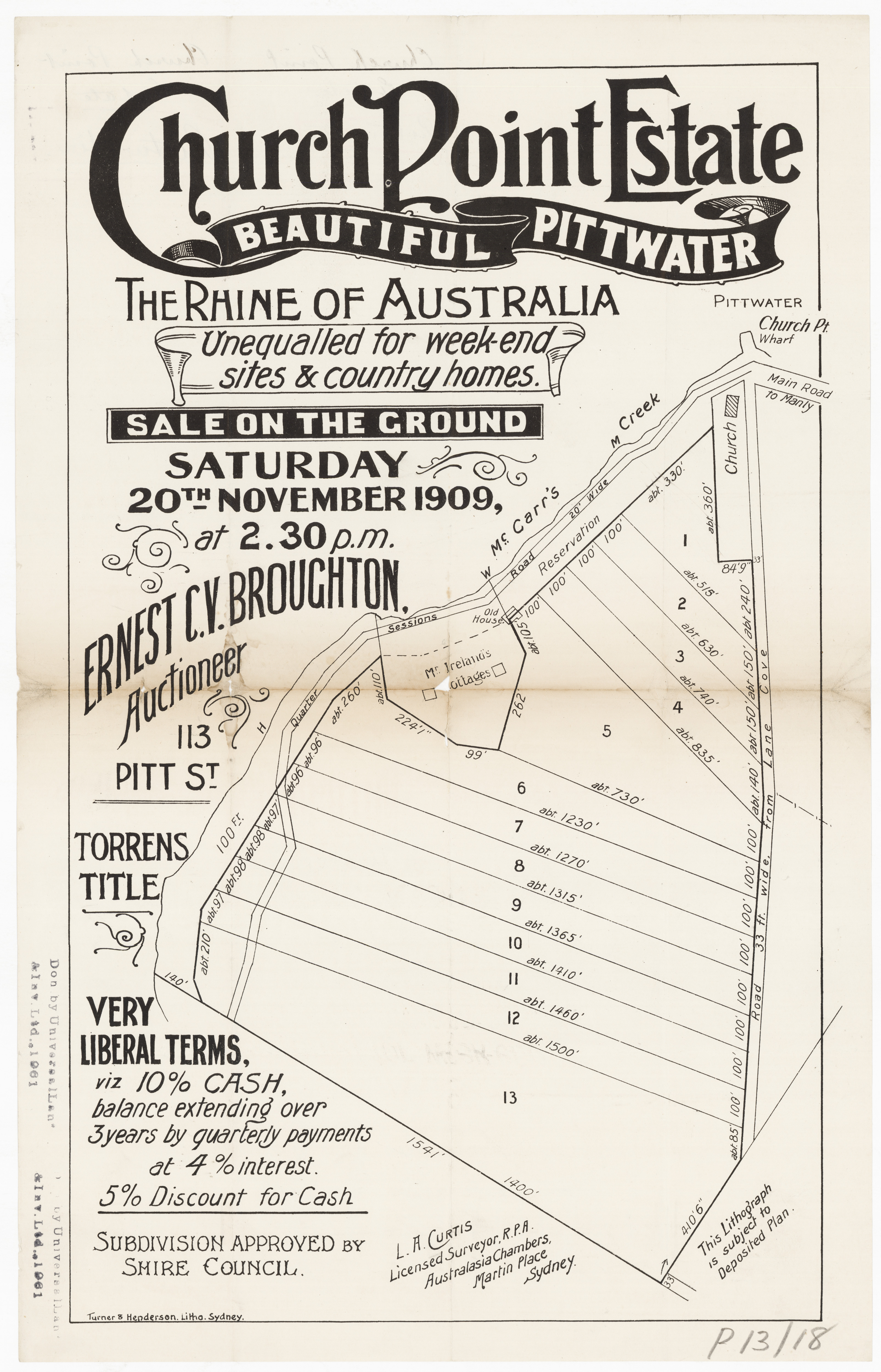
Church Point Estate - Dr. Tibbits holding; shows position of 'old house' - Item: c053460018, from Pittwater Subdivisions folder, courtesy State Library of NSW
BEAUTIFUL PITTWATER. CHURCH POINT ESTATE. THE WEEK-ENDER'S PARADISE.
ENTRANCING VIEW'S, with a scope of 100 miles of Smooth-water Navigation, suitable for MOTOR LAUNCHES and AQUATIC PLEASURE-SEEKERS.
Highly Recommended by the Medical Profession for a Week-end Rest.
AT THE CHURCH POINT WHARF, AND THE TERMINUS OF THE COACHES FROM MANLY. IN LARGE AREAS OF ABOUT THREE ACRES EACH.
Well known as the Property of the late Dr. Tibbitts. General Store and Post-office adjoining the Estate. N.B.-This is the only Land available on the mainland, and will be Sold at Bargain Prices, so the Liberal Terms of 10 per cent, cash, Balance by 12 Quarterly Payments, interest at 4 per cent, per annum-, 5 per cent. Discount for Cash. Mr. A. M. SIMPSON, Storekeeper at Church Point, will point out the Land for Sale.
SALE ON THE GROUND SATURDAY, 20th NOVEMBER, AT 2 P.M. Advertising. (1909, November 6). The Sydney Morning Herald (NSW : 1842 - 1954), p. 22. Retrieved from http://nla.gov.au/nla.news-article15084034
Mr. Ernest C. V. Broughton reports having sold: Church Point, Pittwater, Church Point Estate lot 10, £50 ; lot 5, £80 ; lots 9 and 13. £180 : SALES REPORTED DURING THE WEEK. (1910, February 6). Sunday Times (Sydney, NSW : 1895 - 1930), p. 2. Retrieved from http://nla.gov.au/nla.news-article123834590
God's Acre at Church Point
William Oliver acreage - Vol Fol 127-210 - God's Acre for Church Point chapel, cemetery and school - note that McCarrs Creek is actually named 'McGaas creek' - also note that the Trustees sold off 38 3/4 perches or 980.0980398 square metres each to Charles Mudie of Church Point, Engineer (Vol/Fol: 5997-38) and Laurence McDonnell of Manly, Medical Practitioner, (Vol/Fol: 5978-84) McDonnell onsold to the Wright Clareville men. These two land sales thereby reduced God's Acre by 1960.1960796 square metres. There are 4046.8564224 square meters in 1 acre, so around half of the original land given:
.jpg?timestamp=1694136796654)
.jpg?timestamp=1694136829474)
.jpg?timestamp=1694136864239)
.jpg?timestamp=1694136898880)
.jpg?timestamp=1694136923613)
.jpg?timestamp=1694136959207)
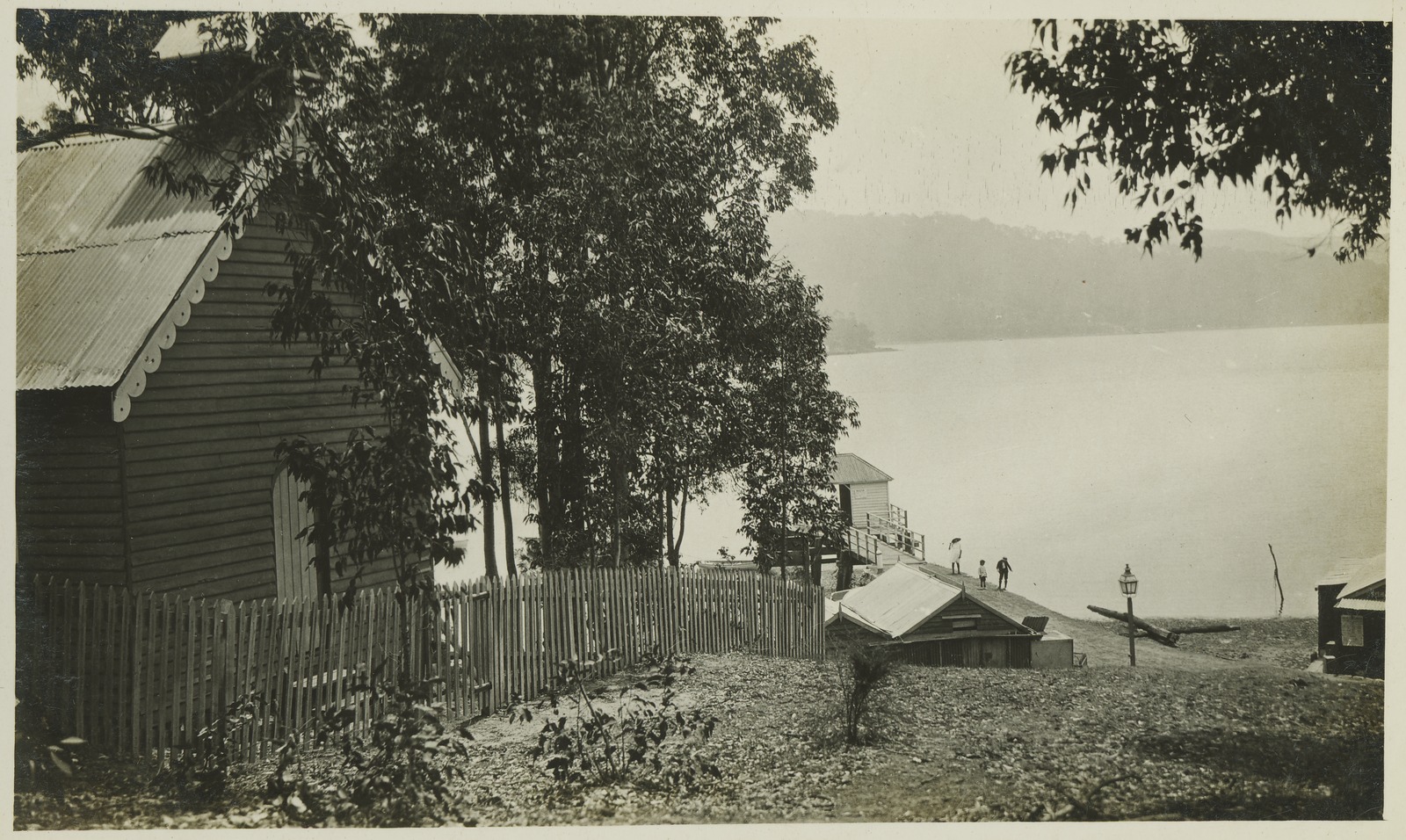
Above: 'Church Point, Pitt Water - 20 minutes from Sydney' by A. J. Vogan (Arthur James), 1859-1948, [circa. 1910 - ca. 1915]. Courtesy State Library of Victoria. Image H82.254/8/29 - showing the chapel; Church point was named for - see Methodist Church at Church Point History - 'A Church at Church Point!'
AN HISTORIC CHURCH
MEMORIES OF THE METHODIST CHAPEL AT CHURCH POINT, PITTWATER
The erection of the little Methodist Church at Pittwater was through the efforts of Mr. George McIntosh and Mr. William Henry McKeown, who conducted services at Bayview, under a tree. This prompted Mr. Wm. Oliver, an early settler of this district, to give one acre of land for 10/- to the following gentlemen, as joint tenants, as per the Certificate of Title, dated November 8, 1871:— George Mclntosh, William Oliver, James Jones, Thomas Oliver, John Alder - ton; William Baker, all following the occupation of farmers, and residing at Pittwater, and William Henry McKeown, of Lane Cove, also a farmer.
The little church was erected on this land in the year 1872 for the sum of £60, and the point derives its name from this little wooden house of worship (Church Point in many early records is spoken of as Chapel Point). In the cemetery lie many pioneers who passed away about half a century ago, and such a place enkindles in one's memory the lines of Gray's 'Elegy': —
''Each in his narrow cell for ever laid, The rude forefathers of the hamlet sleep.' The Wesleyan Minister stationed at the North Sydney circuit, Chatswood or other Church in that or Artarman locality, could only visit the church about once a quarter accounts for the burials in God's Acre being taken by the Rev. R. .S. Willis, M.A.. Incumbent of St, Matthew's Church of England, Manly, up to 1890, and therefore the records of these burials are contained in the Church of England burial register at Manly.
This church was used in the week days from May, 1884, until 1888 as a public school and known as the Pittwater Public School, under the charge of Mr. S. Morrison, who now resides at Manly. It was on July 19, 1887, that the late Sir Henry Parkes paid a visit to the school in this church building, and signed the school's visitors' book. It is to be trusted that the demolition of this church will not be proceeded with, ,but that it will be restored, and again used for public worship, as the population is growing, and the nearest church is three miles away. This will save this historic place from going into oblivion. I have approached the church authorities with the hope that something may be done at the eleventh hour; even five members of my society (the Manly, Warringah, and Pittwater Historical Society) having approached me to the effect that they are willing to spend a few Saturdays, if a conveyance can be provided, to help to restore this building.
In conclusion I wish to point out that St. John's (Church of England, Pittwater, on the headland near the 11 -mile peg, was the first house of prayer in the district, having been opened on September 21, 1871, and was referred to as follows: 'This small church was situated quite in the wilderness,, being the first erected in that part of the colony." — P.W.G. AN HISTORIC CHURCH (1930, June 6). Windsor and Richmond Gazette (NSW : 1888 - 1965), p. 10. Retrieved from http://nla.gov.au/nla.news-article85883396
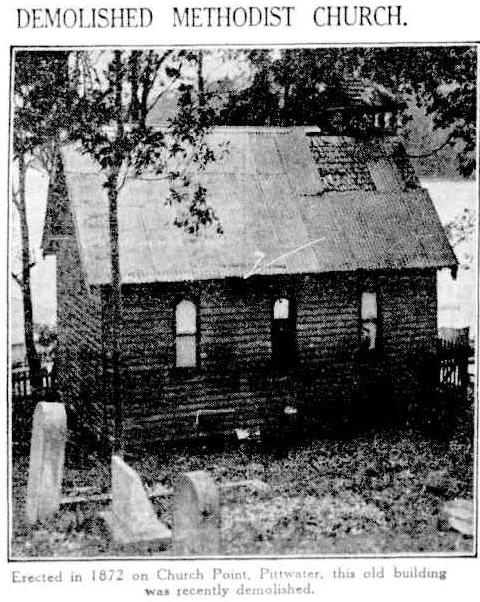
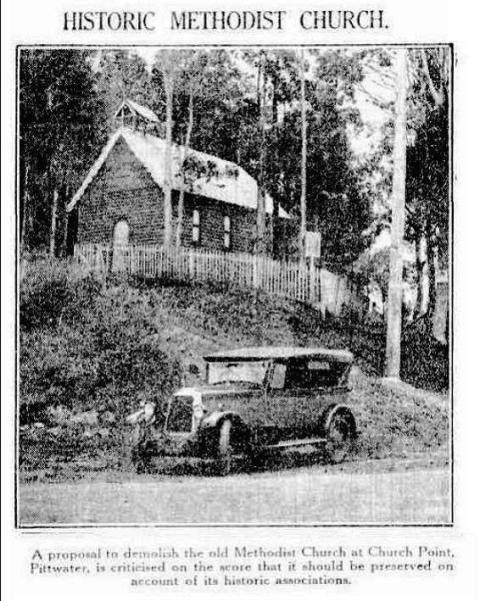
DEMOLISHED METHODIST CHURCH. Erected in 1872 on Church Point, Pittwater, this old building was recently demolished. DEMOLISHED METHODIST CHURCH. (1932, April 7). The Sydney Morning Herald (NSW : 1842 - 1954), p. 12. Retrieved from http://nla.gov.au/nla.news-article16853823
SHIRE OF WARRINGAH.
Proposed Electricity Works Special Loan, £12,500.
THE Warringah Shire Council hereby gives notice in accordance with the provisions of section 180, Local Government Act, 1919, as amended, that—
1. The Council proposes to raise a Special Loan of twelve thousand five hundred pounds (£12,500) for the purpose of carrying out works and purchasing machinery and equipment for the amplification and general improvement of its electricity supply service, its intention being to expend the money approximately as follows:—
Purchase and erection of plant for change-over of distribution voltage from 5KV
to 10KV., with switch gear 3,430
Voltage regulation equipment 2,870
Additional distribution substations 1,250
High voltage distribution mains 1,190
Low voltage distribution mains 1,300
House-service mains 2,000
Street-lighting mains and fittings 460.
Total £12,500
2. The rate of interest on the loan will be four and a quarter per centum (4 1/4%) per annum, and the loan will be issued at par.
3. It is proposed to repay the loan over a period of fifteen (15) years by equal and consecutive half-yearly instalments, each amounting to £567 15s. 3d., of principal and interest combined.
4. For or towards the purpose of paying the instalments of principal and interest mentioned above, the Council proposes to levy a loan rate of one-twentieth of a penny (l/20d.) in the £ on the unimproved capital value of all ratable land within the boundaries described in the subjoined Schedule, and to pay the remainder of the money necessary for such purpose from the trading account of its Electricity Works Trading Fund. The total unimproved capital value of all ratable lands within the boundaries described in the said Schedule is £2,943,530
5. Particulars of the proposed works and purchases and a plan of the area which will be subject to the loan rate may be inspected at the Council's office at Brookvale during the ordinary office hours.
6. Within one month from the date of the publication of this notice any number, not less than twenty-five per centum (25%) of the ratepayers affected, may petition the Council to take a poll (a) as to whether the rate payers approve of the loan, or (b) whether the loan rate shall be on the Unimproved capital value ar the improved capital value, or (-c) on both questions. The total number of ratepayers affected is 13,062.
G. H. GREEN, President. R. G. Jamieson, Shire Clerk.
Shire Hall, Brookvale, 31st May, 1939.
Schedule.
Commencing at the Pacific Ocean at the boundary between the Municipality of Manly and the Shire of Warringah; thence generally westerly to the shores of Middle Harbour at Powder Hulk Bay; thence northerly by those shores to Harvey-street; thence easterly by Harvey-street to Clontarf-street; thence northerly by CIontarf-street to the aforesaid boundary between the Municipality of Manly and the Shire of Warringah; thence returning northerly and easterly by that boundary to the western boundary of Garden Estate, d.p. 11,915; thence northerly by that ^boundary to Woodbine-street; thence northerly by Woodbine-street to the north-western corner of Panorama Estate, d.p. 13,8^1; thence easterly by the northern boundary of that estate to Bangaroo-street; thence south-easterly by Bangaroo-street to Kalaui-street; thence easterly by that street and the northern boundary of Grandview Estate, d.p. 11,497, to Water Reserve road; thence northerly by Water Reserve road to the southern boundary of parish, j>ortion 1,239; thence easterly and northerly by the southern and eastern boundaries of that portion to unnamed road; thence generally northerly by that unnamed road to the southeastern corner of parish, portion 1,481; thence northerly by the eastern boundaries of parish, portions 1,481 to 1,487 to Allambie-road; thence generally north-westerly by Allambie-road to the southern boundary of Rodborough Farms Estate, d.p. 3,392; thence easterly by the southern boundary of that estate to the south-western corner of lot 1; thence northerly by the western boundaries of that lot and of lot 18, Rodborough Farms Estate to Warringah-road; thence easterly by Warringah-road to the south-western corner of parish, portion 1,136 ; thence northerly and easterly by the western and northern boundaries of that portion to unnamed road; thence northerly by that road to the south-eastern corner of parish, portion 1,096; thence westerly by the southern boundaries of that portion and of parish, portion 1,073, to the south-western corner; thence northerly by the western boundaries of parish, portions 1,073, 1,072 and 1,071 to the southern boundary of parish, portion 1,067; thence easterly and then northerly by the southern and eastern boundaries of that portion and of parish, portion 1,065 to the southern boundary of parish, portion 1,063; thence easterly and then northerly by the southern and eastern boundaries of that portion to unnamed road; thence easterly by that unnamed road to the south-west corner of parish, portion 1,057; thence northerly by the western boundaries of that portion and of parish, portions 1,056 and 1,041, to the north-western corner; thence easterly by the northern boundaries of parish, portions 1,041 and 1,042, to the boundary of Public Reserve R. 43,408; thence generally southerly by the boundary of that reserve to the north-\Vestern corner of parish, portion 1,053; thence easterly and then southerly by the northern and eastern boundaries of that portion and of parish,, portion 1,050, to the south-eastern corner; thence across unnamed road to the northern boundary of parish, portion 1,081; thence easterly and southerly by the northern and eastern boundaries of that portion and the eastern boundary of parish, portion 1,083, to the southeastern corner; thence across4 unnamed road to the northern boundary of parish, portion 1,085; thence easterly and then southerly by the northern and eastern boundaries of that portion to the boundary of parish, portion 1,087; thence easterly and then southerly by the northern and eastern boundaries of that portion and the eastern boundary of parish, portion 1,091, to the boundary of parish, portion 1,093; thence easterly along that boundary to unnamed road; thence southerly by that unnamed road to South Creek; thence generally easterly by South Creek to Willandra-road; thence generally northerly by" Willandra-road t0 the south-western corner of South Creek Estate, d.p. 9,586; thence northerly by the western boundary of that estate to Cleveland-avenue ; thence westerly by Cleveland-avenue to the southwestern corner of Narrabeen Heights Estate, d.p. 1,818; thence northerly by the western boundaries of that estate and of parish, portion 18, to the shores of Narrabeen Lagoon; thence south-easterly by the shores of Narrabeen Lagoon to South Creek; thence southerly by that creek to Fish-road; thence easterly by Fish-road and the northern boundaries of parish, portions 661 and 660, to Dympna-.street; thence northerly by Dympna-street and the western boundary of Superb View Estate, d.p. 8,438, to Rose-avenue; thence easterly by Rose-avenue to the south-western corner of Superb View Extension Estate, d.p. 9,720; thence northerly, easterly and again northerly by the western boundary of that estate to Lantana-avenue; thence across Lantana-avenue and northerly by the western boundaries of parish, portions 577, 576, 569 and 568 to unnamed road; thence easterly by that unnamed road to Plateau-road; thence northerly by Plateau-road to the shores of Narrabeen Lagoon; thence across to the northern shores of Narrabeen Lagoon at the mouth of Deep Creek; thence generally northerly by Deep Creek to the south-western corner of parish, portion 82; thence northerly by the western boundary of that portion to its junction with part portion 80; thence westerly by the boundary of that portion to the western boundary of parish, portion 81; thence southerly and westerly by the eastern and southern boundaries of that portion to the eastern boundary of parish, portion 78; thence southerly, westerly and then northerly by the eastern, southern and western boundaries of parish, portion 78, to Lane Cove road (Gordon-road) ; thence generally easterly by Lane Cove road to the south-western corner of lot 1, Thrcepwood Estate, d.p. 13,953; thence northerly by the western boundaries of that lot and parish, portions 69 and 84, to the north-western corner; thence easterly by the northern boundaries of that portion and lot 33, Threepwood Estate, to unnamed road; thence northerly by that unnamed road to the north-western corner of parish, portion 70; thence easterly by the northern boundary of that portion to its junction with parish, portion 71; thence northerly, easterly and then southerly by the western, northern and eastern boundaries of that portion to Lane Cove road; thence generally easterly by Lane Cove road to the south-western corner of Rocklily Estate, d.p. 5,055; thence generally northerly by the western boundary of that estate to the north-western corner; thence easterly by the northern boundary of Rocklily Estate to the southeastern corner of parish, portion 42; thence generally north-westerly by the eastern boundaries of parish, portions 42 and 41, to the northern corner of portion 41; thence southerly, westerly and then northerly by the eastern, southern and western boundaries of parish, portion 72, to the road forming the southern boundary of Shaw's Estate, 3.p, 12,164; thence westerly by that road to McCarr's Creek; thence generally northerly by McCarr's Creek to Pittwater; thence generally easterly and then northerly by the shores of Pittwater to the Pacific Ocean; thence generally southerly by the high-water mark of the Pacific Ocean back to the point of commencement. SHIRE OF WARRINGAH. (1939, June 2). Government Gazette of the State of New South Wales (Sydney, NSW : 1901 - 2001), p. 2883. Retrieved from http://nla.gov.au/nla.news-article225077373
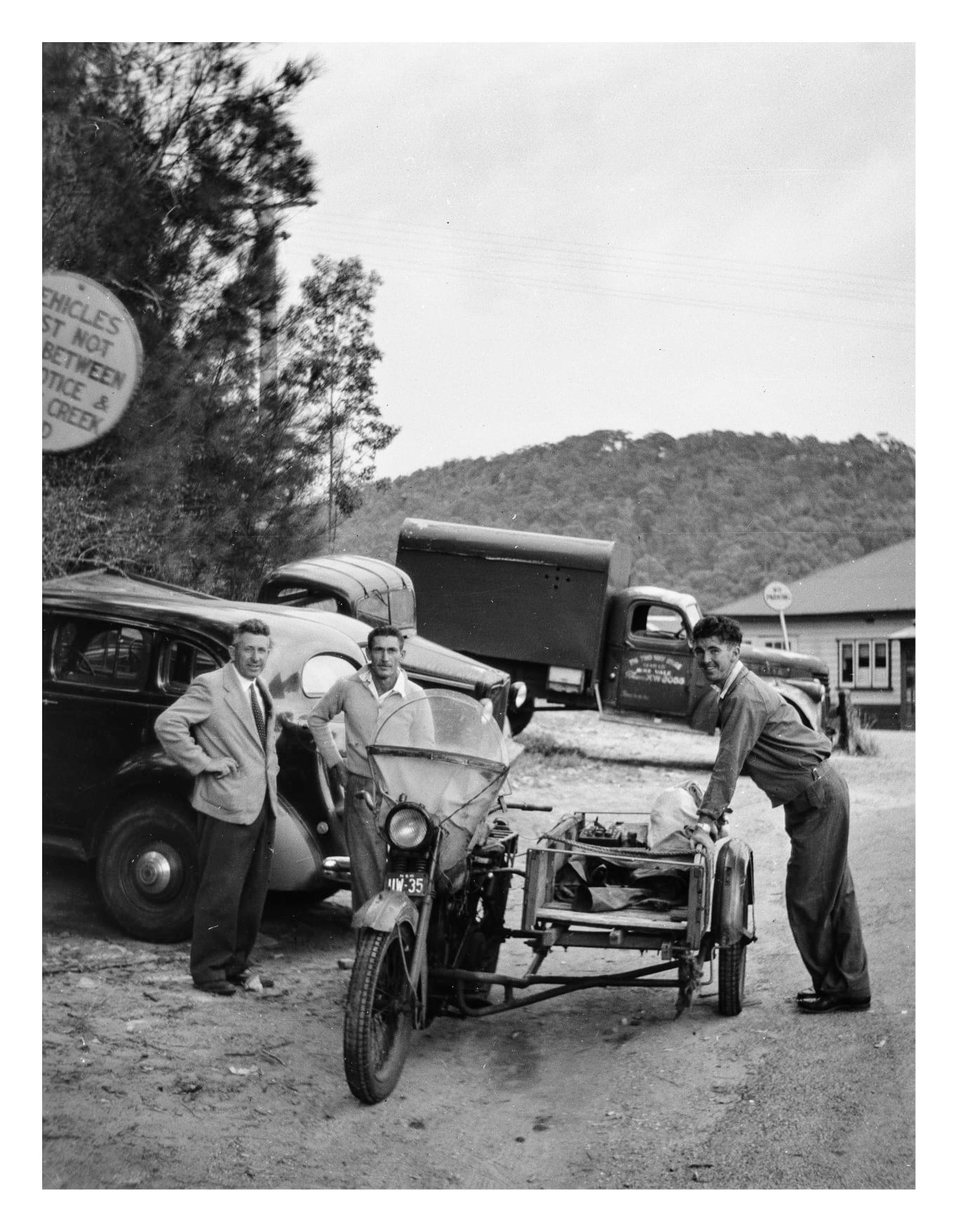
Church Point - Pittwater road (then called Bay View Road) and McCarrs Creek junction circa 1945 Photo taken by Jack Moran's Grandfather. Jack says ''Our family now runs a charter company operating out of Palm Beach. I might post some more images I find on our Instagram. So if you're interested feel free to give it a follow!'' https://www.instagram.com/taylormadeescapes
Construction Manly to Palm Beach 1938 – and a few from 1939 to demonstrate what was happening in Australia before the declaration of war:
Manly—Conversion to flats, The Crescent.—Joseland and Gilling, 17 O'Connell St., Sydney £2,000.
Warringah—Brick Club House, Jamieson St.—A. W. Edward, 26 O'Connell St., Sydney, £14,760. BUILDINGS AND WORKS APPROVED (1938, September 7). Construction (Sydney, NSW : 1938 - 1954), p. 2. Retrieved from http://nla.gov.au/nla.news-article222852790
Warringah Shire Council, Brookvale, invites tenders for the erection of a tennis pavilion at the Manly-Warringah District Park. Plans, etc., are obtainable from Architects Justelius and Frederick, 28 Martin Place. Opportunities for Business (1938, October 19). Construction (Sydney, NSW : 1938 - 1954), p. 20. Retrieved from http://nla.gov.au/nla.news-article222853204
Drummoyne.—Brick cottage, Gt. North Rd.— Mr. Browne; Metropolitan Water, Sewerage and Drainage Board (1938, July 13). Construction (Sydney, NSW : 1938 - 1954), p. 15. Retrieved from http://nla.gov.au/nla.news-article222852250
Warringah—Fibro cottage, Palm Rd.—W. Foss & Son; Additions to cottage, Plateau Rd.— Mr. Cunningham; Fibro cottage, Waterview St.—F. Drew; Additions & alterations to Newport Hotel, Barrenjoey Rd.—Paynter & Dixon Pty., Ltd., 60 Hunter St., Sydney. Metropolitan, Water, Sewerage and Drainage Board (1938, September 14). Construction (Sydney, NSW : 1938 - 1954), p. 15. Retrieved from http://nla.gov.au/nla.news-article222852900
Town Planning Association of New South Wales
On Thursday, 24th inst., the Minister for Education, the Hon. D. H. Drummond, M.L.A., will be entertained at Lunch at the Carlton Hotel, Castlereagh Street, at 1 p.m. by the Town Planning Association of N.S.W. Members and friends arc asked to advise as soon as possible (telephone XU 1506) of their intention to be present so that reservations may be made. The cost will be 3/- per head. Convention on Housing and Slum Clearance. Thursday, 1st December, is the date chosen for the Association's convention on Housing and Slum Clearance, which will be held in the Assembly Room of the Education Department Building, Loftus Street, 4th floor, at 7.30 p.m. Striking lantern slides will be shown illustrating past and present housing failures and successes. Prominent speakers and housing authorities will take part in the debate on this all-important issue. Dinner at National House. As it is proposed to hold the Association's December meeting on 1st December, a week earlier than usual, arrangements have been made for members to dine, at 1/6 per head, at National House, 30 Ash Street, at 6 p.m., returning to the Education Department Building for the Convention at 7.30 p.m.
Our Silver Jubilee.
As these events are being held to commemorate the Silver Jubilee of The Town Planning Association of N.S.W., which will complete its twenty fifth year of active work in the public interest on 17th November, all members are specially asked to attend and to bring their friends. It is very pleasing to record that after twenty-five years several of our Foundation Members, notably Mr. Justice Stephen and Mr. H. F. Halloran, are still taking an active interest and are rarely absent from our meetings. Deputation for Martin Place. Members will be advised next week of the date fixed for the deputation to Mr. A. Richardson, M.L.A. (acting on behalf of the Premier) to urge the provision of a public square in Martin Place. The Premier has been asked to include the pre posed Elizabeth Street extension in the same deputation.
Parks and Foreshores Committee:
Proposed trusts for Narrabeen Lakes and foreshores and Barrenjoey headlands.
October Meeting.
Among those present at the Association's October meeting on 13th inst., were the President, Mr. Bertram Ford, Messrs. J. D. Walker, H. F. Halloran, R. Cook, J. Menzies, A. J. Small, J. Downes, A. D. Carson, A. H. Edmonds, A. J. G. Simpson, R. J. Fitzgerald, W. Ford, C. H. Gardiner, and Mesdames B. W. Ford, N. Townshend and I. F. Bradley.
Election of Council: Mrs. F. E. Kenna was elected a member of the Council of the Association.
Harbour Bridge Tolls.
It was resolved that the Premier be asked to reduce the Harbour Bridge tolls on motor transport by one-third. Mrs. Townshend Welcomed. The President extended a welcome to Mrs. Townshend, who had been absent from recent meetings through ill health.
Safety Fence for Spit Bridge.
In view of the danger to motor vehicles crossing the Spit Bridge it was decided that the main Roads Board be asked to substitute a wire safety fence for the existing picket fence on the Southern side of the Spit Bridge. Balgowlah-Brookvale Main Road.
It was resolved that the Main Roads Board be asked to expedite the completion of the section of the main road extending Condamine Street in a direct line from Gordon Road across Curl' Curl Creek to the intersection of Kentwell Road and old Pittwater Road.
Circular Quay Replanning.
It was resolved that a letter be sent to the Premier protesting against any final decision on the replanning of the Circular Quay area until he had received the promised deputation from representatives of the bodies which met him in May last.
Ocean Foreshore Park,
The Warringah Council will be asked to investigate the possibility of acquiring for park purposes a strip of ocean foreshore at Narrabeen extending north from Ocean Street. This would also preserve the ocean view from the coastal scenic road.
Iron Cove Bridge.
It was decided to support a request to replace the Iron Cove Bridge with a modern structure and to investigate an improved route from the north-western suburbs to the city.
Bridge From Balmain.
It was resolved to ask the Minister for Works to take into consideration the possibility of a high level bridge from Balmain to Observatory Hill in connection with any proposed replanning of Observatory Hill. Town Planning Association of New South Wales (1938, November 2). Construction (Sydney, NSW : 1938 - 1954), p. 8. Retrieved from http://nla.gov.au/nla.news-article222853365
SHOPS.
Harbord—Brick additions and alterations to shops, Oliver Road.—Mrs. L. Christianson, Owner; A. Carter, 30 Hill St., Manly, Builder; £1400. MISCELLANEOUS.
Balgowlah—2 brick flats, Balgowlah Rd.—J. H. Brown, 47 Daintry St., Manly, Owner/Builder; £1300. Manly—2 flats, Fairlight St.—N. A. Dawson, Fairlight St., Manly, Owner/Builder; £1600. Maroubra—-Church, Maroubra Bay Road.—Rev. Father Fitspatrick, Presbytery, Maroubra, Owner; £10,000. North Manly—Brick club house, cnr. Pittwater Rd. and Condamine St.—Manly District Tennis Association, 1 Belgrave St., Manly, Owners; J. Pettigrew, 81 Mcintosh St., Gordon, Builder; £1785. North Sydney—Alterations to hotel, Pacific Highway.—Tooth & Co., Broadway, Sydney, Owners; Alex Maston, 14 Spring St., Sydney, Builder.
COTTAGES.
Avalon—Fibro dwelling, Central St.—G. Hicks, Owner; N. Lipscombe, Careel Bay, Builder; £500. Avalon ; —Fibro dwelling, Edwin Ave.—Mrs. M. Hall, Owner; J. L. Jones, Avalon Beach, Builder; £211. Avalon—Fibro dwelling, Paradise Ave.—G. N. Laycock, Owner; T. Chegwyn, Avalon, Builder; £1000. Balgowlah—Brick dwelling, Kareema St.—A. A. Lee, 77 Benelong St., Cremorne, Owner; A. Lee, 77 Benelong St., Cremorne, Builder; £1100. Brookvale—Fibro dwelling, Shackel Ave.-—-Mrs. L. Gray, Owner; A. Carter, 57 Boyle St., Balgowlah, Builder; £500. Brookvale-—W.B. and fibro dwelling, Brookvale Ave.—N. Florimo, Owner; C. Moon, Mitchell Road, Brookvale, Builder; £250.
Curl Curl—Fibro dwelling, Pitt Road—Mrs. F. G. Johansson, Owner; L. Waugmann, 30 Darling St., Chatswood, Builder; £350. Deewhy—W.B. and fibro dwelling, Banksia St.— P. Goodwin, 8 Hamilton Crescent, Ryde, Owner; £200. Deewhy—Fibro dwelling, Headland Road.—M. Moore, 41 Pacific Pde., Deewhy, Owner; £575. Earlwood—Brick cottage, Francis St.—A. C. Gorman, Owner; C. O. Gorman, 30 River Street, Earlwood, Builder; £750. Harbord—Brick dwelling, Harbord Road.—C. Leonard, Owner; J. A. Carter, 30 Hill St., Manly, Builder; £680.
Manly Vale—W.B. dwelling, Laurie Road.—W. Loughman, Owner; J. Williams, Deewhy, Builder; £400.
Mona Vale—W.B. and fibro dwelling, Elvina Ave. —Mrs. L. C. Hurley, Owner; T. Lockhard, Ocean Ave., Newport, Builder: £600. Mona Vale—Fibro dwelling, Waratah St.—H. Johnson, Bayview Road, Mona Vale, Owner; £400.
Mosman—Dwelling, Sirius Cove Road.—W. M. Shaw, 3 Sirius Cove Road, Mosman, Owner; J. Shaw, 3 Sirius Cove Rd., Mosman, Builder; £1250. Mosman—1 pair semi-detached, Countess Street.— J. Lister, Countess St., Mosman, Owner; E. E. Delfendahl, Bay 'St., Mosman, Builder; £1200. Mosman—Dwelling and garage, Bapaume Road.— J. G. and G. A. Jeffrey, 29 Raglan St., Mosman, Owners: L. J. Wangmann, 30 Darling St., Chatswood, Builder; £1700.
Narrabeen—Fibro dwelling, Gondola Road.—Mrs. J. Sherwood, c/-P.O., Cabramatta, Owner; £400. Narrabeen—Fibro dwelling, Wimbledon Ave.— Mrs. L. I. Porter, 26 Hastings Pde., Bondi North, Owner; £800.
North Manly—W.B. dwelling, Kentwell Road.— Homes Unemployed Trust, Phillip St., Sydney, Owners; £200. North Manly—Brick dwelling, Riverview Parade.— J. Purser, Barrenjoey Road, Palm Beach, Owner/ Builder; £700. Parramatta—W.B. and fibro cottage, Early St.—E. Fortune, Owner.
Seaforth—Brick dwelling,' Seaforth Crescent.—E. T. and F. I. Lergessner, Rosebcry St., Mosman, Owners; - Jay's Bungalow Plans Co., 12 Wentworth St., Manly, Builders; £950. Seaforth—Brick dwelling, Princes Promenade.— Mr. and Mrs. Collins, 1 Cork Road, Marrickville, Owners; F. H. Collins, 1 Cork Road, Marrickville, Builder; £900. Seaforth—Brick dwelling, Ellery Ave.—H. Jory, Peacock St., Seaforth, Owner; H. A. Ransom, Radio Ave. and Abbott St., Balgowlah, Builders; £1000.
ALTERATIONS AND ADDITIONS.
Balgowlah—Additions, Wanganella St.—J. Schuback, Wanganella St., Balgowlah, Owner; S. Dealtry, 51 Barker St., Strathfield, Builder; £187. Balgowlah—Additions, Kitchener St.—]. L. Lister, Pittwater Rd., Harbord, Owner/Builder: £120. Brookvale—Additions to W.B. dwelling.—W. F. Leonard, 22 Fisher Rd., Deewhy, Owner/Builder; £220. Burwood—Additions, Fitzroy St.—F. Smith, 76 Fitsroy St., Burwood, Collaroy—Alterations to dwelling, Florence Ave.— Mrs. E. Collins, Owner; W. B. Chequer, 7 Jamieson Pde., Collaroy, Builder; £60. Cremorne—Additions to residence, 15 Grassmere Rd.—F. L. Saunders, Owner. Deewhy—Alterations and additions, Richmond Ave.—Mrs. E. King, Owner; H. King, 19 Richmond Ave., Deewhy, Builder; £150. Earlwood—Fibro additions, Bedford St.—R. W. Webber, 50 Bedford St.,
BUILDINGS AND WORKS APPROVED
ALTERATIONS & ADDITIONS (continued). Harbord—Additions, Undcrciiife Road.—A. Bell, s Owner/Builder; £35. Manly—Additions, Addison Rd.—J. A. Milford, 6 Addison Rd., Manly, Owner; J. W. Tallows & Son, Dudley St., Balgowlah, Builders: £65. Narrabeen—Reconstruction, Pittwater Road.—A. R. Harwood, Baulkham Hills, Owner/Builder; £300. Neutral Bay—Alterations to residence, 12 Barry St.—Mrs. Shervine, Owner; S. C. Molineaux, 121 Pacific Highway, Roseville, Builder. Palm Beach—Additions, Palm Beach Road.—S. B. Hooper, Owner: N. Lipscombe, Careel Bay, Builder; £150.
GARAGES. Brookvale—W.B. and fibro garage, Carter Rd.— Mrs. E. Dorman, Owner; H. E. Dorman, Carter Road, Brookvale, Builder: £30. BUILDINGS AND WORKS APPROVED (1939, February 8). Construction (Sydney, NSW : 1938 - 1954), p. 2. Retrieved from http://nla.gov.au/nla.news-article222854264
Return of Building Operations entered upon in the City and Suburbs as notified to the Water Board during the week ended February 16, 1939. Some of these may have already appeared under Council News in previous issues.
Warringah—W . 1 >. and fibro collate. Lewis SI. p_ Miller; W . P. cottage, Pittwater Rd — Mr. Horwood; Fibre» cottage. Cared Rd—O. Retilund; Brick residence. King St.—O. Shannon; W.B. cottage, Laurie Rd.—\Williams; Dup. flats, Queenscliffe Rd.—K. Gravenor, 112 Kameruka Rd., Northbridge; Fibro cottage, Queens Ave.— h. Harbord; W.B. and fibro cottage, Wishbourne Rd.— Mr. Kerrigan. Metropolitan Water, Sewerage and Drainage Board (1939, February 22). Construction (Sydney, NSW : 1938 - 1954), p. 16. Retrieved from http://nla.gov.au/nla.news-article222854430
Warringah Shire Council is calling tenders for the construction of a bowling green at Newport Beach.
C. M. Graham Pty. Ltd., Bradley's Head Road, Mosman, will erect a block of twelve flats in Blue and William Streets, North Sydney, for Mr. O. A. Cropley, 4 Blue Street, North Sydney.
A brick dwelling is to be erected in Beach St., Manly, for S. W. Thomson, 20 Enmore Road, Newtown, at a cost of £1,250. The builder will be Mr. M. N. Jarrett, Eustace Street, Manly.
Messrs. Bullbrook and Sons are erecting a dwelling and garage in Military Road, Mosman, for S. D. Macdonald, 492 Military Road, Mosman.
M. R. Hornibrook Ltd. are the contractors for the construction of a large pier at Mackay, Queensland, which will shelter between the two walls of the outer harbour. The work is estimated to cost a little less than £250,000.
It is estimated that the construction of the Royal Australian Air Force aerodrome at Amberley will cost £250,000. It is expected that the aerodrome will be complete within 12 months.
The Lockhart Shire Council has decided to obtain a site for the construction of an aerodrome to serve Lockhart and district.
The Commonwealth Department of Works invites tenders for the fabrication and erection of steel work on two hangars at the R.A.A.F. Station, Darwin. War Service Homes Commission invites tenders for renovations and the installation of sewerage to cottages in various suburbs. Architect A. Ashton, 58 Margaret Street, Sydney, is preparing plans for extensive alterations to a large residence at Warringah, and for the erection of additional storey to a block of flats at Darling Point.
Architects Charles Bohringer and Associates, 58 Margaret Street, Sydney, arc preparing plans for the conversion of a residence to a private hospital at Beecroft and for the reconstruction of a theatre at Hurstville.
Plans are being prepared by architect Hedley Carr, 26 O'Connell Street, Sydney, for the erection of residences at Parriwi Road, Mosman, and in Weemala Avenue, Pennant Hills. Opportunities for Business (1939, March 22). Construction (Sydney, NSW : 1938 - 1954), p. 20. Retrieved from http://nla.gov.au/nla.news-article222854691
The tender of F. C. W. Powell & Sons has been accepted for the erection of a new wing at the National Library at a cost of £151,900.
Warringah Shire has a £54,000 programme of works which includes road, foot-path and gutter construction, also the remodelling of dressing-sheds at Collaroy Beach.
Tenders close on April 27th at 74 Lagoon Street, Narrabeen, for the erection of shops and dwellings at the tram terminus, Narrabeen. A block of two flats are to be erected in Karecma Street, Balgowlah, by W. J. Arnold, 36 Shirley Road, Wollstonecraft, at an expenditure of £2000. Two flats are to be erected by R. Miles, builder, of Old Pittwater Road, Brookvale. The flats will be built in Birkley Road, Manly, at a cost of £1600. J. Burrows, 31 Earle Street, Neutral Bay, will erect a block of three flats in Premier Street, Neutral Bay. Architect C. A. Christian, 77 Elizabeth Street, Sydney, is calling tenders for the erection of a block of six flats at Cremorne. Damage caused by a fire to the wharf at Papeete, Tahiti, is estimated at £100,000. Tenders are being called for the erection of a fibro cottage at Carramar. Plans at Mr. Beckhaus, Quest Avenue, Carramar. A sum of £3000 has been expended on improvements to the Cessnock aerodrome. A tender of £6309 has been accepted for excavations for the Royal Melbourne Hospital at Parkville. The tender was submitted by the Star Haulage Co. Pty. Ltd., of Flemington. A new wing is to be added to the weather bureau at Melbourne. The extensions will cost approximately £11,600. C. Glancey, architect, 9 Bligh Street, Sydney, is calling tenders for the erection of new classrooms at St. Mary's Convent, Wollongong. H. Piatt and J. L. Buchanan, Consulting Engineers, 60 Hunter Street, Sydney, are calling tenders for the manufacture, supply and delivery at Launceston of approximately 26,000 sq. ft. of insulating corkboard. T. W. Hodgson & Sons, Architects, 28 Martin Place, Sydney, are calling tenders for the erection of 2 flats in Pittwater Road, Collaroy. Opportunities for Business (1939, April 19). Construction (Sydney, NSW : 1938 - 1954), p. 20. Retrieved from http://nla.gov.au/nla.news-article222854928
NEW MANLY WHARF.
After months of negotiation a start has been made in providing Manly with a new ferry wharf, and the Amusement Pier next to the existing wharf is being cleared and re-decked for use by passengers while the new wharf is being constructed. A conference to discuss the wharf and other local transport matters will be held in the Manly Council Chambers on June 29th. It will be attended by representatives of the Maritime Services Board, the Port Jackson & Manly Steamship Co., the Road Transport Department, the Main Roads Department, the Police, and the Manly and Warringah Councils. NEW MANLY WHARF. (1939, June 21). Construction (Sydney, NSW : 1938 - 1954), p. 5. Retrieved from http://nla.gov.au/nla.news-article222855557
Meanwhile in Church Point, in 2023:
'Longa Linga' At Church Point - The John Lander Browne Pre-WWII Designed Linear Home For An Aunt - threads collected and collated by A J Guesdon, 2023.
